Posts Tagged ‘Tasmania’
Sunday, April 13th, 2014
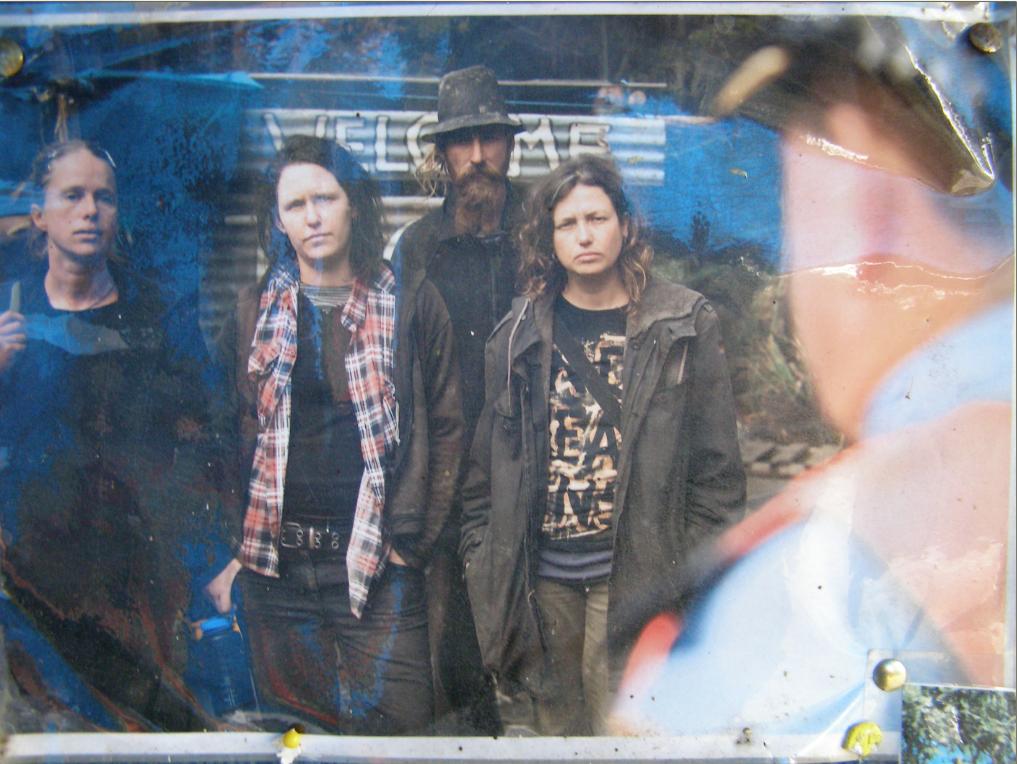 For the cause and their honour
Camp Flozza remembered For the cause and their honour
Camp Flozza remembered
.
New Tasmanian Premier Will Hodgman believes in a headline sense of “economic renewal” somehow and that his vote to power provides a Viking Mandate for him to ecologically ‘rape pillage and plunder’ Tasmania’s natural resources.
With the business community on side, the minerals council, the housing industry association, the developers, the loggers, everything is up for grabs, especially Tasmania’s old growth forests.
Logging trucks are already crossing back over Bass Strait from exile in parochial log state Queensland.
Here we go again…
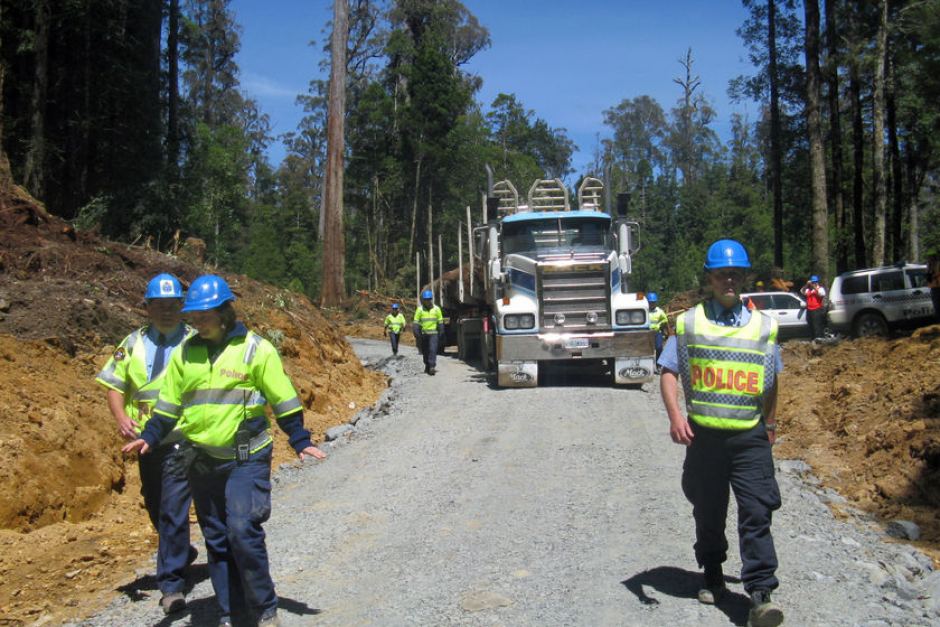 Tasmanian police escort a log truck out of the Upper Florentine Valley after a week of protests, January 2009.
[Source: ‘Protests have failed to stop the log trucks’, 20090121, ABC News,
^http://www.abc.net.au/news/2009-01-21/tasmanian-police-escort-a-log-truck-out-of-the/273180] Tasmanian police escort a log truck out of the Upper Florentine Valley after a week of protests, January 2009.
[Source: ‘Protests have failed to stop the log trucks’, 20090121, ABC News,
^http://www.abc.net.au/news/2009-01-21/tasmanian-police-escort-a-log-truck-out-of-the/273180]
.
“We are going to embrace a new way of doing things in this state,” Mr Hodgman said.
Scary. What does he mean by that?
Not one for mature mediation, ham-fisted Hodgman is determined to tear up the $273 million ‘Tasmanian Forest Agreement‘ in what he has off-handedly vilified as a “job-destroying forest deal.” “It only threatened to lock away forever future productive forest.”
But how many Tasmanian loggers got paid out by Canberra’s $273 million Will? How much of that $273 million is left? Are you endorsing two-timing loggers – those paid out and now in for second crack?
So the hated 19th Century wood chip pulp mill is back on the table, with no prospect of profit, just a ‘work-for-the-dole’ scheme for crusted-on loggers.
But Hodgman, like Groom and Rundle before him, is sure short-term market conditions for woodchips will improve. Six hundred year old forests are renewable anyway Will reckons. Will says he has a mandate to follow through on the divisive election promise. “More wood equals more jobs” and “our plan focuses on growing the industry … not appeasing environmentalists.”
Dem’s fightin’ words indeed!
“I can’t do this on my own with these. . . people.”
Hodgman’s heavies are regrouping and more police are being recruited and resourced. Hodgman is prepared for Forest War on the belief he has the endorsement of high-T Tasmanians.
“We will not allow the past to drag us down and stop us from moving ahead. We understand where we should move.” ~ Vladimir Putin.
 . .
[Sources: ‘Premier claims Tasmania in period of economic renewal since Liberals seize power’, by Lucy Shannon, 20140407, ABC News, ^http://www.abc.net.au/news/2014-04-06/premier-claims-tasmania-has-entered-a-period-of-economic-renewa/5370640; ‘Tasmania’s forest agreement to be ‘torn-up’’, 20140410, ^http://www.enviroinfo.com.au/tasmanias-forest-agreement-to-be-torn-up/]
.
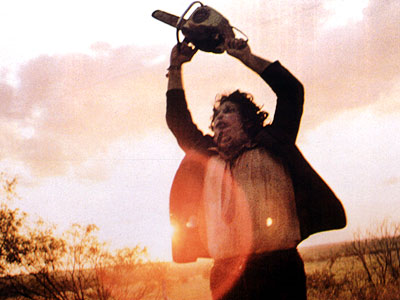 Does young Will mean blood? Does young Will mean blood?
.
Rally to Defend Tasmania’s World Heritage in the Upper Florentine!
.
When: Sunday, 27 April 2014
Time: 12 noon for 12:30pm start
Where: Camp Flozza, In Tasmania’s magnificent Florentine Valley World Heritage Area, Gordon River Road, 21 km east of Maydena
(From Maydena drive along Gordon River Road, heading towards Lake Pedder. On the right, 3.3 km from the Thumbs Lookout, there will be signs for rally).
.
Tasmanians and Australians this is your time!
The Bob Brown Foundation is hosting a rally in World Heritage listed forests of the Upper Florentine, Tasmania, in response to the Australian Government’s intention to remove 74,000 ha from the Tasmanian Wilderness World Heritage Area.
Speakers include Senator Christine Milne – Leader of the Australian Greens, Peg Putt – CEO of Markets for Change and Miranda Gibson – spokesperson for Still Wild Still Threatened.
Bob Brown Foundation Campaign Manager Jenny Weber said, “Tasmania’s globally significant World Heritage Area is gravely threatened by the Australian Government’s request to the World Heritage Committee to remove 74,000ha of forests from World Heritage listing. We are receiving huge support from members of the public who are coming along to this rally, people who love these forests and don’t want to see the listing stripped from forests which have outstanding universal values.”
“We will stand together in the magnificent World Heritage listed Upper Florentine forests to support the world heritage convention and call for protection of Tasmania’s Wilderness World Heritage Area and the maintenance of the current boundary. Standing together among the ancient tall eucalyptus forests, we will prove that the Australian Government is wrong in claiming that it is logged and degraded,” Jenny Weber said.
“The Upper Florentine is pristine. This entire region is proposed for removal from the World Heritage Area, though it is a perfect contradiction of the Liberal Government’s claims that these 74,000 ha are logged or degraded. The Upper Florentine is an extensive area of pristine tall eucalypt forest, part of a corridor of tall eucalyptus forests from the far south to the central west of Tasmania, recognised as World Heritage in 2013. This intact region of ancient forest is again under threat by the Australian Government’s proposal to remove these magnificent intact forests for logging,” Jenny Weber said.
World Heritage Campaign Manager
The Bob Brown Foundation
[Source: ^http://www.bobbrown.org.au/rally_to_defend_world_heritage]

.
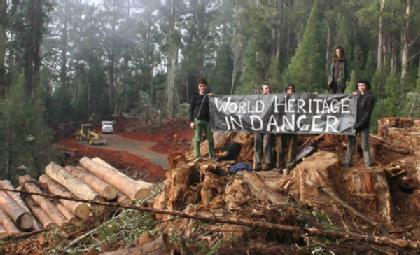 Sacred Upper Florentine Valley being logged only a few years ago Sacred Upper Florentine Valley being logged only a few years ago
.
For Tasmanians, Tasmania is all we’ve got.
.
Tags: Bob Brown, Camp Flozza, economic renewal, Forest War, Forestry Tasmania, loggers, logging trucks, Pulp Mill, Tasmania, Tasmania Police State, Tasmania’s World Heritage, Tasmanian Forest Agreement, Tasmanian Police, Upper Florentine Forest, Upper Florentine Valley, Viking Mandate, Will Hodgman, wood chip
Posted in Tasmania (AU), Threats from Deforestation, Threats to Wild Tasmania | 1 Comment »
Add this post to Del.icio.us - Digg
Monday, September 23rd, 2013
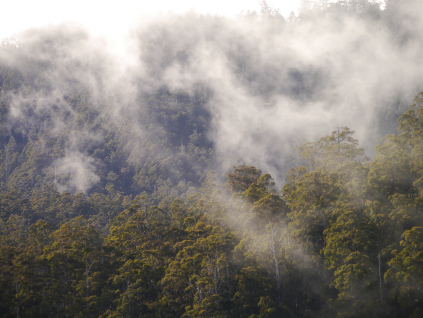 In Tasmania, pristine remains defenceless
In Tasmania, pristine remains defenceless
.
Hope from 2013:
.
“Today I think of the Wedge-tailed Eagle that I watched fly above my tree, whose habitat was once under threat and is now protected and of the Tasmanian Devils who lived in the forest 60 metres below my platform who can now raise their young in peace.”
.
~ Miranda Gibson, The Observer Tree, Tasmania, ‘National student movement stands up for Tasmania’s native forests’, 20130710,
^http://observertree.org/2013/07/10/media-release-national-student-movement-stands-up-for-tasmanias-native-forests/]
.
Recalling the STIHL nightmare from 1982:
.
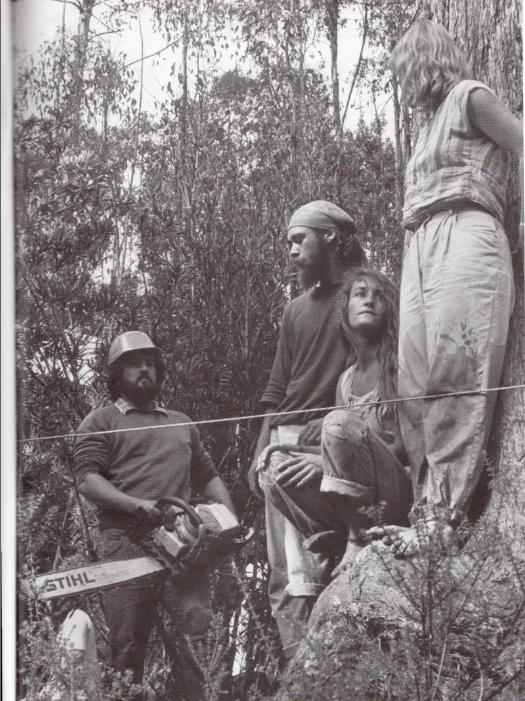 Tasmania’s Farmhouse Creek Conservation Blockade of 1982: the people’s forest stance against industrial ecocide. Moral courage in the face of adversity – it resonates with the robust spirit of our brave young people. Lest we forget our young folk’s personal exposure to Corporate Logger Bully Violence, personal sacrifice and its haunting trauma. Tasmania’s Farmhouse Creek Conservation Blockade of 1982: the people’s forest stance against industrial ecocide. Moral courage in the face of adversity – it resonates with the robust spirit of our brave young people. Lest we forget our young folk’s personal exposure to Corporate Logger Bully Violence, personal sacrifice and its haunting trauma.
[Source: ‘For the Forests – A history of the Tasmanian Forests Campaigns’, 2001, book by Helen Gee and Janet Fenton, The Wilderness Society, Hobart, Tasmania]
.
From 2001:
.
<< In a world in which the tropical forests are disappearing and oldgrowth forests are threatened everywhere, global biodiversity is declining at an alarming rate. Australia can no longer afford to destroy oldgrowth forests. They are a priceless resource. Few of our tall forests of any type remain in pristine condition,and particularly where they have not been degraded they should be protected. The practice of destroying oldgrowth forests in order to replace it with plantations is criminal vandalism. Plantations should only be established on already degraded land.
Tasmania has the tallest forests in the Southern Hemisphere, some of the greatest areas of pristine temporate Gondwanan rainforest found anywhere on Earth, and some of the world’s oldest trees. This makes it a Mecca for tourists as forests disappear elsewhere. Because Tasmania is the State with the most forest – 40% of area forested – and because the quite erroneous view prevails that forests regenerate completely after clearfelling, a shameful attitude to forest conservation exists at the highest level in bureaucracies.
The Island is being torn apart by the woodchip-at-any-cost mentality. The forests are being sold off at a loss. The royalties paid by private companies fall far short of covering the cost of forest management, regrowth and infrastructure. Job losses attributable to woodchipping were estimated at 4,000 by 1995 – refuting the contention that the industry is good for employment. The Government, for sake of keeping a few foresters in work for a few years does not have the fortitude to stop the destruction. >>
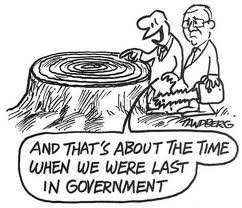
<< Gondwanan forest, in its complex rainforest and wet scherophyll expression, does not regenerate to form its original mixture. The complex web of life that it comprises, the extraordinary antiquity and grandeur of its thousands-of-years-old giant components, and the untold interactions betwen its macroscopic and microscopic plant and animal species and soil biota, make it a living entity – ‘a surviving dinosaur deserving of complete protection’.
Over 70% of forests logged are clearfelled in Tasmania, destroying habitats and most of the wildlife they support. Replacement plantations and regenerated areas cannot provide the range of habitats or the biota. Over 90% of the timber extracted from natural forests is woodchipped and only five percent ends up as sawn timber. (An estimated five million cuibic metres of woodchips a year are sold, mainly to Japan). The common practice of burning ‘waste’ in felled coupes, a scorched earth policy, results in total slaughter of small animals and organisms, many of which are little known or understood. >>
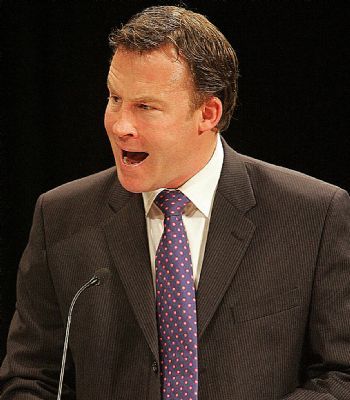 Dark Forces Regrouping
Will Hodgman’s 20th Century ignorant wrath
..against everything naturally Tasmanian Dark Forces Regrouping
Will Hodgman’s 20th Century ignorant wrath
..against everything naturally Tasmanian
.
<< Even at the start of a new millenium, logging operations are penetrating into more of the untouched valleys. Forests of World Heritage value are being destroyed and the integrity of the World Heritage protected areas themselves is being compromised. The damaging effect of logging operations, and particularly the clearfelling, on streams and on the hydrology of catchments, and on soils, is never taken into account and is a serious consequence. The brave people who have spoken out, risked their lives and faced arrest at peaceful direct actions around the Island, need your support. Every Australian who appreciates the heritage values of our forests and wants future generations to experience them, can learn what is at stake here and support the campaigns that are ongoing. >>

~ Mary E White DSc
[Source: Forward by Mary E White in book by Helen Gee (b.1950) and Janet Fenton: ‘For the Forests – A history of the Tasmanian Forests Campaigns’, 2001, published by The Wilderness Society, Hobart, Tasmania]
.
.
Further Reading:
.
[1] Helen Gee’s 2001 book ‘For the Forests: A History of the Tasmanian Forest Campaigns‘, (with Janet Fenton) published by The Wilderness Society, Inc. [^Read More]
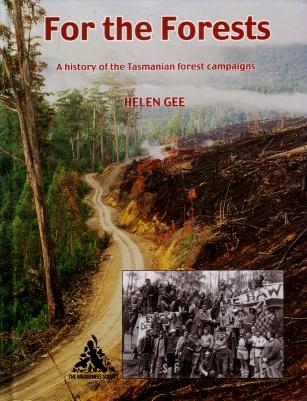
.
‘Oral history of the Tasmanian forest campaigns. Compilation of over 100 interviews of artists and activists, politicians and environmentalists such as Senator Bob Brown and Alec Marr, Campaign Director of the Wilderness Society. Chronicles strategies, protest marches, and achievements of campaigns. Foreword by palaeobotanist Mary E White. Copiously illustrated, includes appendices, maps, chronology, bibliography and index. Author is a Tasmanian writer and environmentalist, writer of ‘The South West Book: A Tasmanian Wilderness’.’
.
[2] Extracts of an interview Dr Mary White in 2003 by Amy Heague (Focus Magazine), ^http://focusmag.com.au/mgl/interviews/dr-mary-white-paleobotanist
.
<< When Dr Mary White moved to the Manning Valley (New South Wales mid-north coast) back in 2003, the area acquired a true visionary and pioneer in the world of Paleobotany and environmental conservation.
Dr White has an amazing career that spans over five decades and two southern continents, is an accomplished and award winning palaeobotanist, lecturer and over the last 20 years author of several award winning books on the evolution of the Australian continent and its ecosystems. She is a passionate conservationist, was named a Member (AM) in the General Division of the Order of Australia for service to botany as a researcher through promotion of increased understanding and awareness of the natural world and just a few weeks ago was awarded the Lifetime Conservation Award from Australian Geographic.>>
.
Interviewer: You came to Australia in 1955. Tell us about your first encounter with Australian plant life.
Dr White: We docked at Fremantle and had three days to wait until we came to Sydney, so we hired a car and went to look at the sand plains and wildflowers. I was amazed at how the composition of the flora was just slightly different from what I had been finding in South Africa.
I had this questioning feeling; how had I travelled thousands of miles across the ocean to get here and yet I could recognise at a family level everything growing around me. It was the same kind of ecosystem I had just come from. So, I suddenly was confronted with the concept of Gondwana and believed it totally.
.
Interviewer: What prompted you to purchase Falls Retreat at Johns River at the base of Middle Brother in 2003?
Dr White: I wanted somewhere I could covenant the land to maintain biodiversity and develop as an environmental education centre. It is in a wonderful part of the world and well worth protecting. Since we’ve done all the plant, animal, bird, bat and frog lists and what not, we have realised that the biodiversity here is much, much richer than we ever thought it was going to be. We have even found a couple of rare and endangered frogs.
I am now very much into climate change and have a very important message to send, which is hopefully what I have been concentrating on doing and intend to do for the rest of my life. I decided a long time ago I was going to die at a 107, so I have a few good years left in me yet – so be warned! >>
.
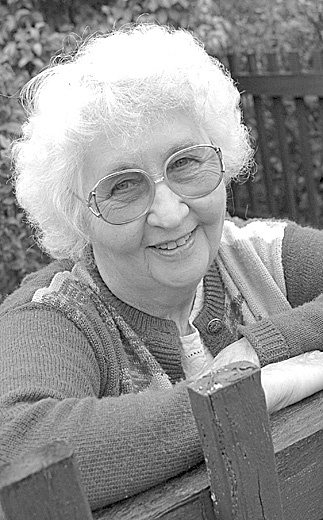 Dr Mary White – Paleobotanist, curator, author
(b.1926 in then Southern Rhodesia) Dr Mary White – Paleobotanist, curator, author
(b.1926 in then Southern Rhodesia)
.
<<..original ecosystems must be preserved because they are complete and have all the interconnections. “Ultimately you need to understand that this is a living planet and it behaves like a huge super organism, and that everything is interconnected and interrelated.”>>
[Source: ‘Dr Mary White Moves On’, 20130806, ABC NSW Mid North Coast, by Carla Mascarenhas, ^http://www.abc.net.au/local/stories/2013/08/06/3819380.htm]
.
Sunday, August 4th, 2013
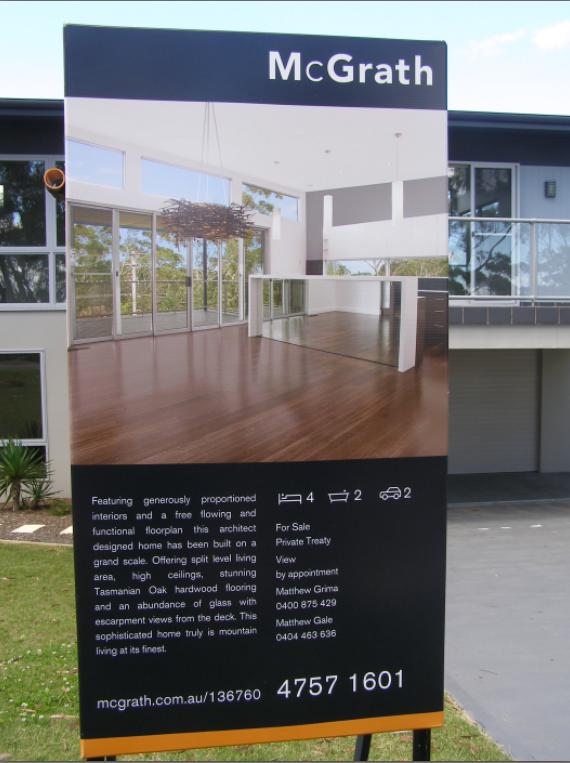 New house for sale on the Blue Mountains Escarpment
featuring “Tasmanian Oak hardwood flooring” as a key selling point.
[Photo by Editor, 20120111, Photo © under ^Creative Commons] New house for sale on the Blue Mountains Escarpment
featuring “Tasmanian Oak hardwood flooring” as a key selling point.
[Photo by Editor, 20120111, Photo © under ^Creative Commons]
.
Tasmanian Oak, which is typically abbreviated as Tassie Oak, does not exist as a real tree, but as a contrived timber flooring brand marketed to household consumers by the timber industry.
The trees sourced to produce Tassie Oak Flooring are from old growth Tasmanian native forests that are either Eucalyptus delegatensis (Alpine Ash), or Eucalyptus obliqua (Stringybark or Messmate) or else Eucalyptus regnans (Mountain Ash or Swamp Gum).
Eucalyptus Regnans is the largest flowering plant and hardwood tree in the world. Historically, it has been known to attain heights over 100 meters (330 ft) and is one of the highest tree species in the world. The tallest measured living specimen, named Centurion, stands 99.6 meters tall in Tasmania.
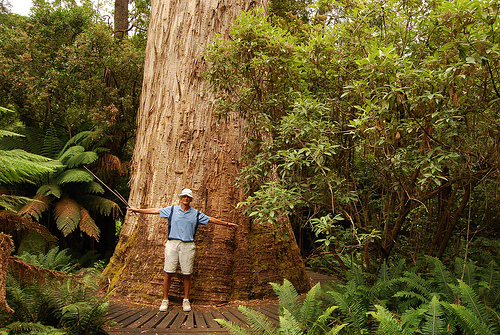 Eucalyptus regnans
before becoming someone’s Tassie Oak floor
Eucalyptus regnans
before becoming someone’s Tassie Oak floor
.
Tasmania is well known to travellers looking for pristine beauty and unspoiled wilderness. Besides unique flora and fauna including the endangered Tasmanian Devil, it is also home to the giant Eucalyptus. Tasmanian Tourism is all about marketing spin hiding the clearfelled old growth just out of sight of the tourist road. Visit Mount Field and wonder over the majesty of the old growth, but dare not venture beyond to the tragic scale of wanton clearfell.
The reality is that Australian Forestry Standard (AFS) “Chain of Custody” eco-label is an exploitative con by the timber industry.
On Forestry Tasmania’s website ‘Island Specialty Timbers’ at Geeveston claims to be a licensed Chain of Custody member, FTT CoC 08005, “which is your guarantee that all our raw material and products are Tasmanian fine timbers sourced from forests whose management is certified to the Australian Forestry Standard”.
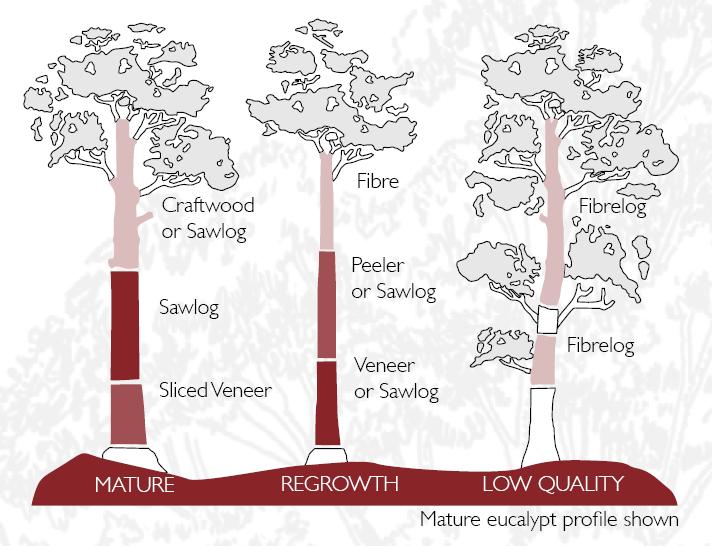 Only ‘sawlog’ sections of MATURE large hardwood trees are suitable for flooring
If there are no branch knots in the timber, then the timber has come from the trunks of mature large hardwood trees.
Such trees are not from plantations, but from rare and disappearing forest habitat.
Only ‘sawlog’ sections of MATURE large hardwood trees are suitable for flooring
If there are no branch knots in the timber, then the timber has come from the trunks of mature large hardwood trees.
Such trees are not from plantations, but from rare and disappearing forest habitat.
Forestry Standard AS 2796 ‘Sawn and Milled Native Hardwoods’ is the driving force for logging old growth habitat.
.
The supplier ‘Fine Timber Tasmania Inc.’ sells Tasmanian Myrtle (Myrtle Beech), Southern Sassafras, Leatherwood, Cheesewood, Musk, Blackwood, Eucalypt Burl, Figured Eucalypt, Huon pine, Celery Top Pine and King Billy Pine as ‘certified’.
The products of these ancient tree species are timber beams, posts, slabs and even raw logs – which simply can only come from old growth Tasmanian native forests.
Certification is AFS (Australian Forestry Standard) which has two separate standards
- Sustainable Forest Management (SFM) Certification – Australian Standard AS 4708
- Chain of Custody Certification (CoC) – Australian Standard AS 4707
.
The only benefit seems to be so that some developer and real estate agent can say hey your floorboards come from Tasmanian Old Growth and you are part of the problem; part of the Chain of Ecological Destruction, driving demand that sustains 20th Century Industrial Native Logging.
.
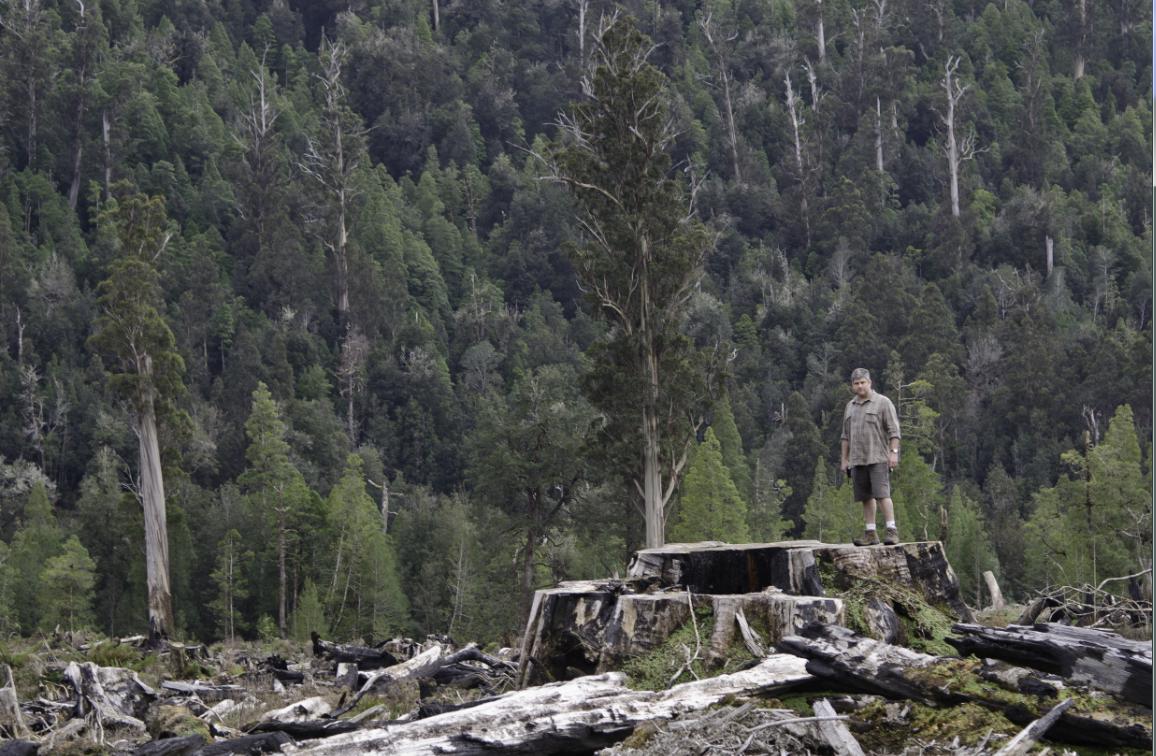
Tassie Oak Reality
Editor standing on a Eucalytus Regnans clearfelled in the Styx Valley
[Photo © Alan Lesheim 20110928]
.
Tags: Australian Forestry Standard, Chain of Custody, Chain of Custody certification, Chain of Ecological Destruction, Eucalyptus delegatensis, Eucalyptus obliqua, Eucalyptus regnans, Forestry Tasmania, hardwood flooring, Industrial Native Logging, Styx Forest, Styx Valley, Tasmania, Tasmanian Oak, Tasmanian Oak hardwood flooring, Tasmanian Sustainable Forest Management, Tassie Oak, Tassie Oak Reality, wilderness
Posted in Tasmania (AU), Threats from Deforestation, Threats to Wild Tasmania | No Comments »
Add this post to Del.icio.us - Digg
Thursday, July 18th, 2013
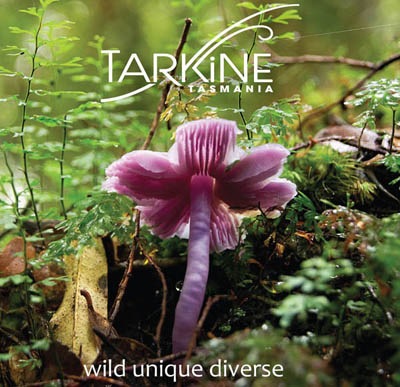 . .
Tarkine Wilderness Values
.
Tasmania’s Tarkine is a vast wilderness region of north west Tasmania covering nearly half a million hectares (the size of Kangaroo Island); a remnant of Gondwanaland and home to the last disease-free stronghold of the Tasmanian Devil.
The Tarkine covers 1,800 km² of beautiful ancient cool temperate rainforest, as well as around 400 km² of eucalypt forest and a mosaic of other vegetation communities, including dry sclerophyll forest, woodland, buttongrass moorland, sandy littoral communities, wetlands, grassland and Sphagnum communities. The Tarkine contains a diverse array of landscapes, from giant forests to huge sand-dunes, sweeping beaches, rugged mountains and pristine river systems. It retains a rare high diversity including:
- 28 terrestrial mammals
- 111 land and freshwater birds
- 11 reptiles
- 8 frogs
- 13 freshwater fish
- 151 species of liverworts
- 92 species of mosses.
.
The Tarkine provides habitat for over 60 rare, threatened and endangered species of flora and fauna. Tthe Tarkine is rich in frog species, with eight of Tasmania’s eleven frog species occurring in diverse parts of the Tarkine, including in the Tarkine’s rainforests, in Melaleuca swamps and scrub, and in the coastal lagoons and dune systems. Two threatened frog species, the Green and Golden Frog, and the Striped Marsh Frog, both occur in coastal lagoons, marshes and swamps of the Arthur-Pieman plains.
The Tarkine is particularly important for freshwater crustaceans – which are of global significance (PWS, 2001). One of the largest freshwater crustaceans in the world, the Tayatea, or Giant Freshwater Crayfish, inhabits the north of Tasmania and the Arthur River catchment – with the Tarkine a stronghold. This extraordinary creature, which can live for up to 40 years of age, and grow up to a metre in length, has been adversely affected by clearing of vegetation and recreational fishing, and is now listed as vulnerable.
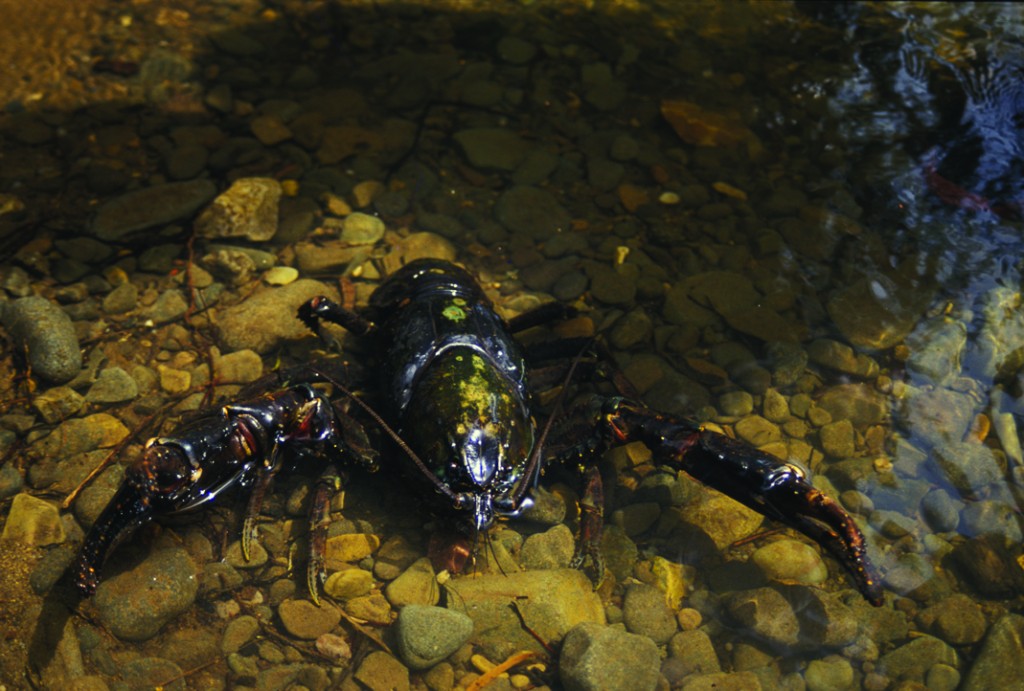 The Tarkine’s Tayatea, or Giant Freshwater Crayfish
The Tarkine’s Tayatea, or Giant Freshwater Crayfish
.
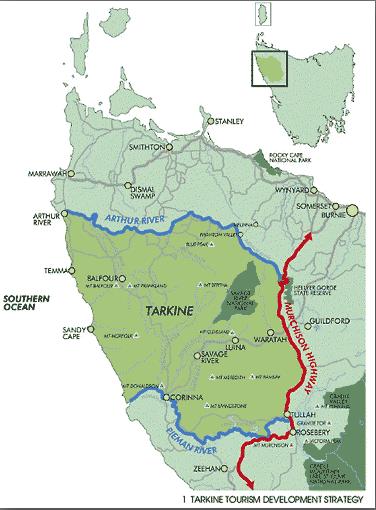 The Tarkine, showing the Tasmanian Government’s 2012 plans for a $34M upgrade of the Murchison Highway,
marketed as ‘tourism development’ but surreptitiously to subsidise increased mining access between the Tarkine and Port Latta.
[Source: Tasmanian Government, Department of Infrastructure, Energy and Resources
^http://www.dier.tas.gov.au/__data/assets/pdf_file/0020/81461/01_Murchison_Highway_Upgrades.pdf] The Tarkine, showing the Tasmanian Government’s 2012 plans for a $34M upgrade of the Murchison Highway,
marketed as ‘tourism development’ but surreptitiously to subsidise increased mining access between the Tarkine and Port Latta.
[Source: Tasmanian Government, Department of Infrastructure, Energy and Resources
^http://www.dier.tas.gov.au/__data/assets/pdf_file/0020/81461/01_Murchison_Highway_Upgrades.pdf]
.
Read More: ^https://www.et.org.au/tarkine-wilderness
.
Tarkine threatened by exploitative greed
.
The backward Tasmanian Government continues to ignore the place, dismissing it as an “unbounded locality” in the Waratah-Wynyard council area, and repeatedly trying to mine it, log it and bulldoze roads through it. So the name ‘Tarkine’ does not appear in maps, in order that it may be exploited section by section. Former Environment Minister Tony Burke was hoodwincked by this tactic as he was guided by miners to the denuded sections, and so diluted his pure vision of the Tarkine’s being worthy of protection for the pristine sections.
Such has perpetuated the 19th Century/early 20th Century ^Robber Baron mentality that has long followed American industrialisation over the past two centuries. On the back of the Robber Barons, the post-war Baby Boomer – “the most self-righteous, self-important, incredibly arrogant generation of all time” [^Source], has bulldozed into oblivion 75% of Tasmanian Nature, 80% of Australian Nature and exterminated Tasmania’s endemic Thylacine.
Still in Tasmania, inherited Taswegian attitudes and addictive exploitation die hard.
.
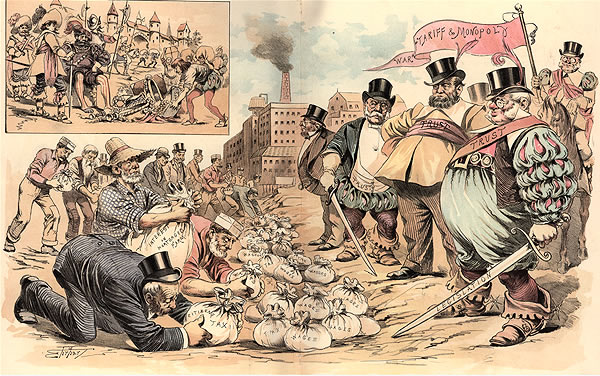 Industrial Robber Barons Industrial Robber Barons
.
However, many of the Tarkine’s unique values are threatened by destructive activities such as new mining, logging, and illegal activities such as poaching and arson, and less than 5% of the Tarkine is protected as a National Park. The Tarkine’s future as a wild place hangs in the balance.
The Tarkine is the home to the last disease free population of the Tasmanian Devil. The Tasmanian Devil is being pushed to extinction by the fatal Devil Facial Tumour Disease. This disease has been estimated to have killed 80% of the Tasmanian Devil population in the past decade. As such the habitat of the Tarkine is critical to survival of this iconic species in the wild. Threats such as mining, logging and roading place the future of the Devil at risk..
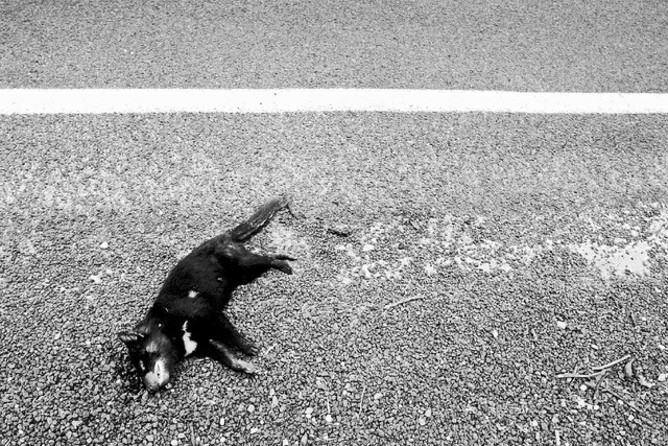 Tasmanian Devils heading towards extinction, following the Thylacine.
Tasmanian Devils heading towards extinction, following the Thylacine.
Token funding in dribs and drabs by the Tasmanian Government toward Save the Tasmanian Devil Programme
pales in the face of the Tasmanian Government encouraging ongoing destruction of the Devil’s critical habitat.
[Source: Photo by Rhys Allen in article ‘Tarkine mines could be last straw for Tasmanian devils’, 20130115, by Hamish McCallum, Head, Griffith School of Environment at Griffith University, ^http://theconversation.com/tarkine-mines-could-be-last-straw-for-tasmanian-devils-114839]
.
Protecting the Tarkine
.
The campaign to protect The Tarkine began in the 1960s, when a formal conservation proposal was put forward by the then Circular Head Mayor Horace (Jim) Lane for the establishment of a ‘Norfolk Range National Park’. But Lane’s proposal was not realised.
From the late 1990s, the region came under increasing national and international scrutiny in a similar vein to the environmental protests surrounding Tasmania’s Franklin River and Queensland’s Daintree Rainforest. The case for protecting the Tarkine was significantly advanced with the Federal Government’s Forestry Package in 2005 adding 70,000 hectares to reserves in the Tarkine.
The environmentalist organisation Tarkine National Coalition, headed by Scott Jordan, has proposed the Tarkine be officially declared a national park, and with the support of many Tasmanians, wishes to ultimately see the Tarkine properly internationally protected as a World Heritage listed area for all time.
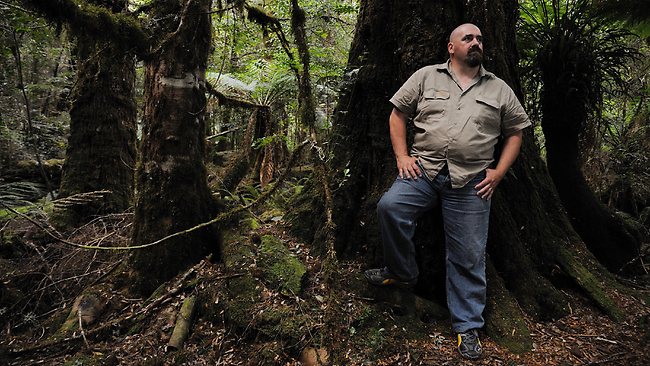 Scott Jordan in The Tarkine Scott Jordan in The Tarkine
.
In December 2009, the Tarkine was listed as a National Heritage Area following an Emergency National Heritage Listing sought by the Tarkine National Coalition to stop a proposed Tarkine Road, which would have coursed through old growth forest and detrimentally affected the natural values of undisturbed areas.
In 2013, while 80% of the Tarkine is now protected from logging, only 5% is protected from mining, and the Tasmanian Government still wants its tourist road bulldozed through it to destroy its wilderness values for tourism exploitation.
In December 2010, the incoming Federal Environment Minister Tony Burke allowed the emergency listing to lapse in the face of numerous mining proposals in the Tarkine.
.
.
Threats from Mining
.
The west coast region of Tasmania has a sad history of exploitative mining since the industrial Robber Baron era of the late 19th Century, when tin was discovered at Mount Bischoff, setting of a mining boom. Cooper was mined from Mount Lyell and smelted at nearby Queenstown from the 1890s. Zinc and lead were mined at Mt Read near Rosebery and nickel from Avebury near Zeehan, both along the southern fringe of the Tarkine. Gold has been from the Henty mine, mixed base metals from the Hellyer mine, and later iron ore extracted in large open cut pits at Savage River in the heart of The Tarkine.
Since 1965, ‘Savage River Mines‘ has been carving up a large slice of The Tarkine from its open-cut magnetite mine.
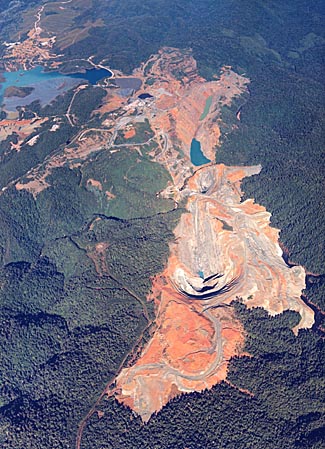 Savage River Mine
Irrevocably carving out Tarkine wilderness, currently operated by Grange Resources Limited Savage River Mine
Irrevocably carving out Tarkine wilderness, currently operated by Grange Resources Limited
.
Ironically, nearby Savage River National Park is recognised for its wilderness values:
.
<< The park protects the largest contiguous area of cool temperate rainforest surviving in Australia and acts as a refuge for a rich primitive flora, undisturbed river catchments, high quality wilderness, old growth forests, geodiversity and natural landscape values.
The western portion of the park includes the most extensive basalt plateaux in Tasmania that still retains a wholly intact forest ecosystem. The upper Savage River, which lends the park its name, runs through a pristine, rainforested river gorge system. The park contains habitat for a diverse rainforest fauna and is a stronghold for a number of vertebrate species which have suffered population declines elsewhere in Tasmania and mainland Australia.
The parks remoteness from human settlement and mechanised access, its undisturbed hinterland rivers and extensive rainforest, pristine blanket bog peat soils and isolated, elevated buttongrass moorlands ensure the wilderness character of the park. Like the vast World Heritage listed Tasmanian Wilderness World Heritage Area to its south, the area is one of the few remaining temperate wilderness areas left on Earth. >>
.
[Sources: ‘Mining’, University of Tasmania, ^http://www.utas.edu.au/library/companion_to_tasmanian_history/M/Mining.htm; ‘Tasmania’s Mines’, Mineral Resources Tasmania (Tasmanian Government, ^http://www.mrt.tas.gov.au/portal/page?_pageid=35,831205&_dad=portal&_schema=PORTAL; ‘Savage River National Park’, Parks and Wildlife Service Tasmania, ^http://www.parks.tas.gov.au/?base=3732]
.
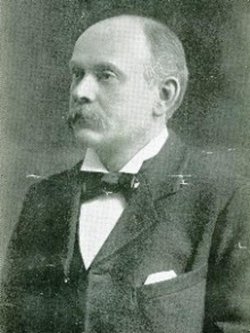 American Robber Baron Robert Carl Sticht (1856-1922)
American metallurgist and General Manager of Mount Lyell Mining and Railway Company
Elitist exploiter of copper mining and smelting from Mount Lyell on Tasmania’ wild west coast American Robber Baron Robert Carl Sticht (1856-1922)
American metallurgist and General Manager of Mount Lyell Mining and Railway Company
Elitist exploiter of copper mining and smelting from Mount Lyell on Tasmania’ wild west coast
.
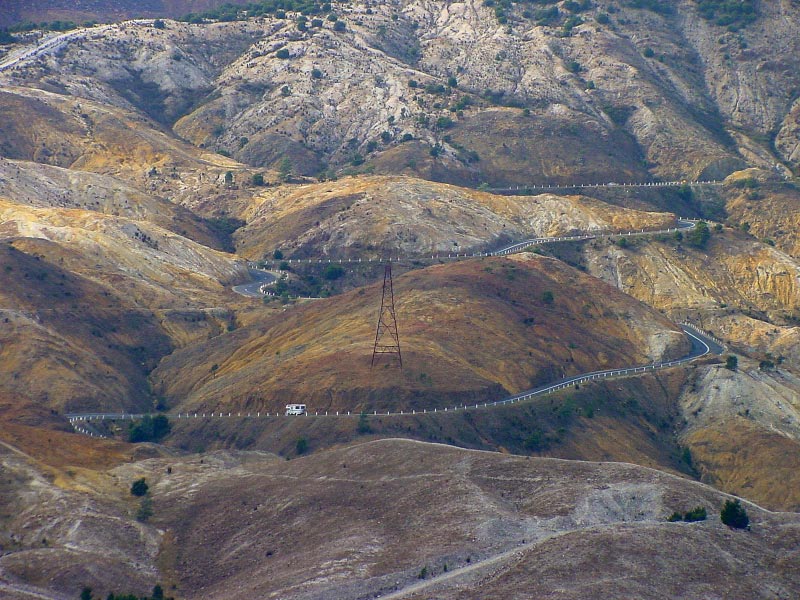 Sticht’s Mining Legacy to Tasmania
– a denuded moonscape above Queenstown caused by sulphuric acid associated with the copper mining and smelting.
The people of Queenstown were not left wealthy after the copper mine closed – the company profits went offshore – sound familiar? Sticht’s Mining Legacy to Tasmania
– a denuded moonscape above Queenstown caused by sulphuric acid associated with the copper mining and smelting.
The people of Queenstown were not left wealthy after the copper mine closed – the company profits went offshore – sound familiar?
.
In 2013, there are ten new mines proposed for the Tarkine over the next five years, and the campaign to prevent this onslaught of destruction is heating up. Nine of these mines are Pilbara style open cut mines. The first two companies to submit for permits are Venture Minerals for their three proposed tin and iron ore mines at Mt Lindsay, and Shree Minerals for their proposed Nelson Bay River iron ore mine.
.
2011: Open Cut Mine proposed by Indian company, Shree Minerals
.
Indian-owned mining conglomerate, Shree Minerals, has proposed to develop an open pit magnetitie/hematite mine and processing plant near Nelson Bay River , approximately seven kilometres east of Temma village in northwest Tasmania. The proposed mine will target 4 million tonnes of the resource over a 10 year period producing 150,000 tonnes of product per year.
.
[Ed: This is in The Tarkine, but of course the term is deliberately omitted]
.
Parent company, Shree Minerals and Fuels, is headquartered at 51 M.I.G., Jain Mandir Road, Shanti Nagar, Housing Board, Katni, Madhya Pradesh, India. It is was established by millionaire, Vishwanath Garodia, and is currently owned by Vijay Garidia. The Shree Minerals Board of Directors is currently made up of Chairman Mr Sanjay Loyalka, Mr. Arun Kumar Jagatramka, Mr Mahendra Pal, Mr Andy Lau and Mr Amu Shah.
[Sources: ^http://www.shreemineralsandfuels.com/owners-profile.html; ^http://www.shreeminerals.com/scripts/page.asp?mid=11&pageid=13]
.
<< Shree Minerals has lodged a Development Application with a supporting Development Proposal and Environmental Management Plan (DPEMP) to Circular Head Council… (and) the Australian Government has declared the proposal a controlled action which will require assessment and approval under the Environment Protection and Biodiversity Conservation Act 1999. This process will occur separately from the State Government process (which has approved the mine). >>
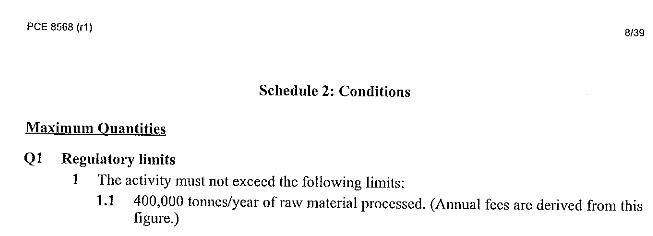
.
[Source: Tasmanian Government, ‘Shree Minerals Ltd Nelson Bay River Mine, (undated), ^http://epa.tas.gov.au/regulation/shree-minerals-ltd-nelson-bay-river-mine]
.
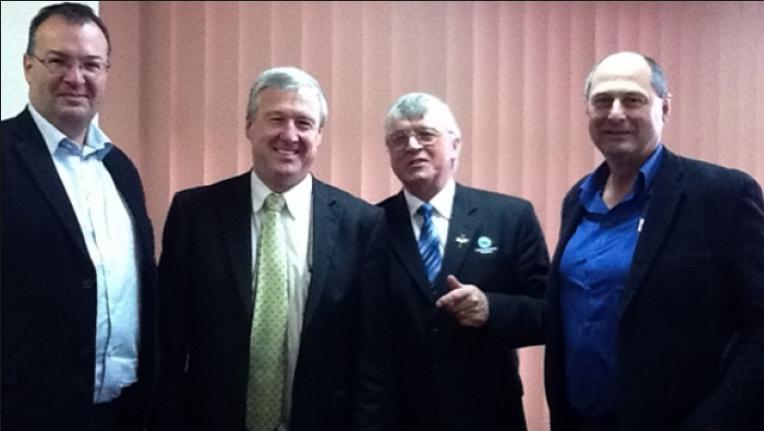 Tasmanian Baby Boomer politicians in 2012 with Indian chairman of Shree Minerals, Sanjay Loyalka
[Source: Tasmanian Minerals Council, ^http://www.tasmanianmining.com.au] Tasmanian Baby Boomer politicians in 2012 with Indian chairman of Shree Minerals, Sanjay Loyalka
[Source: Tasmanian Minerals Council, ^http://www.tasmanianmining.com.au]
.
<< With Tasmanian approvals in hand for mining at Nelson Bay River (NBR), Shree Minerals awaits Commonwealth Government approval, which is expected soon. Meanwhile, drilling will commence at NBR in November.
Shree Minerals (ASX:SHH) has re-affirmed that it is awaiting Commonwealth approvals for mining to commence at its Nelson Bay River Iron Project (NBR) in Tasmania.
Tasmanian approvals were received from:
– Circular Head Council, Tasmania;
– Environmental Protection Authority (EPA), Tasmania; and,
– Mineral Resources Tasmania (MRT) grant of Mining Lease
Shree said it expects a final decision from the Australian Commonwealth Government under EPBC Act, for which the final EIS has been published following response to submission received as a result of public exhibition of Draft EIS. Further that it expects to receive approval and a final decision is now expected soon.
Other highlights included:
– Grant of Mining Lease from Mineral Resources Tasmania (MRT) for mining at NBR has been received
– Maiden Reserves published and DSO mine plan for first 2 years finalised (October 2012).
– The 2011/12 fieldwork at Mt.Sorell has identified encouraging signs for the presence of Volcanic Hosted Massive
The production schedule for the first two years comprises mining of DSO iron ore. The DSO requires no further beneficiation to produce a marketable product. It only requires crushing and screening. Two separate DSO pits are planned in the first two years (comprising DSO South Pit and DSO North Pit, which is within the BFO resources) with following total resultant pit quantity of 815,000 tonnes at 57.5% iron (Fe):
The DSO is a first, lucrative stage of mining at NBR. It involves minimal CAPEX and no infrastructure CAPEX.
Development stages at NBR
Development of the project involves three stages. The first stage is to develop two relatively shallow opencut mines to produce direct shipping grade hematite ore.
This direct shipping ore (DSO) only requires crushing and sizing to produce the DSO product. Each pit will produce a separate grade of DSO product.
The south pit has a higher DSO grade and will be mined first with the product transported to Port Latta for export. The north DSO pit, situated above the main magnetite orebody will follow. It has a lower DSO grade.
Stage two involves the continuation of mining of the northern DSO opencut. Here the stage one DSO hematite oxide cap is surrounded by lower grade ore considered to have the potential to be processed to produce a commercial beneficiated oxide product (BFO). Processing the BFO material is considered to be stage two of the project.
Stage three of the project involves the opencut mining of the deep magnetite orebody beneath the oxide cap. This magnetite ore will require processing to produce commercial grade magnetite products and the BFO processing plant will be modified to achieve this objective.
Earlier studies demonstrated that the magnetite ore can produce two products, a dense media magnetite (DMM) product suitable for coal washery applications or a blast furnace pellet (BFP) magnetite product.
Suppliers are few in number for the higher value DMM product and mining generally occurs on a small scale. This would suit the Nelson Bay Iron Project.
Shree is planning to commence drilling at the NBR and Rebecca Creek tenements during the second week of November. Documentation for approval to drill ~3500 m to improve resource category and further extension of resources and geotechnical studies at the Project was submitted to the Minerals and Resources Tasmania. >>
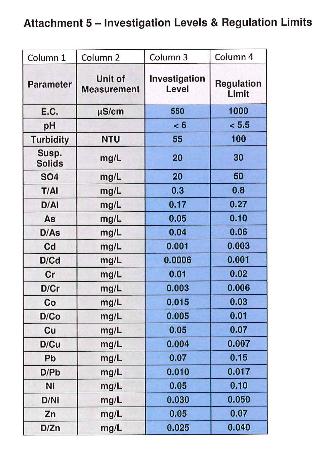 The Mine’s expected Heavy Metal products/tailings cocktail
The Mine’s expected Heavy Metal products/tailings cocktail
(Copper, Lead, Chromium, Cadmium, Cobalt, Nickel and Zinc, as well as Arsenic and sulphuric acid)
.
[Source: ‘Is Shree Minerals the next iron ore producer in Australia?’, 20121029, by Proactive Investors, ^http://www.proactiveinvestors.com.au/companies/news/35093/is-shree-minerals-the-next-iron-ore-producer-in-australia-35093.html]
.
Shree Mining Gloat
.
<< Shree Minerals chairman Sanjay Loyalka presented to over 175 investors this week at the ‘Stars in 2013′ investor forum in Sydney – and outlined the company’s pathway to production. Shree is positioned to become Australia’s next iron ore producer when the company commences production from the Nelson Bay River Project in Tasmania in mid-2013.
Shree Minerals presented to brokers, fund managers and investors this week in Sydney at Proactive Investors “Stars in 2013” investor forum – and focused on how the company will become Australia’s next iron ore producer. The production schedule for the first two years comprises the mining of DSO iron ore, which requires no further beneficiation to produce a marketable product.
Shree is targeting iron ore production in mid-2013 from the Nelson Bay River Project which is located in the west coast of Tasmania, in an area rich with infrastructure which includes being close to roads and port.
Shree has a memorandum of understanding with nearby miner Grange Resources for use of port Latta, and has an off-take contract MOU in-place with a large international trading house.
All approvals are in place for developing the mine including; Environmental Protection Authority (EPA), Tasmania; Mineral resources Tasmania (MRT) grant of Mining Lease; and Commonwealth Government under EPBC Act.
Highlighting the prospectivity of the area, it hosts world class mines including Grange Resources’ Savage River, Vedanta’s Mt Lyell, Unity Mining’s Henty and MMG’s Roseberry and Avebury.
Shree’s Nelson Bay River Project has a goethite-hematite Inferred Resource of 1.4 million tonnes, magnetite Resources of 7.8 million tonnes at 38.3 DTR, and is capable of producing highgrade concentrates to produce Blast Furnace (BF) Pellets and Dense Media Magnetite (DMM). Importantly there is the opportunity for resource growth, considering that the current resource is only based on limited drilling at the north end of the Aeromagnetic Anomaly as the company focus in last two years has been the on permitting process and project development.
This exploration potential provides the opportunity for a substantial increase in scale and mine life.
The Nelson Bay River Project differentiates itself from other iron ore projects as it does not require large CAPEX in infrastructure, and importantly there is a local workforce available, which cuts costs compared to other producers who use the fly-in-fly-out model. >>
.
[Source: ‘Shree Minerals’ Sanjay Loyalka outlines path to iron ore production in front of 175 investors’, 20130125, by Proactive Investors, ^http://www.proactiveinvestors.com.au/companies/news/38728/shree-minerals-sanjay-loyalka-outlines-path-to-iron-ore-production-in-front-of-175-investors-38728.html]
.
Aug 2012: Tasmanian EPA recklessly approves Dark Side Ecology
.

.
<< The Tarkine National Coalition (TNC) has reacted with disbelief to the Tasmanian EPA’s approval of the Shree Minerals Nelson Bay River mine despite clearly incomplete and fraudulent information tendered by the proponent.
.
‘Shree EIS a mismatch of omissions, flawed assumptions and misrepresentations’
.
The Shree Minerals’ Environmental Impact Statement for the proposed Nelson Bay River open cut iron ore mine as a mismatch of omissions, flawed assumptions and misrepresentations. Key data on endangered orchids were missing, and projections on roadkill impacts on Tasmanian devil and Spotted tailed quoll were based on fanciful data known to contradict the company’s independent Traffic Impact Assessment.
.
Scott Jordan (TNC):
.
“The EPA seems to have abandoned rational science and accepted Shree Minerals’ assertion that a 1km long 220 metre deep open cut pit extending 170 metres below the level of the adjacent Nelson Bay River wont impact on hydrology.
The EPA also has chosen to accept Shree Minerals blatant contradictions and misrepresentations in the data relating to projections of Tasmanian devil roadkill from mine related traffic by accepting projections substantially lower than Shree Minerals’ own expert produced Traffic Impact Assessment. This increase of traffic will, on the company’s formulae, result in up to 32 devil deaths per year, not the 3 per year in presented in the data accepted by the EPA.”
.
This failure comes within days of Federal Environment Minister Tony Burke’s decision to absolve himself of responsibility for conducting environmental assessments by allowing the Tasmanian Government to conduct the EPBC assessments for mining projects in the Tarkine.
“Is this really the assessment regime that Tony Burke want to oversee the protection of the environment in the Tarkine?”, asks Jordan. Decisions on Commonwealth environmental approvals and local council approvals have not been granted at this point. Unlike the Venture Minerals projects, the Shree Minerals also has a concurrently running Commonwealth assessment. >>
.
Senator Christine Milne, leader of the Australian Greens:
.
“The Tasmanian Government EPA’s approval of the Shree Minerals mine confirms exactly why Tony Burke is wrong to trust this agency with the assessment of new mines in the Tarkine. Shree Minerals has no friends in the Tasmanian mining industry. The company fudged their data on likely impacts on the Tasmanian Devil – yet here they are securing Tasmanian Government approval.
“The ball is now in Tony Burke’s court. He should reject Shree’s mine, which still has to pass federal environmental approvals tests. He must reverse his decision to let Venture Mineral’s three mines be assessed by the Tasmanian Government.
“By not heritage listing the Tarkine, Tony Burke has washed his hands of responsible environmental protection and approval of the Tarkine rainforest and the threatened Tasmanian Devil, and now we see the consequences.”
.
The Tasmanian Greens will write to Tasmania’s Environment Protection Authority seeking further information over a decision to approve an iron ore mine at Nelson Bay River. >>.
 Alex Schaap, Tasmanian EPA Director
Under fire over nondisclosure of a heavy metals spill from a tailings dam spill at Grange Resources Savage River mine into surrounding waterways in early 2013.
[Source: ‘Tasmania’s Environment Protection Agency is on notice’, 20130318, by Isla Macgregor, Tasmanian Public and Environmental Health Network, ^http://tasmaniantimes.com/index.php?/weblog/article/tasmanias-environment-protection-agency-is-on-notice/] Alex Schaap, Tasmanian EPA Director
Under fire over nondisclosure of a heavy metals spill from a tailings dam spill at Grange Resources Savage River mine into surrounding waterways in early 2013.
[Source: ‘Tasmania’s Environment Protection Agency is on notice’, 20130318, by Isla Macgregor, Tasmanian Public and Environmental Health Network, ^http://tasmaniantimes.com/index.php?/weblog/article/tasmanias-environment-protection-agency-is-on-notice/]
.
Greens Member for Braddon (Tasmania), Paul O’Halloran MP:
.
“Serious concerns have been raised about the reliability and accuracy of information provided to the EPA by the mine proponent, Shree Minerals. The public should be able to have full confidence in the capacity of agencies like the EPA to independently assess these controversial mining projects and to test the accuracy and rigour of the data they are provided.
“Critical details regarding the impact on threatened species appear to be missing or inconsistent with previously released data, and the potential hydrological impacts have not been fully assessed. “When you consider that the mine itself will be well below the level of the nearby Nelson Bay River, it’s hard to see how this will not impact on the area’s hydrology.
“If the Commonwealth uses the same questionable data for its assessment for the project, then the Tasmanian public will be rightly sceptical when their final decision is handed down.” >>
.
[Sources: ‘EPA’s approval of Shree Minerals’ incomplete environmental reports a farce’, 20120801, by Scott Jordan, Campaign Coordinator Tarkine National Coalition, ^http://tasmaniantimes.com/index.php?/weblog/article/epas-approval-of-shree-minerals-incomplete-environmental-reports-a-farce/]; ‘ Greens seek answers over Shree Minerals Assessment’, by Paul O’Halloran MP, Greens Member for Braddon, 20120727, ^http://tasmaniantimes.com/index.php?/weblog/article/epas-approval-of-shree-minerals-incomplete-environmental-reports-a-farce/]
.
Sep 2012: Mainland unions weigh into Tarkine v Mining debate
.
National Secretary of the Australian Workers’ Union Paul Howes discusses the union’s campaign to promote mining in Tasmania.
.
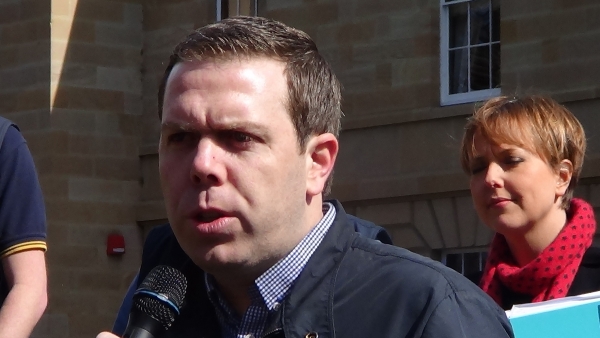 National Secretary of the Australian Workers’ Union Paul Howes addressing a rally in Hobart,
with Tasmanian Premier Lara Giddings in the background.
[Source: ^http://www.tasmanianmining.com.au] National Secretary of the Australian Workers’ Union Paul Howes addressing a rally in Hobart,
with Tasmanian Premier Lara Giddings in the background.
[Source: ^http://www.tasmanianmining.com.au]
.
ABC Television Transcript:
.
<< EMMA ALBERICI, PRESENTER: To discuss the AWU’s campaign, I was joined earlier in our Hobart studio by the union’s national secretary, Paul Howes.
Paul Howes, welcome to Lateline.
PAUL HOWES, NATIONAL SECRETARY, AUSTRALIAN WORKERS’ UNION: Thanks, Emma.
EMMA ALBERICI: The Federal Environment Minister Tony Burke on the Tarkine issue has indicated he’s not predisposed to wholesale heritage listing. So what exactly are your concerns there?
PAUL HOWES: There is a very large campaign being run at the moment by the Greens and GetUp in particular, aiming to have the entire north-western region of Tasmania, known as the Tarkine, listed for World Heritage listing.
That would potentially close two existing mines, would have the impact of not having the go-ahead for a number of new mines in the region which need to be developed.
At the moment north-west Tasmania has unemployment of around 8.4 per cent, when you compare that to the national average of 5.2 per cent, you can see how hard times are in that part of Tasmania.
And to lose a minerals industry would be devastating for the entire state, but particularly for the north-west.
The mines in question and the potential mines in question take up less than 1 per cent of the land mass of the Tarkine and whilst we accept there are many areas of the Tarkine that should be protected and should be locked up from future development, we are concerned that this large-scale campaign will pressure the Federal Government into actually granting a listing which would potentially shutdown this very important industry for north-west Tasmania.
And our members that work in the sector have been concerned for a long time, their voices haven’t been heard in the debate, and that’s why they asked us to run this campaign so that their voices can be heard on the national stage about what they believe should continue to happen in the Tarkine, which is having nature and the mining industry co-existing as it has done for 120 years.
.
EMMA ALBERICI: On the process of heritage listing, you would be aware that current mines are not affected and current applications for mines equally are not affected?
PAUL HOWES: Well that’s not the case.
EMMA ALBERICI: It’s certainly the case as Tony Burke’s office explained it to us.
PAUL HOWES: If you look at the issue, for example, of Rosebery. Rosebery isn’t subject to the … the current mining operations at Rosebery isn’t subject to the listing, but Rosebery needs a new tailings dam, that new tailings dam has to be built in an area which would be subject to the listing.
If the new tailings dam can’t be built then Rosebery would should, equally for Savage River. Savage River needs to expand and move into new parts of ore bodies that would be in areas where that listing applies.
Look, I’m very hopeful and I think that Tony Burke will make the right decision, but equally it’s important that the voice of Tasmanian miners and Tasmanian communities in the north-west of the state are heard in this debate.
As we have seen in the proposals put forward by the national Tarkine coalition, if they were successful in their proposal a whole range of potential mines and exploration zones would be locked up. So that’s why we need to ensure that when the Federal Government makes a decision, that it does the right thing for the environment, everyone agrees with that, but we don’t hurt the Tasmanian economy and create a situation where we’ve had intergenerational mining in that part of Tasmania for 120 years being wiped off the map for the sake of frankly an ideological agenda being driven by a few.
.
EMMA ALBERICI: But Paul Howes, we do have to make the distinction here, no-one is suggesting mining’s going to be wiped off the map in Tasmania. You say yourself these are potential mines, these are not current mines, nor are they mines under current assessment.
PAUL HOWES: Yes, they are Emma. They are currently under assessment.
EMMA ALBERICI: Well if they are under assessment Tony Burke’s office tell us they are not affected by the heritage listing. Who is right?
PAUL HOWES: Hopefully that will be the case but the campaign being run by the national Tarkine coalition and by the Greens would have the effect, if it were successful, in shutting down, for example, the venture minerals site. That’s the outcome.
Now we are providing the alternative voice, which is saying these areas equate to roughly 1 per cent of the land mass of the Tarkine and we believe that those areas should be excluded. In terms of the current mines, as I explained only just a few minutes ago, yes, it is true to say that the existing mine site at Savage River and the existing mine site at Rosebery isn’t covered by the proposal, but where those mines have to expand just slightly down the road is covered by the proposal.
And if those expansions can’t go ahead, then the existing mine sites won’t be viable. It’s not just a simple matter of getting out the map and looking at where the current mining operations take place and where the proposed ones have been, there is the case that if the national Tarkine coalition’s proposal goes ahead, you would see the mine life of a mine like Rosebery being cut drastically short.
I’m not in the business of running campaigns when we don’t have to, I would be more than happy to see a sensible campaign run by the environmental lobby that would actually result in carving out the minerals zones. But if you just log on to the national Tarkine coalition website, yourself, you’ll see that a large part of their campaign is about stopping the potential mines that should go ahead in the next couple of years, from actually happening.
.
EMMA ALBERICI: Some of the current approvals being sought are possibly going to endanger… possibly going to put at risk some endangered species. You would accept surely that some of those do need protection?
PAUL HOWES: Absolutely and once again, we are talking about an environmental footprint of less than 1 per cent of the Tarkine region. You are talking about areas which have been portrayed, particularly by GetUp, for example, as saying as being virgin or untouched rainforest, where it’s just not the case.
There has been widespread mining activity across the Tarkine for 120 years. Many of the areas that have actually featured in GetUp ads are actually areas which used to be mining facilities. In fact there was a famous ad that GetUp ran in The Sydney Morning Herald with a picture of the Environment Minister Tony Burke looking at a tree – he was standing on an old mining trail.
The point is that, yes, we need to do what we can to protect endangered species and yes we should lock up those areas of the region that deserve environmental protection, but we should also look at the facts in the cold hard light of day and recognise that there is the ability to have sustainable mining practices engaged right across that region and at the same time do the right thing by the environment.
.
EMMA ALBERICI: If we can move on to the Greens more broadly, you’ve been attacking them for the better part of the last few months pretty consistently. Is this part of a deliberate strategy to sort of re-establish Labor as an entity in its own right, to kind of divorce itself from the Greens on the political stage?
PAUL HOWES: In terms of the campaign that we have launched here in Hobart today, it’s a campaign that members of my union asked us to run, and I’m responding to the wishes of our members. That’s what membership based organisations do. Our union does campaign against companies, against governments and against political parties which pose direct threats to the job security of our members.
In the form of the Greens, whilst there are many policies that I do agree with the Greens on, overall their economic policies are ones which would lead to wide sections of the membership of the AWU being left out of work. That’s why we have been, for a very long period of time – it predates even my time as secretary of the union – been very strident and forthright in our criticism of a lot of the policies.
I’m pleased that we have seen over the last few months more people in the Labor movement stepping up to the plate, actually taking on the Greens, actually calling into question many of their policies which for too long have gone unquestioned. Ultimately I do think they should be held to account. I don’t think the Labor Party needs to differentiate itself because ultimately the Labor Party is a separate party.
The Labor Party and the Labor movement has very different values to the values of the Greens and whilst there might be some similarities in some areas, at the end of the day the type of Australia that the Labor movement wants to see and the type of Australia the Greens want to see are two very different types of Australia.
.
EMMA ALBERICI: Recently you have compared the Greens to One Nation and to the DLP. Have you gone too far there? What is it about the Greens that you fear?
PAUL HOWES: I don’t fear the Greens. Things that I fear I normally run away from. I don’t fear the Greens.
EMMA ALBERICI: You clearly fear their impact on your party.
PAUL HOWES: What I have said is I think it’s incumbent upon the Labor movement to actually take up the fight to the Greens, that we shouldn’t shy away from articulating the alternative vision that we see for this country.
Now as I said, there are many Greens policies which are similar to views that I hold, but ultimately on the key questions about work, the value of work, the type of economy we have, which is I think fundamental to the nature of what it is to be Australian – the Greens and the Labor movement are worlds apart.
My view has been for a long time that we should articulate that, we should take up that fight and that we should actually demonstrate that our values are different, their values are theirs.
Now of course, voters will be free to choose between the two, but we actually need to articulate those differences in our views and policies proudly and strongly.
.
EMMA ALBERICI: Is there a fear that voters won’t be able to see a difference between the two?
PAUL HOWES: I think occasionally that might be the case. I think of late, we have seen substantial differences. I was proud to be standing on the steps of Tasmanian Parliament today with the Tasmanian Premier Lara Giddings, who was very strongly backing our campaign about the Tarkine.
That clearly demonstrates she disagrees strongly with her colleagues in the minority government here in Tasmania, and that’s important. It’s important to traditional Labor voters, particularly in rural and regional Tasmania and important to working-class Labor voters right across the country to know that the Labor Party – still right across the nation, stands up for the values of work and believes in the need to have a diversified economy.
Ultimately, what the Labor Party does in government, state or federal, is up to them. But as a member of the Labor movement and our union has strongly believed for a long time that this is a fight that’s worth having.
.
EMMA ALBERICI: Finally, the new government in Queensland has today slashed just shy of 3,000 jobs in its Health Department.
What intelligence are you getting from your Queensland colleagues about how much further the job cuts are likely to go?
PAUL HOWES: We are very proud to represent over 10,000 workers in the Queensland Health Department and we are disappointed that Campbell Newman today in his announcement hasn’t articulated where these job cuts are going to happen.
We fear that it will be frontline workers in the hospitals that will be cut. If that happens, we will see a decrease in patient care right across Queensland. What we are seeing here is an aggressive and scary attack on services right across Queensland, but particularly in the Health Department.
Queensland Health has had a lot of problems for a long period of time, but cutting staff, stripping back services, outsourcing essential services across Queensland hospitals, is not the way to resolve issues in Queensland Health.
In fact, it will send Queensland Health back into the dark ages and frankly, we are fearful, in fact we are very strongly fearful and we suspect that this is only the beginning of deeper and harder cuts to come from Campbell Newman, once again betraying his promises to the Queensland people that he made right before the election.
.
EMMA ALBERICI: Right Paul Howes we have to leave it there but thank you very much for your time.
PAUL HOWES: Thank you, Emma. >>
.
[Source: ‘Paul Howes locks horns with the Greens over anti-mining campaign’, 20120907, Australian Broadcasting Corporation (television), Reporter Emma Alberici, ^http://www.abc.net.au/lateline/content/2012/s3585805.htm]
.
 [Source: Kudelka’s view,
^http://www.themercury.com.au/article/2012/05/12/327401_tasmania-news.html] [Source: Kudelka’s view,
^http://www.themercury.com.au/article/2012/05/12/327401_tasmania-news.html]
.
Dec 2012: Burke approves Shree Mine based on dodgy submission
.
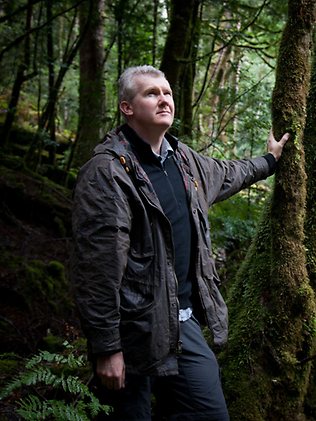 Federal Environment Minister, Tony Burke in The Tarkine
Federal Environment Minister, Tony Burke in The Tarkine
.
<< Environment Minister, Tony Burke, today approved Shree Mineral’s Nelson Bay River Magnetite and Hematite Mine in north-west region of Tasmania with 29 strict conditions.
.
Mr Burke:
.
“The approval conditions will ensure the mine will be built and operated in strict accordance with national environment law. By imposing these 29 approval conditions I am satisfied the project can now go ahead without any unacceptable impacts on matters of national environment significance such as nationally listed threatened and migratory species and their habitat.
In making my approval I am requiring Shree Minerals to comply with a number of key environmental conditions and actions. My decision is based on a thorough and rigorous assessment of the proposal, with extensive opportunity for public consultation.
Key aspects of the approval conditions include:
- the development of a site-wide management plan for the protection of nationally threatened species at the mine site and for travel to and from the mine site
- the undertaking of targeted pre-clearance surveys for the nationally listed masked-owl, spot-tailed quoll, Tasmanian devil and Tasmanian wedge-tailed eagle
- environmental awareness training for all staff, contractors and visitors to the site.
.
“In addition I am requiring Shree Minerals to take specific actions to mitigate and avoid the threat of road kill to nationally threatened species, especially the Tasmanian devil.
I am requiring that mine vehicles travel only during daylight hours and abide by appropriate speed limits within and to and from the mine site and that they provide bus transport to limit the amount of traffic on nearby roads.
I am also requiring that Shree Minerals report all deaths of nationally threatened species from road kill caused by the operation of the mine. This information will be recorded on their website and updated at least every three months.
If reported road kill is in excess of predicted levels, the conditions require that Shree Minerals pay additional compensation or provide new resources for further environment programs to support threatened species in and near the site.
“I am also requiring Shree Minerals to fund and resource a Tasmanian Devil monitoring strategy on the mine site. The strategy will need to involve at least ten infrared monitoring cameras and be consistent with the work being done by Save the Tasmanian Devil Program.”
.
Each year Shree Minerals is required to report on their compliance with the approval conditions and publish this information on their website.>>
.
[Source: ‘Environment Minister Approves Shree Minerals Nelson Bay River Mine’ (media release), The Hon Tony Burke MP, Minister for Sustainability, Environment, Water, Population and Communities, 20121218, ^http://www.environment.gov.au/minister/burke/2012/mr20121218.html]
.
Burke allows mining disturbance to colour his purist view:
“I was expecting to see a pristine area pretty much covered in rainforest. The truth of the industrial history and current industrial activity in the Tarkine was quite different to those images”
.
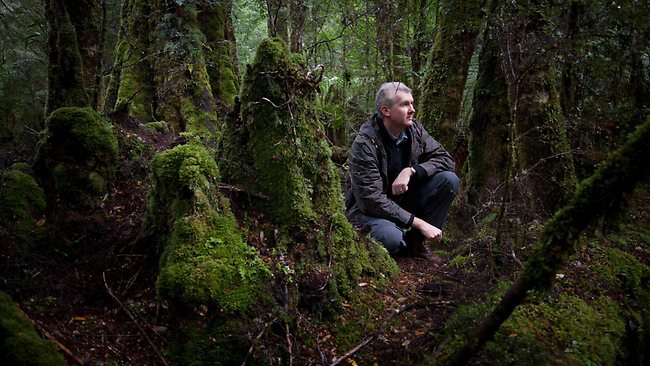 Tony Burke considers a plan for world heritage listing during a visit to the Tarkine
[Source: Photo by Peter Mathew, ‘Labor accused of betraying Tarkine forests by favouring mining in heritage decision’, by Matthew Denholm, The Australian (with AAP), 20130208, ^http://www.theaustralian.com.au/national-affairs/tony-burke-backs-away-from-tarkine-protection/story-fn59niix-1226573268457] Tony Burke considers a plan for world heritage listing during a visit to the Tarkine
[Source: Photo by Peter Mathew, ‘Labor accused of betraying Tarkine forests by favouring mining in heritage decision’, by Matthew Denholm, The Australian (with AAP), 20130208, ^http://www.theaustralian.com.au/national-affairs/tony-burke-backs-away-from-tarkine-protection/story-fn59niix-1226573268457]
.
Burke lets mining wounds open up Tarkine to circling vultures
.
<<The large expanse of land known as the Tarkine is currently host to around 60 mineral exploration licences, with 10 mines proposed for development over the next few years. The mineral rich area is also largely undisturbed, with temperate rainforests, open plains, diverse flora, and a stronghold of healthy Tasmanian Devils. The approval of the Nelson Bay River magnetite mine marks the beginning of a new chapter in the Tasmanian discourse over the benefits of exploiting natural resources over the preservation of unique natural heritage.
There are existing mines in the Tarkine region on the West Coast of Tasmania; the iron ore mine in Savage River managed by Grange Resources, the Hellyer Mine managed by Bass Metals and the Rosebery Mine managed by MMG.
A long history of mining in the area is coming face to face with a growing awareness of its unique natural and cultural significance.
Yesterday’s approval of a magnetite mine adjacent to the Nelson Bay River by Federal Environment Minister Tony Bourke is the first of several proposed new mining ventures in the area, after nearly twenty years of no new mining approvals in the state.
The interest in superior steel products is creating an increased demand for magnetite across Australia, which, after being processed, provides a consistently higher iron content in comparison to hematite ore.
The magnetite mined from the proposed open cut pit is also used to create magnetic iron oxides used in magnetic storage, for example in the magnetic layer of hard disks.
Twenty-nine conditions from Federal Environment Minister Tony Burke accompany the approval of Shree Minerals’ Nelson River Bay mangenite mine, largely directed at protecting native flora and fauna.
Included in the environmental conditions are $48,000 fines if Tasmanian Devils are killed by vehicle movement, if more than two are killed within a 12 month period.
As Tasmania takes a respite from the ongoing debate over how to restructure a floundering forestry industry, reactions to the magnetite mine approval have been swift.
Leon Compton spoke to some stakeholders in the approval on Statewide Mornings, beginning with Ian Woodward, principal environmental scientist for Tasmanian firm Pitt and Sherry, who prepared the environmental assessment report.
“In terms of the environmental significance, both the state and commonwealth assessments have been very comprehensive.”
“There are no threatened plant species on the site, there is a very low likelihood of threatened fauna, there might be one or two Tasmanian Devils that use the area.”
Shree Minerals has also committed to road transport movement during the day time, and limited speed conditions.
“Minister Burke’s concerns were confined to threatened species listed under Federal legislation, the EPA’s assessment in the Tasmanian jurisdiction was very much more comprehensive and considered all environmental matters including ground disturbance, water management, potential for acid drainage and how that would be mitigated and managed.”
The mine footprint is about 150 hectares, and will consist of two open cut pits that are designed to contain the possibility of acid generating materials being uncovered.
Exposed rock can generate acid as it oxidises, and there are examples of acidic poisoning of rivers from previous mining activities in the region.
Most famously, the King River is described as the most polluted river in Australia, a result of mining prctices at Mount Lyell on its tributary, the Queen River.
The Whyte River and Savage River, which both flow into the Pieman River, and the Arthur River at the northern end of the Tarkine, all suffer from acidity as a result of previous mining practices.
Scott Jordan, from the Tarkine National Coalition, believes that the proposed mine will have a massive effect upon the hydrology on the area around the site.
“This mine will be 225 metres deep, it will be 170 metres below the level of the adjacent Nelson Bay River, it will 60 metres below sea level.”
“In the referal that went to the Commonwealth, there were 16 Commonwealth listed threatened species identified within the five kilometre radius of the site.”
He questioned the assertions made by Pittt and Sherry regarding Tasmanian Devil numbers and the traffic impact assessment.
“They submitted to the Commonwealth that there would be an increase in road traffic affecting Tasmanian Devils of 32 percent, when in fact the Traffic Impact Assessment tells them that they would be looking at about 320 per cent.”
Asked why we have yet to hear from state green cabinet members, Mr Jordan said, “These decisions are made by a minister, they are not made by a cabinet, and so I would expect that the Green members of cabinet are just as upset about this as I am, and I expect that we will see them voicing that concern.”
Leon Compton also spoke with Circular Head Mayor Daryl Quilliam who vouched for the benefits of the proposed mine for the region.
“It’s not only good for our area, it’s good for Tasmania becvause of the investment that is happening overseas and good for the region in that jobs will be created right along the North West Coast.”
Asked about the environmental concerns Mr Quilliam said, “Everybody is welcome to their opinion, and that is fine, but you’ve got to stop and realise that there has been five or six years of planning for this mine, and just to go through the rigorous process it goes through now, all those environmental issues have been looked at.”
“Mines are not like they used to be 40 or 50 years ago, where you just dig a hole and leave a hole.”
Mr Quilliam discounted the area as the last refuge of the Tasmanian Devil, and cited Woolnorth as being more likely as that region.
“If there are protests, well I am sorry, but our local people, and I would say 80 to 85 percent of our local people are supporting that mine, will need to protest against them as well.”
Mr Quilliam called for people to work together to protect the region, and thinks that there is no reason why all values cannot be upheld. >>
.
[Source: ‘Tarkine focus on Nelson Bay River’, 20121219, by Tim Walker (Cross Media Reporter), ABC, ^http://www.abc.net.au/local/stories/2012/12/19/3657638.htm]
.
Tasmanian Devil’s extinction by a thousand cuts
.
<< Just a week before Christmas, Environment Minister Tony Burke approved Shree Minerals’ mine near Temma in the Tarkine region of north-west Tasmania. Perhaps he hoped the announcement would get lost in the Christmas and New Year “silly season”, because this approval is likely to be extraordinarily controversial: the mine is in an area currently proposed for World Heritage listing and is also in the last remaining stronghold of the Tasmanian devil.
The Tasmanian devil is threatened with extinction by an infectious cancer. Since its first discovery in north-eastern Tasmania in 1996, the cancer has inexorably spread westward, reducing Tasmanian devil populations by at least 80%.
Only the north-west remains undiseased. There are indications that the devil populations in the north-west have slightly different genetic composition from those in the remainder of Tasmania and may perhaps harbour some individuals with genotypes resistant to this lethal disease.
Tony Burke’s press release and his approval of 18 December explicitly recognise the threat that this mine will pose to Tasmanian devils: the developers are required to donate $350,000 to the Save the Tasmanian Devil Program Appeal to compensate for the mine’s unavoidable impact.
Within the limited area of the mine site itself, there will certainly be impacts on wildlife, including devils. More seriously, the ore will need to be trucked out by road for about 150km. Almost all of this distance will be through habitat of undiseased Tasmanian devils.
As scavengers, devils are particularly susceptible to being killed on roads, as they feed on the carcasses of other animals, such as possums or wallabies, which have previously been run over. As anyone who has driven in Tasmania will know, roadkill of Tasmanian Devils is not new. The problem is that its impact on the viability of the species as a whole is much greater now than it has been in the past, given that roadkill is additional to mortality imposed by facial tumour disease. This and other proposed mines will substantially increase total vehicular traffic in the remote north west of Tasmania.
The approval contains several conditions intended to mitigate this threat of roadkill to devils. These include an obligation to report all incidents of roadkill, a requirement that most travel to and from the mine site must occur during daylight hours and reduced speed limits of 50 km/h or less close to the mine site. But most of the distance mine trucks will travel through devil habitat on their way to port will be outside the reduced-speed-limit area.
A penalty of $48,000 will be applied to each Tasmanian devil in excess of two per year killed on the road by mine vehicles. This sounds a strong disincentive in principle, but I wonder what will happen in practice. There will be an even stronger incentive for vehicle operators to simply throw a carcass off the road into the bush rather than admit to killing a devil and incurring this substantial financial penalty.
More generally, this example highlights a problem with Australian environmental regulation. Up to 10 mine developments are currently proposed for the Tarkine area. The impact of each one individually might perhaps be acceptable in terms of increased risk of impacts on Tasmanian devil populations. But the impact of all 10 in aggregate will certainly be much less acceptable.
If mines are evaluated individually, we risk a scenario of “death by 1000 cuts”. The appropriate way to evaluate the risk would be to take all of the proposed developments together and assess whether the joint effect of all can be handled without unacceptable risk to biodiversity conservation.
The fact that this mine development has been approved individually does not give me confidence this approach will be taken. >>
.
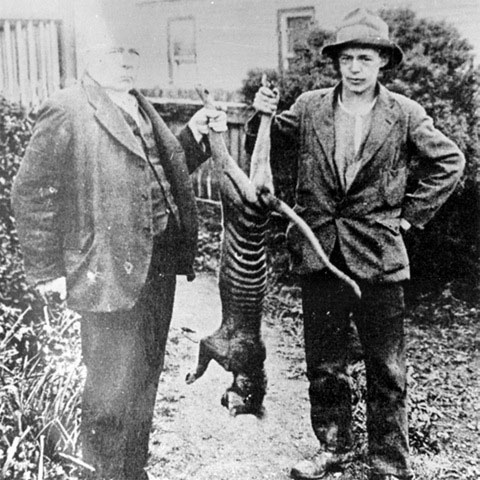 Different animal, same attitude Different animal, same attitude
.
[Source: ‘Tarkine mines could be last straw for Tasmanian devils’, 20130115, by Hamish McCallum, Head, Griffith School of Environment at Griffith University, ^http://theconversation.com/tarkine-mines-could-be-last-straw-for-tasmanian-devils-11483]
.
Feb 2013: Tony Burke refuses Tarkine heritage listing
.
In December 2009, with wide recognition of its National Heritage values, The Tarkine was granted Emergency National Heritage listing by former Federal Environment Minister Peter Garrett, however this lapsed in December 2010 .
Despite the Australian Heritage Council (AHC) already recommending a 433,000 hectare National Heritage Area, Minister Burke has instructed the AHC to reassess the Tarkine. The reassessment deadline was extended to December 2013.
<<..Despite a 2010 Australian Heritage Commission recommendation for the listing of 433,000 hectares of the Tarkine, Mr Burke said on Friday he would only recognise its Aboriginal heritage.
Mr Burke said he had tried to find a boundary that would incorporate the natural values without delivering unacceptable social and economic outcomes.
”I simply haven’t been able to find a way to recognise the natural heritage values with a boundary that will find a balance,” he said. ”For this reason I have decided to only put the indigenous values on the national heritage list.”
Mr Burke said he acknowledged that his decision was not the outcome for the Tarkine that many groups were seeking. He said part of the Tarkine’s coastline would be entered on the National Heritage List as the Western Tasmania Aboriginal Cultural Landscape.
The decision was warmly backed by the local MHR and parliamentary secretary for Agriculture, Fisheries and Forestry, Sid Sidebottom. ”Minister Burke has listened carefully to my representations on behalf of our region, and to the delegations of union members – particularly from the Australian Workers Unions – and of my local mayors,” Mr Sidebottom said.
The AWU under secretary Paul Howes mounted an ”Our Tarkine – Our Future” campaign promoting job opportunities in the region.
The move drew praise from a local MP, but sparked an angry response from Greens leader Christine Milne, who said the Minister had ”abandoned the Tarkine to the mining and timber industries”. Ms Milne said she was ”devastated”: ”If anyone has any doubt as to who is running the environment portfolio in Australia the answer is very clear: the mining industry.
”I have been campaigning for the Tarkine for a very long time . . . Tony Burke has completely sold out the environment for logging and mining.”
She called on Mr Burke to release the heritage council’s latest recommendations, made in a report to the government last December. >>
.
[Source: ‘No’ to Tarkine environment listing’, 20130208, by Andrew Darby (Hobart correspondent for Fairfax Media) with Jonathan Swan, ^http://www.smh.com.au/environment/no-to-tarkine-environment-listing-20130208-2e2bo.html]
.
Apr 2013: Conservationists find a qualified doctor to save the wounded Tarkine
.
<< Mining in Tasmania’s Tarkine region is being challenged as conservationists take their battle to the federal court.
The Tarkine National Coalition has lodged a case in the Federal Court seeking a review on Federal Environment Minister Tony Burke’s decision approving Shree Minerals iron ore mine.
Campaign co-ordinator Scott Jordan said Burke approved the mine without knowing the impacts it could have on the endangered Tasmanian devil.
“We will argue that Minister Burke has not acted in accordance with the provisions of the Environmental Protection and Biodiversity Conservation Act, and as such the approvals granted are invalid,” Jordan said. “This mine should not have received approval, and we are asking the court to rule against it. “
Debate erupted over the application for mining developments in the region last year, with Federal Environment Minister Tony Burke rejecting a National Heritage listing for the area.
Debate continues to rages between environmental groups who want mining developments halted and companies and potential employees who say opening up the Tarkine region to mining is crucial in the future economic prosperity of Tasmania.
Earlier this year, Tasmania’s Premier Lara Giddings said three new mining projects were expected in the region following Burke’s rejection of the National Heritage listing.
Giddings said she expected Venture Minerals’ proposal for a $200 million tin mine at Mount Lindsay to be approved, creating 1000 jobs.
She said that developments like Venture’s Riley Creek mine and the approved Shree Metals mine at Nelson Bay were signs that mining investment would grow in Tasmania now that the “dark cloud” of the Tarkine national heritage nomination had been removed.
Environmentalists argue that open-cut mining will destroy the area and say that any decision to expand mining will result in irreversible contamination. >>
.
[Source: ‘Federal Court fight to stop Tarkine mine’, 20130404, by Vicky Validakis, Mining Australia, ^http://www.miningaustralia.com.au/news/federal-court-fight-to-stop-tarkine-mine]
.
Desperate times again drive Tasmanians to burn their house to stay warm
.
<< The Deputy Premier has defended the Labor-Greens Government at a pro-development and pro mining rally in north-west Tasmania.
The Unlock Tasmania Rally in Smithton yesterday heard from eight industry speakers, including representatives from the mining industry, and the Farmers and Graziers Association.
Organiser Joan Rylah estimates more than 3,000 people attended. Ms Rylah says the State Government has been influenced by minority fringe groups, while the majority’s concerns have been ignored. “These people are feeling that they have not been heard,” she said.
The Deputy Premier Bryan Green also addressed the crowd. He says times are tough, but the minority government is not to blame.
[Ed: Yes it is]
“It is an easy target,” he said. Mr Green says he shares the crowd’s frustrations at the court injunction launched by conservationists, banning work at the Shree Minerals mine at Nelson Bay River in the Tarkine until a legal hearing next week. >>
.
[Source: ‘North-west rally backs development’, 20130624, ABC, ^http://www.abc.net.au/news/2013-06-24/pro-miners-rally-for-development/4774734?section=tas]
.
Jul 2013: Court overrules Burke’s Bias
.
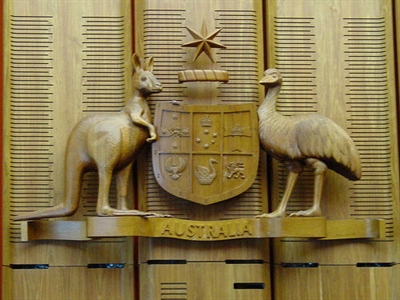 Federal Court of Australia
~ such an apt emblem Federal Court of Australia
~ such an apt emblem
.
<< A conservation group (Save the Tarkine) has stopped an open cut iron ore mine in Tasmania’s Tarkine region which it says threatened the Tasmanian devil. The Federal Court has ruled that the Federal Environment Minister’s approval of Shree Minerals’ open cut mine at Nelson Bay River was invalid.
Then minister Tony Burke approved the mine last December, imposing nearly 30 conditions to protect the devil and other threatened species.
The far north-west is considered one of the last disease-free areas for the state’s devil population.
Environmental group Save the Tarkine sought a judicial review of the decision, arguing Mr Burke did not act in accordance with the Environment Protection Act.

The group’s Scott Jordan was in the Federal Court in Melbourne to hear the judgement.
“It’s a great day for the Tarkine and it’s a great day for the Tasmanian Devil that was placed under threat by this mining proposal,” he said. “The Minister’s been given a clear message; that short cuts to get mines over the line in the Tarkine won’t be tolerated.”
Save the Tarkine has flagged it will continue to fight any other proposed mines in the area.
“They shouldn’t be taking short cuts to get mining projects up like the Tarkine. This is an area that shouldn’t be mined,” Mr Jordan said.
The $20 million project was expected to employ 70 workers and was the first mine approved in Tasmania in 26 years.
A spokesman for the new Federal Environment Minister, Mark Butler, says the decision is being examined. “The Minister will carefully consider the court’s decision before proceeding further,” he said.
.
Ruling disappoints Tasmanian Premier and local Circular Head Mayor
.
Tasmania’s Premier Lara Giddings says it is disappointing.
“We would have hoped to have seen Shree Minerals go ahead,” she said.” “We see it as economically sustainable, environmental sustainable and important investment that will help create jobs in the mining industry. “We will now of course review the Federal Court decision and see what Government can do to assist that company.”
Circular Head mayor Daryl Quilliam has called it a sad day for the whole state. “While I respect the court’s decision…I just think it gives any investors who want to invest in Tasmania, probably puts a query for them and whether they’re going to continue to invest in Tasmania,” the mayor said.
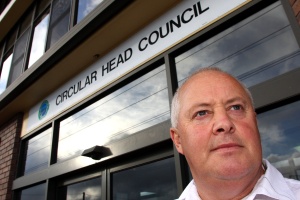 Circular Head mayor Daryl Quilliam
Same Baby Boomer age group, same Baby Boomer mindset Circular Head mayor Daryl Quilliam
Same Baby Boomer age group, same Baby Boomer mindset
.
Despite the ruling, he is optimistic Shree will proceed with its plans. “I expect that they’ll have to deal with some issues that have been raised by the court and I wouldn’t expect that it’ll knock it in the head completely.” “But it will certainly slow up the process and I just hope that they continue on and do whatever is necessary to make it valid.”
Tasmanian Liberal Senator Eric Abetz says most sensible Tasmanians would want the mine to go ahead.
“It is important for our state to harness our mineral wealth and our forestry wealth and the Government has been busy in destroying job opportunities in both areas and in the one area where they’ve made an exception, they’ve mucked it up,” he said.
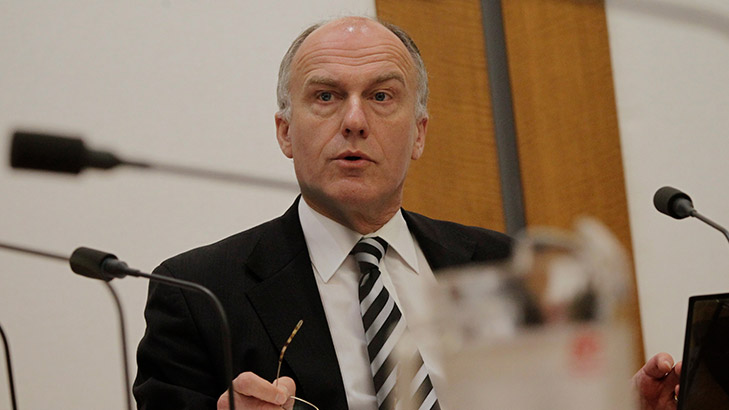 Tasmanian Eric Abetz MP
Same Baby Boomer age group, same Baby Boomer mindset Tasmanian Eric Abetz MP
Same Baby Boomer age group, same Baby Boomer mindset
.
The Commonwealth will pay the legal bill from the court challenge. >>
.
Read Federal Court Ruling:
.
Case Citation: ‘Tarkine National Coalition Incorporated v Minister for Sustainability, Environment, Water, Population and Communities [2013] FCA 694’
^http://www.judgments.fedcourt.gov.au/judgments/Judgments/fca/single/2013/2013fca0694
.
[Source: ‘Federal Court ruling halts Shree Mineral’s $20m Tarkine mine’, 20130717, by Zoe Edwards, ^http://www.abc.net.au/news/2013-07-17/court-decides-tarkine-mine27s-fate/4825230]
.
The industrial fight persists to exploit the last of Natural Tasmania
.
<< The Federal Court’s decision to halt work on an iron ore mine in Tasmania’s remote Tarkine region has spooked the industry, but the State Government has vowed to help fight it.
In December, the then Federal Environment Minister Tony Burke approved $20 million plans by Shree Minerals to build an open cut mine in the north west, the last disease-free stronghold of the Tasmanian devil.
Justice Shane Marshall has upheld a claim by the lobby group Save the Tarkine that Mr Burke did not properly take into account conservation advice about the endangered species and ruled its approval invalid.
Terry Long of the Minerals Council says it could scare off potential investors. “It’s been challenged on a detail in the court and knocked over. So from Tasmania’s point of view it’s a worry into the future, I mean it’s going to be difficult to get people to take on projects in the state under the circumstances.”
But Tasmania’s Resources Minister, Bryan Green, is viewing the ruling as a setback that can be resolved easily. Mr Green says he will be asking the new Environment Minister, Mark Butler, to quickly reconsider the project, taking into account the conservation report on the Tasmanian Devil. “This is a setback but it’s not the end of the process by any stretch of the imagination.
“Because from what I can see, based on the Federal Court’s decision, other than this administrative error the approvals process is sound,” said Mr Green.
The Premier Lara Giddings believes the mining proposal is economically and environmentally sustainable. “We will now of course now review the Federal Court decision and see what Government can do to assist that company to be able rectify any problems that the Federal Court has identified and ensure we can get that investment back on the right track,” said Ms Giddings.
The Greens leader Nick McKim does not think the Federal Court decision paints Tasmania as a risky place to invest. “The decision says nothing about the investment environment in Tasmania and says everything about the need for the Commonwealth Minister to follow a lawful process,” he said.
.
Jobs blow for struggling region
.
The mine was expected to employ seventy workers. The earthmoving contractor, Rodney Collins, says he employs 10 people and was looking to recruit more. He says the court’s decision is a kick in the guts. “You know there’s (sic) thirty new people who can’t have a job and at the moment after today we don’t know what we’re going to do with the people working for us at the moment,” he said.
Another three Tarkine mining projects are awaiting approval. Shree Minerals says it “followed the approval process to the letter of the law and beyond, with the best possible scientific advice. “For the project to be set aside on appeal is disappointing in the extreme.”
The (new) Environment Minister replacing Tony Burke, Mark Butler MP, now with the title Minister for the Environment, Heritage and Water; says he is carefully considering the court’s ruling before deciding his next step. >>
.
[Source: ‘fight-to-restore-tarkine-mine-approval, 20130717, ABC, ^http://www.abc.net.au/news/2013-07-17/fight-to-restore-tarkine-mine-approval/4826860]
.
Tasmanian Minerals Council can’t help itself’
.
<< Calls by Tasmanian Minerals Council chief Terry Long, Tasmanian Deputy Premier Bryan Green and Braddon MP Sid Sidebottom for some kind of technical or administrative fix to yesterdays Federal Court decision to set aside approvals for the Nelson Bay River mine in the Tarkine, are both uninformed and an example of the kind of corrupted process that resulted in the Federal Court decision.
“The failure of the Minister and his department to consult the Approved Conservation Advice was not an administrative oversight. The Approved Conservation Advice is the key source of advice on which the Minister must rely to determine how best to protect the Tasmanian devil in any assessment,” said Save the Tarkine Campaign Coordinator, Scott Jordan.
“You can’t just add it to the appendix after the event and publish the same decision. The court didn’’t say the Minister forgot to list it, it actually said the Minister failed to consult it at all,”
“The comments by Long, Green and Sidebottom show an example of trying to solve a problem by repeating the action that created it”.
“The Minister must either let the court decision stand as the final judgement, appeal to the full bench of the Federal Court, or go back to the start of the process and conduct a proper legal assessment. Anything short of this will end up back before a court on exactly the same grounds”. >>
[Source: ‘No quick fix for Tarkine mine’, 20130718, media release by Scott Jordan, Campaign Coordinator, Save the Tarkine]
.
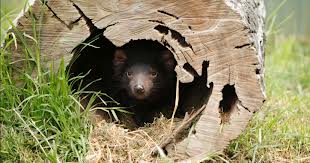
.
Further Reading:
.
.
.
.
.
.
.
.
.
.
Tags: baby boomer, Babyboomer Middle-Aged Men, Nelson Bay River, Robber Baron, Save the Tasmanian Devil Programme, Tarkine National Coalition, Tarkine wilderness, Tasmania, Tasmania's Tarkine, Tasmanian Devil, The Tarkine
Posted in + Wild Tasmania, Tasmania (AU), Threats from Mining, Threats to Wild Tasmania | No Comments »
Add this post to Del.icio.us - Digg
Thursday, May 16th, 2013
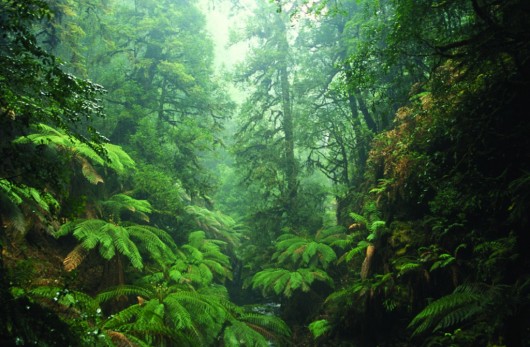 Arthur River Rainforest in Tasmania’s Tarkine
[Source: Photo by Ted Mead, ^http://tarkine.org/) Arthur River Rainforest in Tasmania’s Tarkine
[Source: Photo by Ted Mead, ^http://tarkine.org/)
.
.
Mar 2013: Savage River tailings spill exactly why we shouldn’t have new mines in the Tarkine
.
<The EPA announcement that an acid forming tailings spill has occurred at the Savage River Mine is evidence of the risks posed to the Tarkine by proposed new mines.
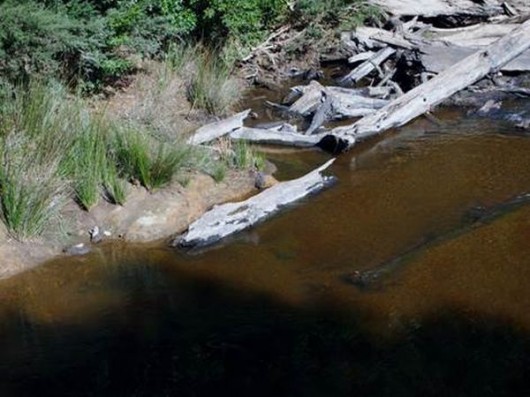 Savage River Mine tailings spill into Tasmania’s wild Pieman River
[Source: ‘‘I have never seen anything like it’, 20130325, by Isla MacGregor, Tasmanian Public and Environmental Health Network,
in Tasmanian Times, ^http://tasmaniantimes.com/index.php?/weblog/article/i-have-never-seen-anything-like-it/] Savage River Mine tailings spill into Tasmania’s wild Pieman River
[Source: ‘‘I have never seen anything like it’, 20130325, by Isla MacGregor, Tasmanian Public and Environmental Health Network,
in Tasmanian Times, ^http://tasmaniantimes.com/index.php?/weblog/article/i-have-never-seen-anything-like-it/]
.
Tarkine National Coalition Campaign Coordinator, Mr Scott Jordan:
“The mining industry has been telling us that modern mines are safe and environmentally sound, and yet here we have evidence that even with the best of intentions from an award winning operator, there is always unacceptable risks. Accidents can and will happen, and the environment will suffer the costs”.
TNC are urging a EPA to make their investigation transparent and to make the findings public. >>
.
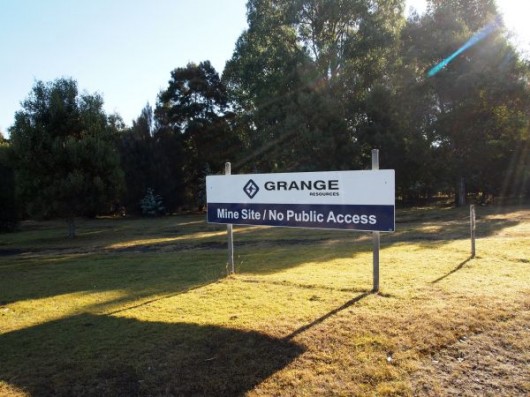 Grange Resources, Savage River Mine
Recklessly destroying and polluting The Tarkine
thanks to disinterested approval by selfish old men Babyboomer politicians in Hobart Grange Resources, Savage River Mine
Recklessly destroying and polluting The Tarkine
thanks to disinterested approval by selfish old men Babyboomer politicians in Hobart
.
Mar 2013: Statement of Reasons sought on Tarkine Heritage decision
.
<<Community advocate to save The Tarkine, the Tarkine National Coalition, has written to Federal Environment Minister Tony Burke and formally sought statement of reasons relating to the Tarkine National Heritage decision. The request is pursuant to Section 13 of the Administrative Decisions (Judicial Review) Act 1977.
Under the Act, upon request the Minister must provide a statement of reasons within 28 days of the request being made.
The TNC is still awaiting a statement of reasons relating to the Nelson Bay River mine approval, and last week instructed solicitors to write again to the Minister to alert him to his legal obligations.
Mr Scott Jordan:
“We have a view that the decision to not heritage list the Tarkine was not based on the evidence before the Minister. There are no documents that have been released supporting the case to not list the area, and so we are very keen to see the Minister’s reasons for this decision”.
The Australian Heritage Council recommended a 439,000 hectare National Heritage Listing.>>
.
 . .
Mar 2013: CNN names Tarkine first in CNN’s world’s last great wilderness areas
.
<<The Tarkine has been named first in CNN’s list of the world’s last great wilderness areas. Tarkine National Coalition has welcomed this international recognition of the Tarkine’s wilderness values.
Mr Scott Jordan:
“CNN has confirmed what we have known all along. The Tarkine is a remarkable and unique place that deserves to be listed as one of the worlds great wilderness assets. The challenge now is for our state and federal governments to ensure that the Tarkine is protected through National and World Heritage listing”.
Over the past decade the Tarkine has delivered on the jobs front, with visitor numbers and Tarkine related jobs growing even in the current national downturn.
“The Tarkine continues to grow it’s reputation as a premier tourist destination. The new mines proposed will kill the golden goose”.>>
.
Feb 2013: Watering down of mine permit conditions unacceptable
.
<<The Tarkine National Coalition has received written notice that Circular Head Council has “deleted” a permit condition aimed at providing protecting watercourses on the Nelson Bay River proposed mine site.
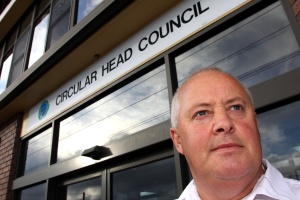 Circular Head Mayor Daryl Quilliam
(a Babyboomer…) Circular Head Mayor Daryl Quilliam
(a Babyboomer…)
.
The deleted condition stated ‘Apart from the creation of the site’s access, no building works or vegetation clearing shall occur within 30 metres of a watercourse’.
Mr Scott Jordan:
“Here we have a council who is hell bent on doing whatever it takes to get a mine up in the Arthur Pieman Conservation Area, and the environment be damned. The Nelson Bay River and it’s catchment creeks provide drinking water to local wildlife, including threatened species like the Tasmanian devil and Spotted tailed quoll. It also discharges just 5 km downstream into the shack community of Nelson Bay, a popular fishing and crayfishing location”.
“It appears the rules don’t apply if you are a mining company. Before they’ve even commenced operations Shree Minerals is calling the shots and dictating the rules”.
The Nelson bay River proposed mine sits within the area the Australian Heritage Council recommended as a 439,000 hectare Tarkine National Heritage Listing.>>
.
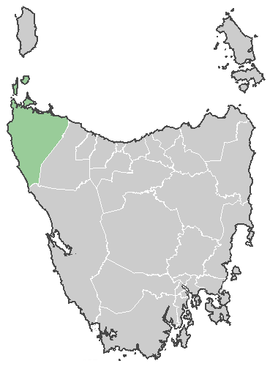
.
Feb 2013: Minister fails to comply with legal requests
.
<<Federal Environment Minister Tony Burke has failed to comply with a legal request for a Statement of reasons pursuant to Section 13 of the Administrative Decisions (Judicial Review) Act 1977. Tarkine National Coalition had formally sought statement of reasons relating to the EPBC approvals for the Nelson Bay River mine. ‘
Under the Act, upon request the Minister must provide a statement of reasons within 28 days of the request being made. This period expired on 18th February.
 Federal Environment Minister Tony Burke Federal Environment Minister Tony Burke
.
The TNC has instructed solicitors to write again to the Minister to alert him to his legal obligation and again request the statement of reasons.
Mr Scott Jordan:
“There are serious concerns with the Minister’s complete disregard for the legal obligations of his portfolio. This combined with his inability to tell the truth leaves us with absolutely no confidence in this Minister”.
“The Minister made comment last night on ABC’s Lateline that the current Tasmanian Forest Agreement process would protect the Tarkine. The reserves proposed in this agreement would allow for new mining and exploration activity, a fact the Minister is aware of. He has kowtowed to the mining bosses and now wants to paint himself in a better light. Unfortunately the fact speak contrary to the Minister’s statements.”
Mr Jordan congratulated and thanked Australian Greens Senator Christine Milne for raising the plight of the Tarkine in her National Press Club address yesterday.
“Senator Milne has hit the nail on the head. Tony Burke is working against the public interest and for the mining bosses”.>>
.
 Mr Scott Jordan
Tarkine National Coalition
(Photo by Eliza Wood). Mr Scott Jordan
Tarkine National Coalition
(Photo by Eliza Wood).
.
[Source: Campaign Coordinator Scott Jordan, Tarkine National Coalition, PO Box 218, Burnie, Tasmania, 7320, ^http://tarkine.org/]
.
Tuesday, May 7th, 2013
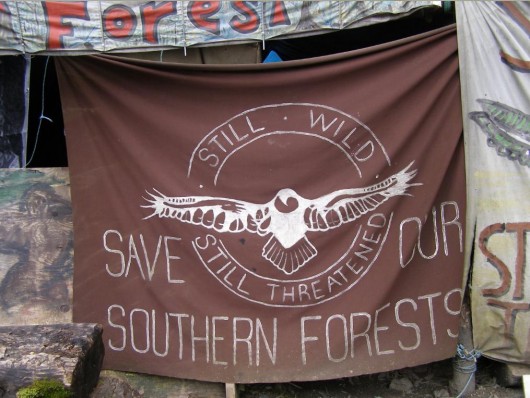 One of the last honourable environmental organisations fighting to save Tasmania’s Native Forests
Still Wild Still Threatened
^http://www.stillwildstillthreatened.org/ One of the last honourable environmental organisations fighting to save Tasmania’s Native Forests
Still Wild Still Threatened
^http://www.stillwildstillthreatened.org/
.
‘Mutant Legislation: a thinned out Tasmanian Forests Agreement
.
On the evening of 30th April 2013, Tasmania’s Parliament passed the Tasmanian Forests Agreement Bill 2012 into law.
The legislation formalises a revised agreement between selective Tasmanian environmental organisations, selective Tasmanian logging business associations, the Tasmanian Parliament and the Australian Government.
The original Inter-Governmental Agreement (IGA) signed by Prime Minister Julia Gillard and Tasmania’s Premier Lara Giddings on 7 August 2011 in Launceston. But instead of honouring the letter and spirit of the 2011 agreement to protect 572,000 hectares of Tasmania’s remaining high conservation forests protected, the resultant law has thinned out that protection down to a forest area of just 20% of the 572,000, to just 123,000 hectares.
Supposedly, the legislation proposes 500,000ha of reserves in 18 months’ time, providing the durability of the deal has been established. Weasel words and 76,000 of the 576,000 hectares of old growth sacrificed by those whom we entrusted to protect habitat.
The passing of the Bill was a culmination of a period of closed door negotiations between the selected environmentalists and the selected loggers. Despite compromising 80% of the high conservation forest, the legal outcome sees absolutely no compromise from the loggers. The loggers still stand to be compensated the same $276 million in federal restructure assistance, purported blowing out to $350 million, and that is on top of millions already forked out to exiting loggers.
The environmental signatories of forest betrayal in the deal include The Wilderness Society, the Australian Conservation Foundation, Environment Tasmania. The selected loggers were dominated by a certain Terry Edwards, chief executive of the Forest Industries Association of Tasmania (FIAT) and Glenn Britton, its chairman, both who stand to profit.
[Source: Act now on forest truce: PM’, 20130501, by AAP, in The Mercury (News Ltd), ^http://www.themercury.com.au/article/2013/05/01/378268_tasmania-news.html]
.
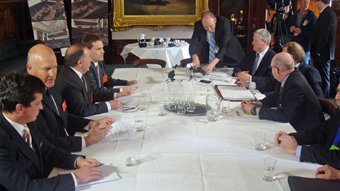 Three years ago in 2010, the Signatories to the Tasmanian Forest Statement
agreed on protecting the full 572,000 hectares
.
Ed: Suited up company men, but was any a Real Man? Three years ago in 2010, the Signatories to the Tasmanian Forest Statement
agreed on protecting the full 572,000 hectares
.
Ed: Suited up company men, but was any a Real Man?
.
“Compromise is usually a sign of weakness, or an admission of defeat.
Strong men don’t compromise, it is said, and principles should never be compromised.”
~ Andrew Carnegie
.
The destruction continues and so the protests will continue. Dumb outcome!
.
Two months prior on 4th March 2013, two conservationists were arrested at Tasmania’s Butlers Gorge as they tried to block logger access to three separate logging operations in an area nominated for World Heritage.
<<“Today’s peaceful protest has once again highlighted the ongoing destruction of Butlers Gorge. This area is significant habitat for endangered species and native wildlife. Still Wild Still Threatened have collected video evidence of Tasmanian devils and spot tailed quolls within Butlers Gorge and we are calling on Tony Burke to take action to protect these forests” said Ms Gibson.
“Two dedicated conservationists have today been arrested in order to bring attention to the hypocrisy of the Australian Government, who are allowing this logging to continue despite nominating these forests for World Heritage. (Federal) Minister Burke as a responsibility to protect the habitat of these endangered species and to protect these forests that he has nominated as World Heritage. We are calling on the Minister to enact Section 14 of the Environmental Protection and Biodiversity Conservation Act and bring an end to the destruction of these forests” said Ms Gibson.>>
[Source: ‘Two conservationists arrested at Butlers Gorge today’, Mar 5, 2013, Miranda Gibson, The Observer Tree, ^http://observertree.org/2013/03/05/media-update-two-conservationists-arrested-at-butlers-gorge-today/]
.
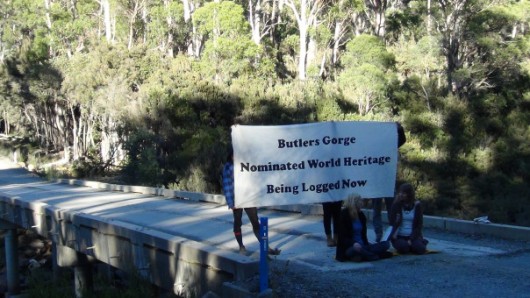 2nd March 2013: Local environmentalists protesting against the logging of World Heritage value old growth forests of Butlers Gorge
[Source: ^http://observertree.org/2013/03/05/media-update-two-conservationists-arrested-at-butlers-gorge-today/]
. 2nd March 2013: Local environmentalists protesting against the logging of World Heritage value old growth forests of Butlers Gorge
[Source: ^http://observertree.org/2013/03/05/media-update-two-conservationists-arrested-at-butlers-gorge-today/]
.
Ed: Real Tasmanians out there defending disappearing ancient forests – just a committed five on a remote bridge forming the last and only line of defence to prevent logging trucks, corporate loggers, and corrupt Tasmanian police who know the arsonists that set fire to peaceful Camp Flozza and to the forest west.
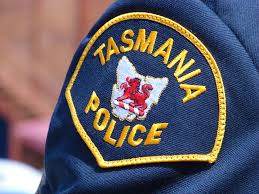 . .
<<The evil when loggers control forests is that logging vandalism rapes the timber from the forest ecology. It leaves behind scorched earth and trusting contractors who took out mortgages. When ecological management ascends to its rightful governance of native forests, the forest ecology thrives and permits at its fringes a viable high end cabinet industry.
But the low life corporate thieves and their immoral mercenaries are forced to inflict their hate and greed elsewhere. And then out of spite, Bob’s mercenaries set fire to the forest like a spouse scorned.>>
~ Tigerquoll, 20130327, Tasmanian Times, comment ^http://tasmaniantimes.com/index.php?/weblog/article/dear-bob-this-is-the-21st-century-/show_comments/
.
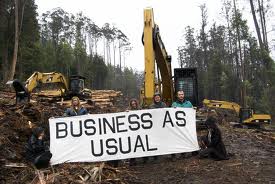 A Loggers Deal A Loggers Deal
.
3rd May: Conservation beliefs sacrificed down the drain
(analysis of the 2013 Forest Deal by Tasmanian author, Richard Flanagan)
.
<<So Julia Gillard has declared that she wants the parties who started the so-called Tasmanian forest peace process “to do everything they can to use their abilities to silence those who haven’t gone with the mainstream consensus”.
To silence.
I lived with the silence of Tasmania for too many years. And now the leaders of The Wilderness Society, Environment Tasmania, the ACF and the Tasmanian Greens have signed up to a deal that seeks to achieve what even Gunns failed in doing: silencing the rage Tasmanians felt with the destruction of their land and the corruption of public life that for a time became its necessary corollary. It is perhaps the greatest own goal in Australian political history.
For these environmentalists have managed to negotiate a deal that extraordinarily manages to resuscitate at vast public subsidy (reportedly $350 million) the worst aspects of a dead forest industry employing less than a thousand people; lock in social conflict for another decade; empower in Forestry Tasmania a rogue government agency that sees itself as the real power on the island and which works to undermine governments; and delivered the island to political stagnation by ensuring forestry remains the island’s defining political issue.
If this wasn’t grotesque enough the Federal Government’s National Audit Office’s report into the mishandling and misspending of some of the early rounds of this money by Tasmanian government instrumentalities can give the Australian taxpayer every confidence that much of the rest of the $350 million will be misspent, misdirected and misused. Taxpayers can also be assured that if past government bail-outs of the Tasmanian forest industry are any guide, a not insignificant sum of their money will end up funding political groups and campaigns seeking to promote the self-serving interests of a Soviet style industry by entrenching division and stymying political debate and economic change in Tasmania. Some millions of dollars allocated for ‘communications’ will no doubt communicate very well just one message about Tasmania’s logging industry.
And all this in return for what?
The only environmental outcome that is locked in was one already in place: the 123,000 hectares of World Heritage Area secured by Bob Brown and Christine Milne in negotiations with Tony Burke in February. And this in the face of initial opposition from NGO negotiators who worried it might damage their forest deal process. Nick McKim’s claim that there was “legislated protection from logging for over 500,000 hectares”, is misleading. There is a moratorium on logging in those high conservation value forests that could fall over at any time, and almost certainly will.
 Richard Flanagan
(Author of this extracted article)
[Source: Photo by Colin Macdougall, Tasmanian Times,
^http://tasmaniantimes.com/index.php?/weblog/article/i-dont-agree/] Richard Flanagan
(Author of this extracted article)
[Source: Photo by Colin Macdougall, Tasmanian Times,
^http://tasmaniantimes.com/index.php?/weblog/article/i-dont-agree/]
.
Astonishingly, in a day that will become historic in their own annals, the environmentalists’ leaders have managed to split their own movement in a way that will take many years for it to recover from. The greatest sadness is that it locks Tasmania into a conflict it should have ended.
Beyond that there is only what State Greens leader Nick McKim and Environment Tasmania head Phill Pullinger have called ‘pathways’ to future environmental outcomes.
.
Pathways? What is a pathway? Is it a forest? Is it a job?
.
Well, no, it’s nothing really, just a confusion of two words, management babble disguising the truth that everything else is but a promise that may or may not happen later.
The formal protection of areas as reserves and national parks will not begin until October 2014, and then only if conservationists meet conditions that realistically will never be met.
Of the many disturbing aspects of the deal, perhaps the most grotesque is the already infamous ‘durability’ clause, under which conservation leaders sitting on a special council with loggers are expected to police and silence conservationists who protest. If they fail to silence their own, the deal is seen to have failed its durability criteria and new reserves promised in the deal do not go ahead and return to the loggers. But of course people will protest and they will be right to protest. The only thing the deal guarantees is the conservation movement at war with itself. Some deal. Some durability. The conservationists’ leaders may as well have self-immolated at the foot of Parliament House.
The second condition is that the forestry industry achieve Forestry Stewardship Council accreditation for its logging — something the industry spat on when conservationists urged it several years ago. Given its abysmal record and third world practices along with inevitable community opposition, this seems as likely as Julia Gillard winning The Voice. But the condition locks in those conservation groups that are signatories to the deal to campaigning for the industry’s logging practices, no matter how dreadful they are, in order to keep alive the promise of saving the forests.
Compounding these perversities there is the simple matter of power. By October 2014, all observers expect Liberal governments to be in power in both Tasmania and federally. In Tasmania the Liberal Party has been explicit that it will tear up the agreement. What then of the moratorium? Well it ends with those areas being once more logged using taxpayer subsidies.
Many fear that both governments will endorse and subsidise a grotesque new forest industry that logs native forest to fuel forest furnaces—so called bio-mass electricity generators — that could by government fiat be defined as a renewable energy source.
Such then is the pathway chosen.
It is possible for good people for the best of reasons to sometimes do the worst of things. If the integrity of the leaders of the environmental NGOs and the Tasmanian Greens Party should not be questioned, their judgement certainly can. Full credit though must go to Terry Edwards of the Forest Industries Association of Tasmania, Evan Rolley running the dubious state-subsidised Malay-owned Ta Ann, and Bob Gordon and Bob Annells at Forestry Tasmania. From a position of almost complete defeat they have returned the forestry industry to its pre–eminent position in Tasmanian public life and persuaded the environment movement to destroy itself. With bluster, flattery, bullying, and dogged persistence they have achieved the near impossible.
But if you care about the environment in Australia you will henceforth have to ask whether The Wilderness Society and the Australian Conservation Foundation any longer serve your interests. Will they in the future question and campaign against corporate power or will they side with it as they have in Tasmania, recently trooping off to Japan to promote the Malay forest veneer company Ta Ann’s products? Will they stand up to governments or will they be seduced by their attentions, believing the flattering lie that their way is the way of environmental politics in the future?
While nationally the Greens Party under Christine Milne has been resolute in defending the environment and Tasmania’s forests, Tasmanian environmentalists would be right to ask if the Tasmanian parliamentary Greens (other than Kim Booth who showed courage in voting against the bill and his party) any longer particularly represent their interest or aspirations. At the forthcoming state election there would be many reasons for environmentalists to not vote Green and very few to support them. In their determination to achieve respectability, they seem to have become simply the third aspect of a conservative Tasmanian polity with no ideas or vision for the future. Could it be, that for Nick McKim, the decision to support the package proves his Meg Lees moment? [Ed: In 1999, Democrats leader Meg Lees sided with then PM John Howard to enable his GST law to be passed, broadly viewed as a decision of betrayal that instigated the eventual downfall of the Democrats].
Julia Gillard’s celebration of the peace deal and her call for silencing came on May Day, the day that celebrates all those who went against the ‘mainstream consensus’ that workers shouldn’t be paid a living wage, that workers shouldn’t be treated with respect and dignity. Democracy is about many things, but silence and silencing are the death of democracy.
The forest peace deal was born in ignominy, with Gunns seeking to set up a native-forest-for-pulp-mill swap, a fact denied by environmental leaders at the time but acknowledged by Premier Lara Giddings in parliament. It continued in secrecy and was oiled with evasions, and concludes as a tragedy for Tasmania. Somehow, the conservationist leaders—instead of using the commercial death of the logging industry, changing social values, and new ideas of a renascent Tasmania to help build a different, better and united society — have condemned us all to endlessly repeat the sadness of recent decades.
I am writing this for all the people who for the last thirty years have stood up again and again against the Tasmanian ‘mainstream concensus’— who stood up for the land they loved and for an idea of a better Tasmania. They have watched, ever more distraught, as their battle has culminated in the last three years of secret deal making that has sold their sacrifices and beliefs down the drain.
At the end the only certainty and hope I have is this: I never signed up to the forest deal, not then and certainly not now. I don’t give a damn for durability clauses and special councils of loggers and conservation police. And I didn’t agree to be silenced, not by Paul Lennon, not by Gunns, and I won’t be now by The Wilderness Society and the ACF.
And in all this, I know I am very far from alone.>>
[Source: ‘I don’t agree’, by Tasmanian author Richard Flanagan, 20130503, Tasmanian Times, ^http://tasmaniantimes.com/index.php?/weblog/article/i-dont-agree/]
.
[Ed: Hear, hear!]
.
1st May: Forest advocates have become the greenwash industry brigade
(analysis of the 2013 Forest Deal by honourable Tasmanian Environmentalists)
.
Honourable environmental organisations in Tasmania have vowed to up the ante on forest protests after the passing of the 2013 Tasmanian Forests Law.
Groups on the outside of the tent for the peace talks, including Still Wild Still Threatened and The Huon Valley Environment Centre, said this morning they would continue to campaign against the state’s forestry industry.
“We are absolutely committed to continue to protest and take action for these forests,” Still Wild Still Threatened spokeswoman Miranda Gibson said. “These forests, while they are continuing to fall, the community will stand up and … communicate to the markets about what is happening in Tasmania.”
Ms Gibson, who recently ended a marathon tree-sit in southern Tasmania, and Huon Valley Environment Centre’s spokeswoman Jenny Weber said the TFA provided no guarantees for future reserves.
.
“A bill that lacks conservation assurances
and props up a collapsing and unviable destructive native forestry industry.”
.
The legislation underpinning the deal, which passed the Tasmanian Parliament yesterday, proposes 500,000ha of reserves in 18 months’ time, providing the durability of the deal has been established.
Ms Weber said environmental organisations not associated with the ‘Agreement’ could deliver better outcomes than the environmental signatories.
“The legislation yesterday saw a very large void come in the environment movement,” she said. “We have seen environment groups vacate the space as forest advocates and move into becoming the greenwash industry brigade.”
The bill passed in Tasmania’s House of Assembly yesterday is primarily yet another industry lifeline and has betrayed the environment.
Grass-roots environment organisations have been left stunned that a bill that lacks conservation assurances and props up a collapsing and unviable destructive native forestry industry has passed with support of some Greens parliamentarians.
Still Wild Still Threatened and Huon Valley Environment Centre have renewed their commitment to forest protection advocacy in all forms.
Huon Valley Environment Centre’s spokesperson Jenny Weber stated, “Today we are far from assurances of protection for Tasmania’s wild forests. The passing of this legislation, that is very pro-industry with merely a conservation veneer, does not deliver any upfront forest reserves.
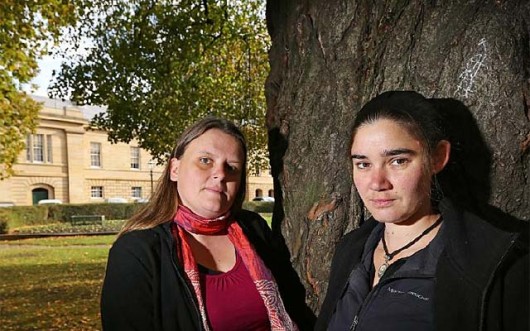 Environmental Activists Jenny Weber, left, and Miranda Gibson
outside Tasmania’s Parliament House, Hobart, 20130501
[Source: Photo by Sam Rosewarne, The Mercury,
^http://www.themercury.com.au/article/2013/05/01/378238_tasmania-news.html] Environmental Activists Jenny Weber, left, and Miranda Gibson
outside Tasmania’s Parliament House, Hobart, 20130501
[Source: Photo by Sam Rosewarne, The Mercury,
^http://www.themercury.com.au/article/2013/05/01/378238_tasmania-news.html]
.
Logging will continue inside the proposed reserves, as there are areas of forest that were excised from the proposed reserves to meet the logging schedule.
“This legislation fails the wild forests, and we will be there to provide scrutiny of a forestry industry that has not made any commitment to changing environmentally destructive practices,” Jenny Weber said.
Still Wild Still Threatened spokesperson Miranda Gibson stated:
“In response to the Forest Bill passed by the House of Assembly yesterday, the Huon Valley Environment Centre and Still Wild Still Threatened have vowed to continue to campaign for Tasmania’s forests. The legislation entrenches and props up the unviable native forest industry and ongoing logging of high conservation value forests, while making the attainment of new reserves virtually impossible. Conservation outcomes have been undeniably sidelined. Those groups and members of the Tasmanian State Greens who have supported this bill have aligned themselves with the collapsing forestry industry at the expense of our forests.”
.
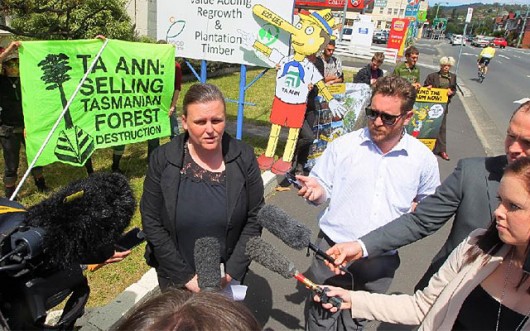 Jenny Weber of The Huon Valley Environment Centre
talking to the media at a protest outside foreign corporate logger, Ta Ann’s Hobart headquarters (October 2012.)
[Source: ^http://www.themercury.com.au/article/2012/11/07/365524_tasmania-news.html] Jenny Weber of The Huon Valley Environment Centre
talking to the media at a protest outside foreign corporate logger, Ta Ann’s Hobart headquarters (October 2012.)
[Source: ^http://www.themercury.com.au/article/2012/11/07/365524_tasmania-news.html]
.
Huon Valley Environment Centre’s Jenny Weber:
“We are alarmed by the threat to curtail freedom of speech and the rights of protest out of yesterday’s legislation, which attempts to blackmail the community into silence by holding forests at ransom. These are undemocratic tactics to silence the voice of the community and benefit the forestry industry. The new clause provides the opportunity for either House of Government to determine what constitutes a failure of durability, including substantial active protests or substantial market disruption, and once that determination is made, reserves do not proceed.”

“When one wades through all the spin being propagated by parliamentarians and signatories to the TFA, forestry in Tasmania is at the point where it continues to drain public resources and destroy irreplaceable ecosystems. It has tarnished Tasmania’s brand by not recognising the value of unique native forests and by maintaining unsustainable resource management practices coupled with a wasteful and irresponsible on-the-ground approach. If that wasn’t enough, they have created a green-wash industry for Hamid Sepawi’s Ta Ann and those connected with Sarawak timber mafias and human rights violators. What is clear out of this process is that Ta Ann has received ongoing parliamentary support in Tasmania and now a green-wash tick from some environment groups. We will continue to oppose the ongoing operations of this company in Tasmania and Sarawak.”
“As The Wilderness Society, Environment Tasmania and the Australian Conservation Foundation are now committed to forsaking the role of forest advocacy and have become the green-mouthpiece for a forestry industry, who yesterday claimed they got everything they wanted out of the of the TFA process and consistently refuses to make necessary changes to their out-dated, destructive and reprehensible practices, our organisations will redouble our efforts to campaign for the protection of intact natural ecosystems.”
.
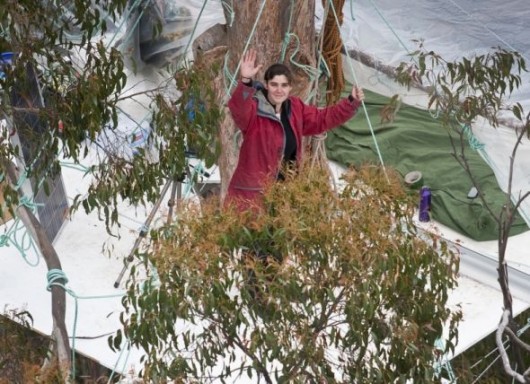 Miranda Gibson in ObserverTree
^http://observertree.org/ Miranda Gibson in ObserverTree
^http://observertree.org/
.
Still Wild Still Threatened’s Miranda Gibson:
“The native forest industry is not economically viable when left to stand on it’s own two feet. Yet, the House of Assembly has just passed a bill that will continue to prop up this out-dated and unviable industry with tax payer funds whilst disregarding community concerns and scientific recommendations for forest protection.”
“It is delusional to believe that this bill will deliver adequate forest protection. Hundreds of thousands of hectares of verified high conservation value forests are being held to ransom, with protection subject not only to durability measures at the whim of both houses of Tasmania’s parliament, but also dependent on FSC certification. Under this bill high conservation value forests will continue to fall and human rights violations tacitly accepted. As long as they do, we will continue stand up for those ecosystems, forests, communities and cultures that are threatened.”
.
[Source: Miranda Gibson spokesperson for Still Wild Still Threatened, and Jenny Weber spokesperson for Huon Valley Environment Centre, ^http://www.stillwildstillthreatened.org/current-news/media-release-1.05.13-long-haul-tasmanian-forest-protection-delivered-if-ever…]
.
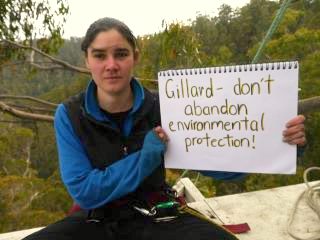 . .
“We are absolutely committed to continue to protest and take action for these forests.”
~ Still Wild Still Threatened spokeswoman Miranda Gibson.
.
1st May: Let’s not pretend agreements come from a small number of people who hold up a sign.
(Australia’s Federal Environment Minister, Tony Burke)
.
<<‘Let’s not pretend that you’re ever going to get an agreement that will stop there from being a group of… you know… a small number of people who hold up a sign.
But let’s also not forget that in this group you’ve got the Australian Conservation Foundation, the Wilderness Society and Environment Tasmania as the ‘umbrella group’ and you’ve got all of those groups on side with the Agreement, it means you cannot get an effective market campaign that wll damage the Australian market any more. And that… is a massive shift. And when you take out all the peak groups and have all of them on-side with the Agreement, that makes a massive difference to markets for Tasmania.
You’ll get the odd skirmish from small minor… minor groups and things like that. Yeah and I don’t want to set a silly threshold. What we have seen from the last thirty years – ends tonight. And that is something to celebrate.”
.
[Source: ‘Christine Milne: ‘Picking over a dead carcass’, via David Obendorf, Tasmanian Times, 20130501, ^http://tasmaniantimes.com/index.php?/weblog/article/christine-milne-picking-over-a-dead-carcass]
.
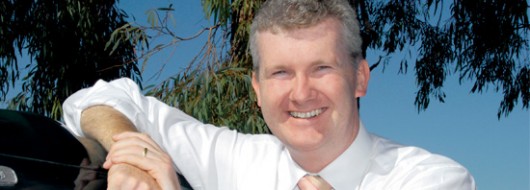 Tony Burke – a smiling eco-assassin
Tony Burke – a smiling eco-assassin
.
[Ed: Populist utilitarian politicking that foresakes deontological ethics is cowardly. It serves the preservation of one’s vested interests, leaving behind a sullied reputation in the minds of ordinary people. Burke has shown himself to be but a smiling eco-assassin, perhaps eyeing his polly pension before September.
.
Burke is clearly ignorant of the magic of Margaret Mead who famously said:
“Never doubt that a small group of thoughtful, committed, citizens can change the world. Indeed, it is the only thing that ever has.”
.
..and who also famously said..
.
“Never depend upon institutions or government to solve any problem. All social movements are founded by, guided by, motivated and seen through by the passion of individuals.”]
.
1st May: It is the carcass of that Agreement..people picking over the scraps, deciding what can be salvaged or not
(Australian Greens Senator Christine Milne)
.
<<What started out as a process to exit native forest logging has turned into a process to entrench native forest logging, to have ET, TWS and ACF promote FSC certification for native forest logging and also to subsidise that native forest logging with tax-payer dollars… and there are no secure conservation outcomes except the World Heritage extensions and I do congratulate everyone involved in that, including the federal Minister [Tony Burke] and I look forward to the world Heritage nomination going through in June [2013]. But that is the only secure outcome everything else has been pushed onto the never-never… beyond the federal and the next State election.
So this so called ‘conservation gain’ is a moratorium that can’t be translated into permanent reserves until after October 2014 and then only if FSC certification for Tasmanian native forest logging goes through, if in the eyes of the Legislative Council the community has been silenced and there have been no markets campaign… and then also, only if the Minister decides to make a reserve order. And if he or she doesn’t, then the whole thing falls over. The Moratorium lapses and the legislation lapses and the sawlog quota is restored to 300,000 cubic meters.
And these conservation groups adjudicate through this ‘Special Council’ which is dominated by the forest industry; to adjudicate on the behaviour of whether or not the community has been silenced adequately for the Legislative Council.
The problem is the Legislative Council destroyed the Tasmanian Forest Agreement; they completely destroyed the legislation and the integrity of the deal and all that the Tasmanian House of Assembly is now doing is picking over a dead carcass, actually.
The integrity of the whole agreement is gone. It went horribly wrong when Lara Giddings decides to allow her leader of the Government in the Legislative Council to support these appalling amendments and essential means the whole thing lost any momentum in terms of protection.
And I fear that the same thing is going to happen… always… millions of federal dollars pour into the logging industry, as Tony Mulder has said that he wants; get the federal dollars, get the industry to rebuild and take a knife to the conservation outcomes and this what is exactly going to happen.
The Giddings Government ought to have upheld the Agreement; that was what everybody said that they would do. And the Government should have taken on the Legislative Council, sent the Bill back unamended – the sense of taking out the Legislative Council amendments – sent it back and said this is the Agreement that has the support of the State and federal governments, now pass it. And it basically would have been a serious taking on of the Legislative Council. Instead of that, the Giddings Government backed away and the ENGOs have allowed them to do so… as have the logging NGOs, and left the House of Assembly picking over the scraps of what has been an Agreement that was hard fought. So that’s what I mean when
I say the Agreement is over. The Tasmanian Forest Agreement is now null and void … the environment groups throughout the State never signed on to the kinds of compromises that have now been agreed by the Legislative Council and the House of Assembly.
They didn’t ever agree to that; I certainly didn’t ever agree to the idea that you should hold the reservation of a forest area ransom to a decision by a Special Council as to whether or not they think that the community has behaved well enough and been quiet and hasn’t gone and protested. And if that is the case then they hold to ransom granting a reserve.
You cannot silence a community in that way… you just simply cannot take away people’s freedom of speech and right to protest and to stand up for what they believe in … and that is a shocking precedent which would undermine forest campaign communities right around the country… if that was to be upheld. … This trumped up little police force (the Special Council) that will write its report to the Legislative Council to make a judgement as to whether they will ever reserve an area will be found to be illegal.
The Tasmanian Greens were put in an appalling position because the TFA was destroyed in the Legislative Council and Lara Giddings allowed it to be so. She should have stood up and agreed to the integrity of that Agreement being maintained. She didn’t… and the ENGOS didn’t. The Environmental NGOs hand-balled a particularly disgraceful situation to the Tasmanian House of Assembly and the Tasmanian Greens had to do what was the best in the circumstances.
What you got is basically the carcass of that Agreement and people picking over the scraps and deciding what can be salvaged or not. And I have a different view about that than the Tasmanian Greens…. But I also have a national responsibility. And so when I look at this, I can’t possibly allow a national precedent whereby you have these silencing provisions. I can’t have a situation where you say to a third-party body like the Forest Stewardship Council globally that unless they give Forestry Tasmania FSC certification then areas won’t be reserved.
And I certainly can’t have a situation where in the future reservation depends on whether a Minister decides to bother putting up a reserve order… and if they don’t it all falls over.
If there is a Liberal Government it’s inevitable that these areas will never be reserved. And it has always been my view is that the only reservation we are going to see is the World Heritage nomination which will go through in June ahead of the federal election.
I really welcome the World Heritage extension; it’s something that I was fighting for back in 1989 with Bob Brown and Peg Putt and others and it’s fantastic that at last what was held up by Michael Field and David Llewellyn and others then will now go into World Heritage. And all this talk about ‘great forest conservation outcomes’ is, I think, just talk.
Certainly everyone is going to say what they agreed to was the Tasmanian Forest Agreement and that is not what has been legislated. So, I think people will feel free to be out there campaigning for their forest areas because they are not going to stay silent waiting for after October 2014 to see what the Legislative Council or a future Tasmanian Government might do then.>>
[Source: ‘Christine Milne: ‘Picking over a dead carcass’, via David Obendorf, Tasmanian Times, 20130501, ^http://tasmaniantimes.com/index.php?/weblog/article/christine-milne-picking-over-a-dead-carcass]
.
30th April: It is not in letter or in spirit anything like what was agreed
(Australian Greens Senator Christine Milne)
.
<<In Tasmania after many years and deliberations it is now clear that the Tasmanian Forest Agreement 2012 is dead. It died in the Upper House when the Legislative Council in Tasmania took a chainsaw to this agreement and destroyed its integrity.
There is no other way of looking at what has happened.
Even the signatories acknowledge that what is now before the Parliament is not in letter or in spirit anything like what was agreed. Tony Mulder who moved one of the devastating amendments in the Upper House has subsequently said that his intention was to take the Federal money, watch the deal fall over and take a sword to the environment outcomes. And that’s precisely what the Legislative Council has done. So make no mistake, the Legislative Council destroyed this Tasmanian Forest Agreement in which so many people had put their hopes, their faith, hours of work, years of deliberation and it’s over. What is now going to happen in the Tasmanian House of Assembly is a raking over of the ashes, trying to find in the devastation something to salvage.
Well the one good thing that has been salvaged already regardless of what they do over there the World Heritage nomination. The Federal Government has nominated those fantastic high conservation value forests on the eastern boundary of the World Heritage area to be World Heritage and that will go before the World Heritage meeting in June this year and that is going to be something for us all to celebrate, after some more than 20 years of deliberation.
But frankly as the leader of the Australian Greens there is no way that I am prepared to see pulled out of the rubble that’s come before the House of Assembly the absolute desperation salvage. There’s no way that there are some fundamental principles that can be countenanced. So the first one is the Legislative Council has put off into the never-never the reserves which were supposed to be immediately protected. The second tranche has been put off until October 2014 beyond the next federal and state election. It is on the never-never and it is particularly on the never-never because it doesn’t even require that the legislation be repealed for the whole deal to fall over and for the 300,000 cubic metre sawlog quota to be restored, all it takes is for a minister to do nothing. Not to act in the specified timeframe revokes the entire piece of legislation.
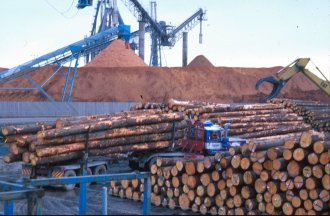
But equally as the leader of the Australian Greens there is no way I can countenance the idea that the community’s freedom of speech will be curtailed – the freedom to protest, the freedom of speech to be curtailed. There is absolutely no way that you can say to the Tasmanian community if you have a protest, if you speak out about the rubble and the mess that’s been created then the Legislative Council through the special council that’s been set up can determine that reserves will not be gazetted. That just simply is unacceptable in a democracy.
You cannot see the community’s freedom of speech curtailed in that way. Equally it is a nonsense to say that a minister must take the advice of an unelected special council, especially one that has, it’s just an appointed special council, it’s going to be stacked with the logging industry, but a minister has responsibilities and a minister must be subject to judicial review through the courts and they simply don’t have the power to say to a minister that you must take the advice of an unelected appointed council. And it is this unelected appointed council which will be the jury as to whether the Tasmanian community has behaved appropriately or not.
What sort of nonsense is that?
It is also ridiculous to put in a provision that says that according to the ‘Special Council‘ or anyone else areas that have been protected if any indeed beyond the first tranche ever get protected can be logged for special timbers and that all the residues, that is woodchips associated with that, can then be generated. So you are putting in jeopardy anything that has been protected will be vulnerable.
The other big problem with it is the idea that you can say that an area that has been assessed as worthy of protection as a reserve will not be reserved unless a third party, the Forest Stewardship Council, is blackmailed into saying that Forestry Tasmania can get certification. This is an international organisation, the Forest Stewardship Council, the Legislative Council is bringing Tasmania into disrepute globally.
If Forestry Tasmania want Forest Stewardship Council certification then they have to change their practices to earn it. The Legislative Council cannot blackmail the FSC into giving certification or else the conservation movement and people who care can’t have reserves that are scientifically determined and valid as reserves. These are things which we simply cannot accept and in fact it’s an absurdity. Anyone looking at this would say this is absurd.
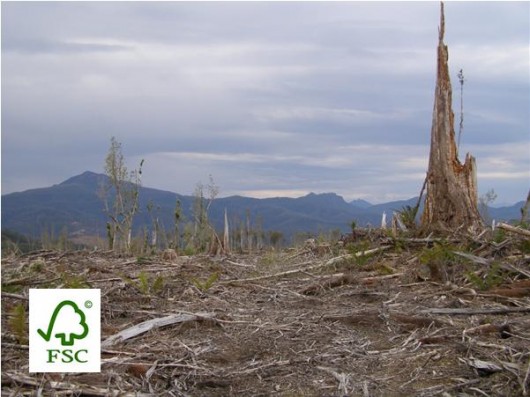
And there is no way as leader of the Australian Greens that I could see allowing a precedent of this kind to be set to suggest that other states around the country might think it was a good idea to set up such anti-democratic processes and attempts at blackmail as the Legislative Council have done. So as of now if this legislation passes in the House of Assembly then clearly this in my view the Tasmanian Forest agreement is over, finished, done, dusted and we are now going to see a convoluted scrambling around in the ashes trying to salvage something and the only durable thing that will be salvaged is the World Heritage nomination.
But even then I wouldn’t put it past the Legislative Council to try and scuttle that in the month or so before the World Heritage committee actually meets to discuss it.
JOURNALIST: The signatories and the State Greens are supporting it though, doesn’t that put you of at odds with your state counterparts?
CHRISTINE MILNE: No it doesn’t.
My Tasmanian counterparts will determine whatever they do in terms of the salvage operation but I can tell you that you that across the Australian Greens and the Tasmanian Greens we are all agreed that the Tasmanian Forest Agreement is dead. It was killed in the Upper House and the signatories also acknowledged it is dead in terms of the spirit and the letter of what was agreed.
Let’s go back through the process – there was a process, the signatories agreed, the Parliament translated that into legislation which went before the Parliament.
It was unamended in the Lower House in terms of those principles but the Legislative Council destroyed it. So we’re all agreed, the deal is dead, there are differences of opinion that may emerge. I have heard what the signatories have had to say and frankly putting your faith in Forestry Tasmania is an extraordinary turn of events and I say that because Forestry Tasmania has already breached the spirit of the deal just as the Federal Government was buying out forest contractors, Forestry Tasmania was extending the contracts that they have to take up the difference. So taxpayers’ money was going out the backdoor to pay out contractors and Forestry Tasmania was extending the contracts.
So what Forestry Tasmania has to say they stand on their record and they have not been restructured. But that’s up to the signatories, they can do as they like, the agreement is dead.
.
But isn’t that something better than nothing?
No. The fact is these reserves will never be delivered, they are on the never-never.
.
JOURNALIST: Will this deal achieve peace?
CHRISTINE MILNE: No, the forest peace deal is over.
The original deal was what was designed to try and bring about a lasting end to the debate on forests in Tasmania. But the Legislative Council destroyed it. They are the ones who have ripped up the peace agreement, the Tasmanian Forest Agreement and they are the ones who have laid it to waste, and left now a legacy of what will just be a scrambling around in the ashes to try and salvage something.
JOURNALIST: But isn’t that something better than nothing?
CHRISTINE MILNE: The issue here is when you are scrambling around in the ashes trying to salvage something it comes to the issue of principle.
The fact is these reserves will never be delivered, they are on the never-never until after 2014, October 2014, beyond a state and federal election. But equally as I said it can be overturned at any time by a minister just deciding not to proceed with those reserve orders.
JOURNALIST: So saying that you think it’s completely dead, how strongly do you like to see it rejected in the Lower House?
CHRISTINE MILNE: Well it doesn’t matter what they do in the Lower House because it’s just going to set up a convoluted process that people are going to fight over indefinitely.
It has already died so whatever they do in the House of Assembly now unless it went back to the Upper House unamended and they took on the Upper House and maintained the original agreement, if that happened well then let’s talk about that. But it’s clear from the signatories’ statement this morning that they are prepared to abandon their original deal and just work in the ashes.
JOURNALIST: Do you regret criticising the legislation before the signatories had even arrived at their decision?
CHRISTINE MILNE: Not at all, in fact it was obvious to anyone who assessed what was going on in the Legislative Council that the Forest Agreement was dead the minute that the leader of the Government in the Upper House backed the Mulder amendment.
The minute that the leader of the Government gave away Lara Giddings’ position that she was prepared to sell out the integrity of the agreement, it was clear what the Government would do. So from that point it was over and I think there should have been a stand taken against the Legislative Council and for the forests and the integrity of the agreement at that time. It didn’t happen and now we are in where we inevitably were going to end up.
JOURNALIST: Do you think environmentalists are naïve for believing the reserves will happen even if they’re not legislated?
CHRISTINE MILNE: It is clear to me that the reserves are on the never-never.
Saying that the reserves in the second tranche won’t be considered until after October 2014, after a federal and state election is absolutely out there in my view, that says they will never be achieved. But equally saying that either House of Parliament can reject it on the basis of a criticism that the community might be speaking out too much or somebody might have had a protest somewhere, jeopardising that freedom of speech and right to protest inevitably this is over.
It is a fantasy to think that those reserves will ever be delivered beyond the first tranche and that is why the only salvageable thing here is the World Heritage nomination and I congratulate the Federal Government for putting that nomination into the meeting in June and I look forward to those forests going onto the World Heritage list.
JOURNALIST: Doesn’t this kind of put you at odds though with the State Greens? They will back the legislation this afternoon so essentially they are backing the environmental signatories yet you are not.
CHRISTINE MILNE: I’m saying that the agreement is dead and I have no doubt that they also believe it is dead.
Everyone who reads this sees quite clearly that the minute the Legislative Council tore up the fundamentals of the agreement and the environmental NGOs have said that this morning.
What is now before the Parliament isn’t the Tasmanian Forest Agreement, it is a remnant, it is the burnt ashes of what went up to the Legislative Council and they’re into a salvage operation. Whatever people get out of a salvage operation they get out of it, but the agreement is dead and that is something which everybody, the ENGOs, the Tasmanian and the Australian Greens all agree on.
JOURNALIST: Given then that Prime Minister Julia Gillard is now horribly short of cash will you be petitioning her, lobbying her to pull some of the money that’s on the table for the TFA as it isn’t going to achieve what it said it was supposed to surely that money could be better spent elsewhere than propping up the logging industry I think you would say.
CHRISTINE MILNE: Well certainly the Australian Greens have argued throughout this process, Bob Brown did before I took over the leadership and then I did subsequently, that the money ought not to be flowing into Tasmania until the conservation outcomes are delivered, that there should be tranches where you get conservation outcomes and money flowing in.
.
“The forest contractors’ grants were paid, Forestry Tasmania extended the contracts.”
.
What now happens in terms of federal funding with that legislation will happen, that will be part of the ongoing agreement but the fact of the matter is the agreement as such is dead. All of the assumptions that were made about where the forest industry goes the future just aren’t on the table as even Terry Edwards I believe has said this is going to be a long, drawn-out, convoluted process and goodness only knows what happens but clearly we’re in a federal election year and I think the Commonwealth will take whatever action it chooses, they will make those decisions, but it is Lara Giddings who directed no doubt her leader of Government in the Upper House to be part of blowing up the integrity of the deal.
JOURNALIST: You’ve just said that the conflict won’t end, surely it’s a waste of taxpayers’ money if the Federal Government continues to pay out this $300 million and we don’t see peace?
CHRISTINE MILNE: Well that’s a decision for the Commonwealth and the Tasmanian Government to make, how the money is spent.
Clearly it was my preference to see Forestry Tasmania restructured. The industry restructured, that money needs to be spent if it is going to flow into regional development, not as Tony Mulder would say take the Commonwealth dollars, rebuild the industry on the back of subsidies, and take a knife to the conservation outcomes, that would be a very bad outcome for Tasmania.
JOURNALIST: But you won’t be asking the Prime Minister to pull the funding at all?
CHRISTINE MILNE: I’ll be talking to the Federal Government about the budget this year, but I’m not entering into the negotiations between what the State and Federal Governments do over funding, I will consider whatever is on the table after the debate in the House of Assembly and whatever else is determined but clearly I have taken the forest exit grants through a Senate Committee process and I will be watching very clearly how every cent is spent.
JOURNALIST: Are you disappointed with people like Phil Pullinger and Vica Bailey for saying that they will continue to back the deal when clearly it doesn’t deliver what environmentalists hoped it would?
CHRISTINE MILNE: The signatories to the agreement will do whatever they think is best and they are entitled to do that, I just don’t agree with outcome that they have reached.
The forest deal was destroyed in the Legislative Council and at that point there should have been a standing up to the Legislative Council. Now there is a salvage strategy at best, a picking over the bones of the dead body and they will do that in good faith, but it doesn’t alter the fact that the investment of time and energy, the aspirations and what was agreed are all gone.
.
[Source: ‘Mining tax, budget, Tasmanian Forest Agreement, asylum seekers’ (extract), by Christine Milne, Australian Greens Leader, 20130430, Tasmanian Times, ^http://tasmaniantimes.com/index.php?/pr-article/christine-milne-transcript-mining-tax-budget-tasmanian-forest-/]
.
[Ed: Strong words, but delivered in the shadow of Parliamentary enactment. The Greens have abandoned their forest conservation roots in Tasmania for the distraction of a humanist agenda on the thinned out rationale of becoming a multi-issue party to secure a broader membership base. Broad appeasing agendas have tragically thinned focus away from core commitment to conservation].
.
30th April: Anyone in any doubt about the importance of this deal to the forest industry need only look to the strong endorsement of companies like Ta Ann, Artec, Neville Smith Forest Products, Bunnings and our own GBE Forestry Tasmania
(statements by Tasmanian Premier Lara Giddings and Deputy Premier Bryan Green)
<<..When we set out on this journey nearly three years ago few imagined we could achieve what we have today, Ms Giddings said. This is indeed a historic turning point for Tasmania. It marks the point where we can put aside old hostilities and take control of the future of the forest industry by responding to the needs and wants of global customers.
I want to thank the signatories for recognising this historic opportunity and for having the guts, determination and resilience to see it through. There is no other alternative to the worst downturn Tasmania s forest industry has ever seen. The stark choice was either to adapt to changing global demands or see more jobs lost and the rapid decline of the industry.
Ms Giddings said the legislation passed in the Parliament today delivered protection for 137,000 hectares of forest with high conservation value, including iconic areas like Tyenna, Hastings, Picton and the Upper Florentine. It also paves the way for Forest Stewardship Council certification and funding for sawmill buybacks and more than $100 million in new regional development projects. Anyone in any doubt about the importance of this deal to the forest industry need only look to the strong endorsement of companies like:
- Ta Ann
- Artec
- Neville Smith Forest Products
- Bunnings
- GBE Forestry Tasmania
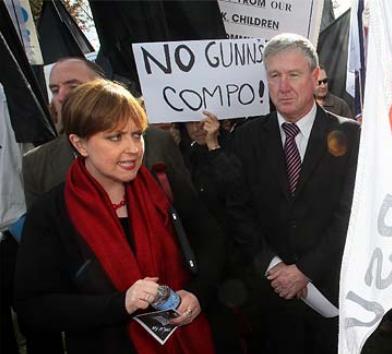
That is not to mention the hundreds of workers and small sawmillers represented by the signatories, including the Forest Industries Association of Tasmania, the Forest Contractors Association and Timber Communities Australia.
On the other side we have the mainstream environmental groups, the heavyweights that campaigned strongly against the forestry industry for decades, committing to actively supporting the industry, including endorsing FSC Certification.
The Liberal Party has been relegated to the sidelines as the chief cheerleader for the carpers, naysayers and change deniers. They have embarrassingly found themselves on the wrong side of history yet again.
Mr Green said the State Government was totally committed to implementing the Tasmanian Forest Agreement. We will continue to work with the signatories to implement the milestones of the agreement, Mr Green said. The Government is in no doubt Tasmanians want this issue fixed.
Agreement has been reached because of the willingness of people to accept the need to adapt to changing market demands and a global downturn. It has been an extremely difficult time for businesses, forest workers and regional communities. Now, Tasmania s forest sector and communities around the State can look forward to a much more certain future and the opportunity for this important industry to prosper.
Mr Green said the Government had not wavered in its support of signatories to the agreement. The Liberal Party has been intent on wrecking the agreement from the start, ignoring the efforts of the industry, unions and ENGOs to reach a lasting resolution. When strong leadership was needed Mr Hodgman went missing, Mr Green said.
.
[Source: ‘Forest industry future secure’, 20130430, by Tasmanian Premier Lara Giddings, and Deputy Premier Bryan Green, Deputy Premier, ^http://tasmaniantimes.com/index.php?/pr-article/forest-industry-future-secure/]
.
1st May: Tasmania’s Upper House has amended this Bill so savagely that it no longer reflects the agreement struck by the forest signatories
(justification for crossing the Floor, Leader of The Tasmanian Greens, Nick McKim MP )
.
Tasmanian House of Assembly Hansard:
<<Mr Speaker, this amended Bill put before us is a dramatically different Bill to that which left this House last year. It is by no means a perfect Bill, in fact, it is manifestly imperfect in a number of its provisions.
And it must be said that many of the amendments made by the Upper House defer, or reduce certainty around, conservation outcomes. And that, Mr Speaker, is no coincidence.
There is no doubt that the Upper House has amended this Bill so savagely that it no longer reflects the agreement struck by the forest signatories, and that this House now needs to consider how best to salvage an outcome from the Legislative Council’s wreckage.
The Signatories’ agreement would have given peace in our forests a chance. But we will now never know how things would have played out if the Signatories’ agreement had been faithfully legislated, because the Upper House has tragically removed that possibility from Tasmania’s future.
But despite the Bill’s imperfections, it still delivers some major conservation gains for Tasmania. It immediately provides legislated protection from logging for over 500,000 hectares of High Conservation Value forests. These iconic forests, these carbon banks, these global treasures, in places like the Styx, the Weld, the Huon, the Florentine, the Tasman Peninsula, Bruny Island, the Blue Tiers, the Western Tiers and the Tarkine will for the first time in their history have legislated protection from logging. Simply by the passing of this Bill.
The Bill also provides pathways to the creation of 504,000 ha of new formal reserves, including new national parks, and to the achievement of full Forest Stewardship Council certification by the Tasmanian timber industry.
It is true that there remains uncertainty around new reserves, and that the uncertainty is greater due to the Legislative Council amendments. But the Bill nevertheless provides an opportunity for these reserves, the chance of an absolutely stunning conservation gain, and the Greens believe Tasmania deserves no less.
And it is true there remains uncertainty around the achievement of full FSC, and that the uncertainty is also greater due to the Legislative Council amendments. But the Bill nevertheless provides the opportunity and a pathway for the achievement of full FSC, and therefore a potentially remarkable transformation in the way the forest industry conducts itself on the ground in Tasmania. And the Greens believe that Tasmania deserves no less.
.
“Those amendments (to the Bill) do not in any way constitute a ban on protests or market campaigns.“
.
And importantly, the Bill also reduces the legislated sawlog quota from a minimum of 300,000 m3 to a minimum of 137,000 m3. These are significant steps towards the implementation of long held Greens policy.
When deciding how to proceed today, the Tasmanian Greens considered many things.
We considered the bitter conflict that has existed over forestry for many decades in Tasmania. A conflict that has placed lives at risk, put jobs in jeopardy, and held Tasmania back from reaching its full potential.
We considered the massive efforts of the Forest Signatories, bitter enemies who came together and who for nearly three years sought in a constructive way to reach agreement on a way forward.
We considered the commitment of current state and commonwealth governments to being part of a solution instead of part of an ongoing problem
We considered the conservation gains I have referred to.
We also considered the letter written to the Signatories yesterday by the Minister for Resources Mr Bryan Green.
We considered that in his letter, Mr Green agreed, amongst many other commitments to:
- Finalise the gazettals of new reserves under the Nature Conservation Act for the World Heritage Area first ‘tranche’ of reserves with the clear intention that this is achieved by the end of this year (2013)
- That there is a new Conservation Agreement under the Commonwealth EPBC Act put in force over the entire 504,000 hectares that doesn’t expire until the gazettal of all new reserves under Schedule A subject to transitional scheduling, which is to be signed by both governments, explicitly including Parks and Wildlife Service, and Forestry Tasmania.
- Transfer the day to day management of the identified future reserve land, the 504, 000hectares, from Forestry Tasmania to Parks and Wildlife Service under a formal service agreement as soon as the Act commences.
- Supporting the Australian government’s undertaking that it will not approve harvesting of wood, including specialty timbers, within World Heritage nominated or listed areas.
.
We also considered the Upper House, and our firm belief that to refuse the amendments made by the Upper House, and therefore send the Bill back to the Legislative Council for further consideration, would result in one of only two possible outcomes: either the Bill would be sent back to us in a form that further erodes the conservation gains, or the Bill would die in the Upper House.
We considered that all of the signatories have asked that this Bill be passed through the lower House unamended today.
We considered the statement made yesterday by Mr Bob Annels, Chair of Forestry Tasmania.
A statement in which Mr Annels committed his organization to full Forest Stewardship Council certification, and in which he ruled out logging under any circumstances in the forests nominated for World Heritage status, allowing for a small number of transitional coupes that will be completed within weeks.
We considered the money available from the Commonwealth, the remaining $100 million to assist in the ongoing transformation of Tasmania’s economy that will be one of this Labor-Green government’s greatest legacies to our state.
We considered the $9m per year extra assistance to manage Tasmania’s world class reserve system that will flow should this Bill pass.
We considered the carbon embedded in the forest ecosystems protected from logging, and our responsibility to play a role in reducing global emissions.
We considered that we now have confirmation that the Commonwealth has given a commitment that carbon from forest ecosystems protected by this legislation will be granted additionality, and therefore will be eligible under the Carbon Farming Initiative to be traded nationally and globally on mandatory carbon markets.
Of course, we also considered those parts of the Bill which do not reflect Greens’ policy, including delays in the creation of formal reserves, the maintenance of a legislated minimum sawlog quota of any amount, the sovereign risk provisions, and the amendments which allow either House of the Parliament to use protest or market interference as an excuse to block new Reserves.
I want to be clear that those amendments, which allow either House of the Parliament to use protest or market disruption as an excuse to try and block new reserves do not in any way constitute a ban on protests or market campaigns as some have claimed.
A final consideration included our responsibility to play a constructive role in Tasmanian politics, and to help guide Tasmania to a more prosperous and united future. We considered the need for a co-operative approach, for people working together to solve Tasmania’s problems rather than lobbing grenades from the trenches. We believe that’s what the vast majority of Tasmanians want. And that’s what the Greens want to be a part of.
The Greens have had to weigh in the balance the provisions of this Bill that we support, and those that in isolation we would not. But due to the wreckers in the Upper House, the Tasmanian Greens believe that the Bill as amended is a ‘take it or leave it’ package. And that is why after long and difficult consideration, the Tasmanian Greens Party Room has decided in accordance with our Party Room rules to vote to accept the amendments from the Upper House and therefore allow this Bill to pass through the Tasmanian Parliament today and become law.>>
.
[Source: ‘Why we voted for the Bill. Silence, says Gillard. Never, says Milne’, 20130502, by Nick McKim MP, Leader of The Tasmanian Greens, Tasmanian Times, ^http://tasmaniantimes.com/index.php?/weblog/article/why-we-voted-for-the-bill/]
.
30th April: The day Kim Booth crossed the floor
.
<<Tasmania’s Lower House has passed historic legislation designed to end 30 years of conflict over logging in the state’s native forests.
The final deal will bring almost $400 million worth of state and federal funds to Tasmania to restructure the industry and create new reserves. But the compromises made along the way have left the Australian Greens to deem the final result almost worthless.
Tasmania’s Parliament passed the crucial legislation on Tuesday evening, 13 votes to 11.
The Premier, Lara Giddings, told Parliament the deal would be an historic turning point and would secure the industry’s future. “History has shown us that no conflict can go on forever. Every war must come to an end,” she said.
Federal Environment Minister Tony Burke flew into Hobart to celebrate. “The rest of Australia has not come close to being able to achieve what Tasmania achieves today, and that is a solid conservation outcome with a solid economic future,” he said. History has shown us that no conflict can go on forever. Every war must come to an end.
But the mood in the gallery was far from celebratory, with many disappointed over amendments made by the Upper House two weeks ago that effectively delay the creation of formal reserves.
Greens MP Kim Booth was the only member of the Labor-Greens minority Government to cross the floor and vote against the legislation.
“It does not give protection beyond the World Heritage Area, which I’m very, very pleased has been sent to Paris,” he said. “It does not give permanent protection to any of the other 504,000 hectares that are mentioned as areas that should be reserved.”
The leader of the Australian Greens, Christine Milne, does not support the deal either.
The vote ends more than three years of negotiation between industry and environmental groups to reduce the amount of logging in native forests. The deal aims to halve the state’s timber industry and protect a further half a million hectares of forest. The first 80,000 hectares will be protected immediately. The rest will not be up for formal protection until at least October next year.
Key environmental groups were upset at the changes made by the Tasmanian Upper House and only decided to support the deal at the last minute.
The Wilderness Society’s Vica Bayley says the Upper House amendments shook the confidence of environmental signatories. “The amendments don’t reflect the agreement, but what we have done is to try to restore confidence by alternative measures,” he said. “[They are] things such as transferring the management of future reserves from Forestry Tasmania over to Parks and Wildlife. “Things like a very strong commitment from Forestry Tasmania not to log the future reserves. “It is utterly clear that this is the only pathway forward.”
Some environmentalists have vowed to continue protests against the deal.
Resources Minister Bryan Green now has 30 days to table an order to start the process of reserving the forests. The legislation does not need to go back to the Upper House.
The State Government offered a range of sweeteners to keep the deal alive.
They include:
- Forestry Tasmania to immediately pursue Forest Stewardship Council certification and not log existing reserves or agreed future reserve areas
- The Tasmanian Government to properly resource departments to deal with agreed new reserves
- Federal and State Governments to ban logging in the 500,000 ha of forest earmarked for protection from logging, known as a conservation order
- Forestry Tasmania and both governments to try to cut the number of transitional coupes that will need to be harvested
- Immediately transfer control of the 500-thousand hectares of land from Forestry Tasmania to the Parks and Wildlife Service
- Establish dispute resolution mechanism to deal quickly with any issues that might arise during implementation
- Both governments to work together to ensure the boundary for the World Heritage Area extension meets agreed wood supply while maintaining WHA size and values.
.
[Source: ‘Tasmanian Parliament backs forest peace deal’, 20130501, ABC Hobart, ^http://www.abc.net.au/news/2013-04-30/forest-peace-deal-passes/4661224?section=tas]
.
<<Trust has been broken and heads must roll just like all the trees that will be logged as a result of this so called deal. Destruction will be the legacy of such a disgraceful act of treason. Arrogance, naivety, stupidity, ego, whatever the driving force was behind this dreadful act, it will haunt us all and reverberate through the environment for years. Forestry must be laughing all the way to the bank and the pub! You are not forgiven!>>
~ Leroy (20130507)
Source: ^http://observertree.org/2013/05/07/mainland-australian-forest-conservation-groups-appalled-by-tasmanian-forest-law/#comments)
.
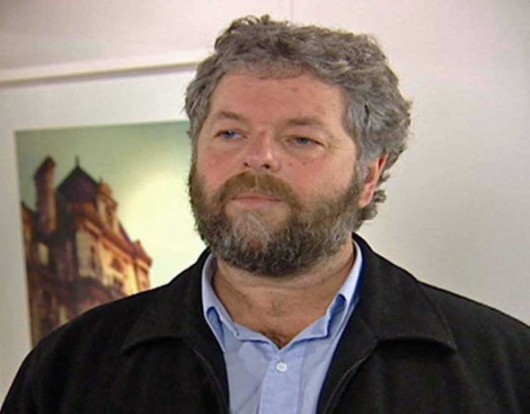 Tasmanian Greens MP Kim Booth
– blind faith in FSC Tasmanian Greens MP Kim Booth
– blind faith in FSC
.
.
30th April (before the Vote): Dr Phill Pullinger gutted by Upper House changes to the bill but ‘rolled up sleeves’ to make agreement work
.
<<…Early this morning, the signatories of the Tasmanian Forests Agreement said despite the changes made to the bill by the Upper House, they could still support the bill and urged the Tasmanian Lower House to pass the amended legislation.
Greens MHA Kim Booth will cross the floor to vote against the bill, splitting from his following Tasmanian Greens members who will be voting for the bill.
Despite Mr Booth’s stance, and the state Liberals not supporting the bill, it’s most likely the bill will pass the Lower House and become law.
Dr Phill Pullinger from Environment Tasmania said they were gutted by the changes made to the bill by the Upper House at first, but said they ‘rolled up their sleeves’ and worked with the other signatories and the Tasmanian Government to work out a way to make the changed agreement still work. “They’ll be a lot of work yet to be done to make the promise and hope that has sat behind this agreement in this process actually follow through into reality,” said Dr Pullinger.
Dr Pullinger said although the bill is now different from the one the signatories first agreed to, they can still support it and make it work in a positive way for Tasmania’s native forests. “The legislation will protect all of the half a million hectares that are agreed to be reserved under this agreement from logging, not withstanding a small list of transitional coups, and it does lay out a pathway for those forests to be formally reserved under Tasmania law.”
.
Will Hodgman: “Liberals will undo the deal and the legislation”
.
Australian Greens leader Christine Milne announced the deal dead before it was even voted on.
“My Tasmanian counterparts will determine whatever they do in terms of the salvage operation, but I can tell you that the Tasmanian Forest Agreement is dead,” she said. “It was killed in the Upper House and the signatories also acknowledge it is dead in terms of the spirit and the letter of what was agreed.”
Ms Milne says environmental groups will be ‘picking over the scraps’ of the agreement to try to salvage something positive from it, but she says this bill is not the agreement and this is not the end to Tasmania’s forest wars.
Some non-signatory environmental groups have said the amended deal will not bring peace to the forests and protests are likely to continue.
Federal Environment Minister Tony Burke arrived in Hobart earlier today to hold talks with the signatories and Tasmanian government. He said there is no way to ever completely stop protests, but believes the passing of the legislation is an historic moment for Tasmania.
Tasmanian Opposition leader Will Hodgman says should the Liberals win a majority government in the next Tasmanian election, they will undo the deal and the legislation.>>
.
[Source: ‘Is this peace for Tasmania’s forests?’, 20130430, by Louise Saunders and Carol Raabus, ABC Hobart, ^http://www.abc.net.au/local/stories/2013/04/30/3748583.htm?site=hobart&ref=m21]
.
30th April (before the Vote): Terry Edwards says the amended legislation is closer to what loggers originally wanted
.
<<Tasmania’s Lower House is set to pass legislation aimed at ending decades of conflict in the state’s forest.
Tasmanian Greens leader Nick McKim says his party will approve the bill, which was heavily amended by the Upper House. Mr McKim told Parliament the changes mean that there is a chance that new forest reserves will not be created but peace deal signatories had asked the Lower House to pass the bill unamended.
“But the bill nevertheless provides…the chance of an absolutely stunning and historic conservation gain for Tasmania,” he said.
Greens forestry spokesman Kim Booth has indicated he will cross the floor but the Government will still have the numbers to make the peace deal law.
Earlier this month, the Upper House supported the legislation but made significant amendments. The signatories announced this morning that they would back those amendments.
The Premier, Lara Giddings, told parliament the forest industry will be better off with the peace deal. “Today is indeed a historic day. Today is indeed an important day for the forestry industry and today the Liberal Party show their true colours – they don’t care. We will be able to build a new future for Tasmania, a new future for forestry industry.”
.
Peter Gutwein: “Liberals will do everything that we possibly can to unlock every single stick.”
.
 Bass Liberal MHA Peter Gutwein
[Source: ^http://www.examiner.com.au/story/87353/gutwein-booted-from-parliament/] Bass Liberal MHA Peter Gutwein
[Source: ^http://www.examiner.com.au/story/87353/gutwein-booted-from-parliament/]
.
The Opposition’s Peter Gutwein says in Government, says the passing of the bill will not end the long conflict. In government, the Liberals will undo any new reserves. “We will do everything that we possibly can to unlock every single stick,” he said.
Australian Greens Leader Christine Milne says whether or not the deal’s enabling legislation passes State Parliament, it will not resolve conflicts over forest protection. Senator Milne says in her opinion the peace deal is worthless. “What is now before the parliament is not the Tasmanian Forest Agreement, it is a remnant, it is the burnt ashes of what went up to the Legislative Council and they’re now into a salvage operation,” she said.
The Lower House is expected to sit late this evening before finalising debate.
…The Forestry Industries Association’s Terry Edwards says the amended legislation is closer to what loggers originally wanted. But he says the environmental NGO signatories are still getting a very good deal.
“There’s no doubt that the amendments made in the Legislative Council probably went further towards what we had originally bargained for,” he said. “But that said, if the bill couldn’t deliver on the ENGOs’ outcomes, then it wasn’t going to deliver on the outcomes of the agreement as a whole.”
Mr Edwards says it is an historic outcome, but there is still more negotiation ahead. “Vica talks about the opportunities presented being too important to lose and I certainly agree with that. But it’s those opportunities that we, as the signatories, and the two governments need now to seize to see whether or not we can actually do what we’ve promised to do.”
Mr Edwards says the Legislative Council has served voters well with its amendments to the deal. “To me they did a thorough job, to the best of their ability, inside the knowledge base they had. They applied a very strict public interest test over an agreement that was negotiated by people that do not have a public interest test. It’s our job now to work out how we implement that.”
Yesterday, environmental fringe groups labelled the bill ‘mutant’ legislation and warned they will not stop protesting if it becomes law.>>
.
[Source: ‘Historic forest peace deal set to pass’, 20130430, ABC Hobart, ^http://www.abc.net.au/news/2013-04-30/greens-to-back-forestry-peace-deal/4659544]
.
April 29: ‘Picton River Resolution April 2013’ – End logging in these forests!
.
 Picton River Picton River
.
<<An activist workshop facilitated by Alice Hungerford, with members of the Huon Valley Environment Centre and Still Wild Still Threatened, gathered in the Picton Valley and discussed the Tasmanian forest campaign. This resolution calling for the forest agreement to be rejected was prepared by the workshop participants.
While many conservation-minded people once held hope that the forest negotiation process may lead to forest protection outcomes, these hopes have been diminished by the ongoing conservation compromises made and more recently due to the current amendments made by Tasmania’s Legislative Council.
The amendments that have been made to this agreement by the Legislative Council render the deal void of any real conservation gain, yet prop up the dying native forest industry. These amendments are totally unacceptable.
One amendment is that forest proposed for protection in the first stage are only those areas that are in the World Heritage nomination currently before the IUCN. Leaving out large areas of high conservation value forest in:
- The North West, the Tarkine
- The North East and East
- Weilangta
- Tasman Peninsula
- Bruny Island
- West Wellington.
.
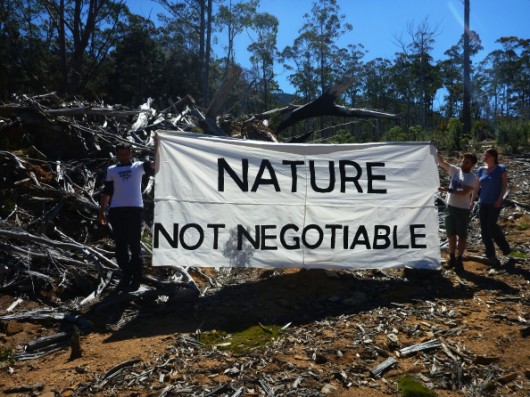 Roses Tier, North East Tasmania
^http://observertree.org/category/photos/ Roses Tier, North East Tasmania
^http://observertree.org/category/photos/
.
These forests will not be reserved unless the native forest industry in Tasmania receives Forest Stewardship Certification (FSC). Protection will be delayed until at least October 2014, however it will be dependent on this certification.
This is an amendment laced with problems; the forestry industry is not committed to changing the current regime of clear-felling, creating huge quantities of wood that is referred to as‘residues’ by the industry, continued logging on steep slopes, old growth destruction and continuing regeneration burns. If these are the logging practices that are to be granted FSC status, then this would be a severe sabotage of the FSC process and bring into question the credibility of certification. Worse still it entrenches Tasmania into ongoing destruction of native ecosystems at a critical time of climate change.
This amendment shows the clear direction of this deal – to support the ongoing native forests industry. This is a far cry from the original purpose of the negotiations, which promised a transition out of native forests in Tasmania.
We cannot accept a deal which seeks to prop up native forest destruction, clear felling and a return to wood-chipping. We cannot accept a deal that does not deliver the protection of verified high conservation value forests upfront. We cannot accept a deal which will further weaken Tasmania’s forest practice standards and which has the potential to jeopardise the integrity of FSC.
First and foremost Tasmania needs secure protection of high conservation value forests, an end to logging in these forests. Secondly the forestry industry has to prioritise restructure; bring an immediate end to out-dated practises that are ecologically damaging.
The large-scale volume-driven nature of the forestry industry must be restructured to support high-value labour-intensive use of every possible part of every tree harvested. And a rapid transition into plantations is required.
A further amendment has provided for World Heritage value forests in the Great Western Tiers to be excluded from upfront protection, despite being a part of the nominated area currently before the IUCN. Protection of these forests appears to be delayed until October 2014 and also dependent on FSC.
It is unacceptable to exclude any areas from protection that have been verified as World Heritage value. And it is unacceptable to continue to log areas within the World Heritage nominated forests or to allow access for logging for speciality timbers in perpetuity.
Another amendment made by the Legislative Council is that any reserve (including in the World Heritage Area) could be logged for special species timber as defined by the Minister of the day, if this is deemed necessary in the future. It is unacceptable for logging to occur inside reserves for speciality timbers, yet meanwhile such timbers have been left in clearfells and burnt in the annual Autumn high-intensity burns for far too long. Ending high intensity burn practises and providing funding for salvaging special species timbers off the coupe floor and storing these timbers in regional wood banks would provide ongoing employment.
Most importantly, the health repercussions for all Tasmanians from burning and poisoning our land, water and air through the current out dated practices must be acknowledged and monitored reparation is required.
The people of Tasmania bear the full social, financial and community costs of the forests destruction, and government prop up of the unsustainable industry.
Who we are: we are mothers, grandmothers, daughters, children, sisters and brothers, teachers, community workers, volunteers. We are people who care. We are strong, and loving and joyous. We are activists. We work for change.
We are committed to caring for our country. We take full responsibility for our words and our actions. We participate in all parts of this community, we call Tasmania home.
We stand for justice, empowerment, safety and ecological sustainability. We recognise the urgent need for people to wake up, to rise up and support broad-scale restorative change.
We are passionate about democracy and expect every member of Parliament to stand up and do the right thing, to put Tasmania and Tasmanians as their very first consideration in making decisions about land and resources.
The process of reaching an Inter-governmental Agreement on Tasmania’s forests has taken almost 3 years and has been fraught with bias. The process has been heavily skewed toward industry gain and conservation loss. We do not support the future of forest protection to be dictated by the special council that is set up by this Tasmanian Forest Agreement, which again is dominated by industry interests, as membership of the council will have three conservationist representatives and eight industry representatives. We call on our elected representatives to shape a future for Tasmania that insists on ecologically sustainability.>>
.
[Source: ‘Picton River Resolution April 2013’, 20130429, by Jenny Weber, Huon Valley Environment Centre ^http://www.huon.org/ and Miranda Gibson, Still Wild Still Threatened, ^ http://observertree.org/2013/04/29/picton-river-resolution-april-2013/]
.
27th April: The Legislative Council has fired a torpedo into the Tasmanian Forest Agreement
(Former Greens Senator and Founder, Bob Brown)
.
<<After the Agreement was struck last year the Prime Minister, Julia Gillard, made it clear that she expected it to be implemented without alteration. In perhaps the biggest downpayment in Tasmanian history, the Commonwealth gave $120 million to the collapsed logging industry to make good the Agreement. It promised over $100 million more for regional development on condition that the Agreement was fully implemented, including its promised forest reserves.
However, here in Tasmania, under concerted fire from the Liberals and disgruntled individuals from the logging industry, the Legislative Council has voted to amend the enabling legislation which was passed by the House of Assembly and blown up the Agreement’s environmental outcome.
The Council’s amendments leave the loggers’ interests wholly intact while putting the bulk of the environmentalists’ outcomes on the never-never. The Agreement’s promise of immediate and permanent reserves in return for the hundreds of millions of dollars in industry restructure, retraining and regional development is largely broken.
Gazetting of the majority of the promised national parks would be delayed until, if the polls are right, Liberal governments are voted into both Canberra and Hobart. The Liberals have campaigned against the forest peace agreement all the way down the line. Ignoring the fact that it is industry and environment groups which have spent three years negotiating the Agreement, not Labor or the Greens, Liberal spokesman Peter Gutwein asserted after the Council vote that ” we will unlock every single stick that Labor and the Greens try to lock up”.
Legislative Councillor and Liberal Party member Tony Mulder, who sealed the Council’s amendments, emailed one logging campaigner to reveal his plan was to ‘get some fed dollars’ and then watch the deal fall over. He wrote that he intended to put the reserves ‘to the sword’.
Key to this hostile game plan played out by the Council amendments is sinking the core commitment in the Agreement that “the Signatories support the legally binding protection of an additional 504,012 hectares of native forests’, with 395,199 hectares given legislative protection ‘as soon as feasible’. That is, this year.
Three of the many Council amendments to the legislation highlight their killer effect. Firstly, after interim protection, some 300,000 of those 395,199 hectares of High Conservation Value forests to be reserved ‘as soon as feasible’ have had that reservation put off until at least October 2014. That means the Liberals, if they win the elections, will put the promised reserves ‘to the sword’.
Even if the Liberals stay in opposition, the reserves fail if there are any substantial protests in a state where forest destruction and protests have occurred every year since the 1970s. To make sure, the reserves also fail if Forestry Tasmania, which has been refused green accreditation for years, is not given Forest Stewardship Council certification by the mainland-based authority.
Secondly, of the 123,000 hectares of top order forests, like the Styx, Huon, Weld and Upper Florentine, which were nominated by the federal and state governments for World Heritage status last February, a Council amendment removes 35,000 hectares near Cradle Mountain and in the Great Western Tiers from gaining national park status unless both the nomination succeeds and that green accreditation is granted to Forestry Tasmania.
Another Council amendment to the Agreement is that any reserve, including in the World Heritage Area, could be logged for special species timber, as defined by the minister of the day, if this is deemed necessary in the future.
In a nutshell, the Tasmanian Forest Agreement’s fundamental deal that 395,199 hectares of High Conservation Value forest reserves, ostensibly national parks, should be created in return for the hundreds of millions of dollars of industry and regional restructuring is being torpedoed.
The logging industry employs fewer than 2,000 and that number is falling. Tourism employs more than 15,000 and that number is growing. The Council’s perverse action, if allowed to stand, will mean that the former has its money while the latter is left with neither vital new forest attractions nor the regional development funds it should share in creating Tasmania’s new future.
This puts governments in both Canberra and Hobart to the test. The House of Assembly should return the original legislation to the Council. If the Council insists on its amendments let history, as well as contemporary Tasmanian voters, see it for the wrecker it has become. — Bob Brown.
According to TWS spokesperson, Vica Bayley, “we are still looking at ways we can improve the workability of the Agreement given the Legislative Council’s amendments”. We are not prepared to give up and are exploring all other options. There may be no way other than re-amending the [Tasmanian Forest Agreement] Bill”, Mr Bayley said.
According to Mr Bayley some of the Signatories were working through a number of options including asking the State (minority) Government to further make amendments before putting it back before the Legislative Council.
The Signatories have until this Tuesday morning (30 April) – when State Parliament sits – to devise any amendments. ‘A group of the Signatories’ had met in Melbourne on Tuesday [23 April] and there were on-going telephone hook ups.>>
.
[Source: ‘The Council’s Torpedo’, by Bob Brown’, 20130427, Tasmanian Times, citing article ‘Green groups burn night oil in forest pact by Nick Clark’, 20130427, in The Hobart Mercury, ^http://tasmaniantimes.com/index.php?/weblog/article/the-councils-torpedo/]
.
19th April: Tasmanian Parliament recalled over forestry bill
.
<<Tasmania’s Parliament will be recalled later this month to finalise legislation to enact the forest peace deal. The Legislative Council has significantly amended the bill, jeopardising the deal.
It is unclear whether environment groups will accept the changes.
Opposition Leader Will Hodgman postponed question time in a bid to force the Lower House to debate the contentious bill. “Let’s finish this once and for all,” he told parliament. After today, this House doesn’t sit for another five weeks, that’s five more weeks of uncertainty.”
Labor and the Greens denied the debate, the Premier saying she will recall Parliament on April 30th to deal with the matter. Ms Giddings says the Government cannot accept legislative changes which undermine the historic peace agreement. She says the Government and peace deal signatories need more time to work through the changes.
“My hope is that we will find that all of us can be supportive of the legislation, but we don’t know that at this point in time,” she said. “There are discussions that need to be had.”
Greens leader Nick McKim says it is the right thing to do. “The signatories have been clear they would like more time.”
Deputy Premier Bryan Green is also against rushing the debate. “This is the biggest decision that this state has had to face up to in more than three or four decades,” he said.
Signatories meet
The signatories are consulting their supporters and are expected to meet to discuss the Upper House changes later today. The Wilderness Society’s Vica Bayley says it is too early to say if his organisation will accept the changes. “Our members will be concerned, as are we, about these changes,” he said. “This does not reflect the implementation of the Tasmanian Forest Agreement. “It certainly puts a question mark over the delivery of a range of opportunities that that agreement afforded.”
Environmental groups say they will continue a holding-pattern on international timber market protests while they consider the changes. Environment Tasmania’s Phil Pullinger says the focus is on finding a solution. “We absolutely remain committed to the agreement we made in November, we’re not going to walk away from that,” he said. “We do need some time to analyse what this legislation means with respect to the agreement. “We would not be changing anything in terms of us continuing to be in a holding pattern as far as the market place is concerned.”
.
[Source: ‘Parliament recalled over forestry bill’, 20130419, ABC Hobart, ^http://www.abc.net.au/news/2013-04-18/parliament-to-be-recalled-over-foresty-bill/4636720]
.
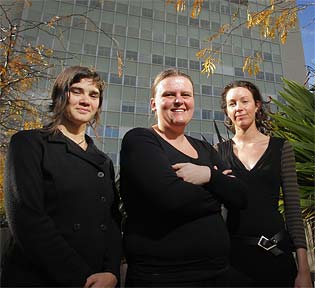 Tasmania’s women of principle
Miranda Gibson (SWST), Jenny Weber and Jasmine Wills (HVEC) back in 2011 launching a TV campaign against Forestry Tasmania
[Source: Photo by Richard Jupe, Hobert Mercury, New Ltd,
^http://www.themercury.com.au/article/2011/05/23/232161_tasmania-news.html] Tasmania’s women of principle
Miranda Gibson (SWST), Jenny Weber and Jasmine Wills (HVEC) back in 2011 launching a TV campaign against Forestry Tasmania
[Source: Photo by Richard Jupe, Hobert Mercury, New Ltd,
^http://www.themercury.com.au/article/2011/05/23/232161_tasmania-news.html]
.
Footnote (2012):
.
Ed: ‘Tazmania’: a perpetuating cultural history of exploitation and embattlement,
simply because of a recurring handful of selfish middle-aged men prepared to bully to get their way.
.
Oct 2012: Greens and FIAT push for resolution
.
<<The Forest Industries Association of Tasmania (FIAT) has announced it will rejoin the forest peace talks … for now.
The Tasmanian Greens and FIAT are pushing for the forest peace talks to be wound up soon. FIAT has declared it will return to the talks to end the state’s long-running forest wars.
The chief executive Terry Edwards said the Commonwealth and State governments were losing patience with the process and an agreement to restructure the state’s struggling forest industry had to be reached by the end of the month.
The Greens leader Nick McKim said FIAT’s return to the talks should prompt the other suspended forest groups to return to the peace talks. “I do believe that at some stage we will either need from the signatories an agreement or an agreement that an agreement can’t be reached,” he said. “So look, I would like to see this process concluded, I think most Tasmanians would like to see this process concluded. The good news now is that with FIAT back in, the process can proceed.”
The $276 million dollar, Federally-funded forest peace talks have been running for two years. The Forest Industries Association, which represents large saw millers and veneer processor Ta Ann, had suspended its involvement in the talks over the Government’s plan to overhaul Forestry Tasmania. Members met on Friday to vote on whether to walk out permanently.
The chief executive, Terry Edwards, said it was a tight vote but a last minute letter from the Premier Lara Giddings prompted the group to return to the table. “We feel we’ve got too much invested in that process to date to simply walk away,” he said.
Mr Edwards would not detail what the letter said other than saying it gave assurances the industry would be consulted about the changes to Forestry Tasmania. “She has clearly indicated that the reform will be evidence-based and that’s something we’ve been asking for since the announcement of the reforms of FT. “Our concern to date has been that it will be politically-based, not evidence-based, and that’s a very welcome change of direction by the government.”
Mr Edwards put a new final deadline on the peace talks – the end of the month. He said FIAT would withdraw permanently if a decision was not made by then.
The Premier, Lara Giddings, welcomed the announcement, saying it recognised there was an “urgent need” to restructure the state’s struggling forest industry.>>
.
[Source: ‘Greens and FIAT push for resolution’, 20131006, ^http://www.abc.net.au/news/2012-10-05/fiat-to-stay-in-peace-talks/4298180]
.
<<There was a man outside the Executive Building at the time when Terry Edwards and Phill Pullinger fronted a waiting media pack at 1 pm on the afternoon of Wednesday 15 August, 2012. These two Signatory representatives were there to release the Interim Agreement on Tasmanian Forest Wood Supply and Conservation.
Mr Glenn Britton of Britton Timbers and chairman of the Forest Industries Association of Tasmania was also there.
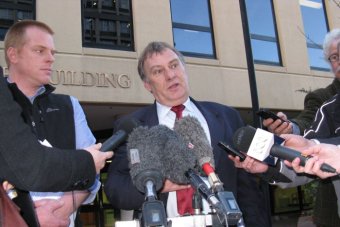 Chief Executive of Forest Industries Association of Tasmania (FIAT), Terry Edwards Chief Executive of Forest Industries Association of Tasmania (FIAT), Terry Edwards
.
On 23 August whilst Terry Edwards, the CEO of FIAT was holidaying in Fiji, Mr Britton was in the media spot-light over an article on correspondence he had with the Leader of the Opposition, Mr Will Hodgman.
Louise Saunders: ‘… you are a saw miller, you’re Chairman of the Association, do you have concerns or reservations (over the IGA process)?
Glenn Britton: Oh, look, it would be fair to say everyone has reservations and ahh… the reason why. That to date the agreement hasn’t been achieved is because of the, ahh… the huge gap that’s still apparent between sufficient forest to supply the, ahh… the, ahh… the appropriate or required level of, ahh… level… or volume of sawlogs and peeler logs and special species timber by… by volume and by quality, and size and age class etc… to sustain a viable industry into the future on the one hand and on the other hand, ahh… having that; allow sufficient, ahh… ahh… forest to, ahh… add to the current one and half million hectares of forest reserves already in Tasmania.
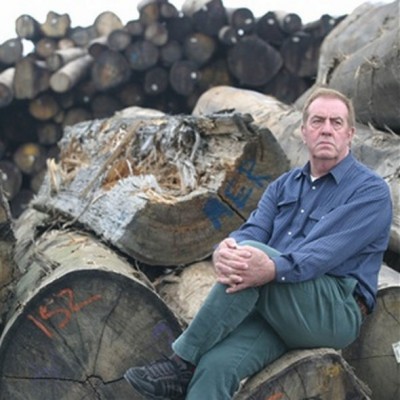 Glenn Britton (FIAT Chairman) Glenn Britton (FIAT Chairman)
.
In April-May 2011 Britton Brothers along with Ta Ann Tasmania wrote a submission that was part of FIAT’s submission to the Legislative Council Inquiry into transitioning out of native forest logging. Their Smithton sawmill processes 30,000 cubic metres of native forest logs employing 75 mill workers and 30 forestry contractors. Their timber products are ‘aimed at the high value appearance-grade markets – furniture, joinery, cabinet making and feature flooring, used in commercial and residential fit outs in Australia an overseas’.
Britton Timbers sawlog resource is supplied by Forestry Tasmania from native forests in north west Tasmania. The company offered an assessment of ‘a transition to plantation processing for Britton Timbers. For them it came down to the recovery of a suitable quantity and grade of timber from plantation sawlogs.
According to Britton Timbers the recovery of sawn timber from a modern sawmill in Tasmania from native sawlog is 35%. They compared that against a 40% recovery with Eucalypus nitens plantation sawlogs.
From their annual wood supply of 30,000 cubic metres, they estimate 10,500 cubic metres of sawn timber from native sawlog and 12,000 cubic meters from plantations. They sell graded sawn timber according to Select, Standard and Utility categories.
When it came down to the sale price, Britton Timbers maintains that their annual turnover would be disadvantaged (Figure 2); $10,290,000 from native forests versus $8,040,000 from plantations.
For Britton Timbers, a transition to a plantation resource is hampered by: (1) a lack of plantation wood supply until 2035, and (2) predominant species currently in the state forest estate – Eucalyptus nitens – is not suitable for producing appearance-grade timber for high-value wood products.
Their suggested transition strategy to plantations needed to include:
(1) A move to plantings of E. globulus
(2) Plantations managed for sawlog production by high-pruning and thinning trees from an early age
(3) Growth to ‘a suitable diameter’ [600 mm in diameter]
.
According to Britton Timbers’ May 2011 submission:
“Native forests can be managed for biodiversity, carbon capture and sawlog production either in perpetuity or until we have a plantation resource suitable for processing, but this will take around 25 years. Until such time as the forestry industry has a plantation estate capable of producing the quality of timber required by saw mills and rotary peeled veneer mills, any discussion of a transition is hypothetical.”>>
.
[Source: ‘More grist for the mill …’, 20120829, by David Obendorf, Tasmanian Times, citing Britton Timbers 2011 submission to the Legislative Council Inquiry into public native forest transition April-May 2011, accessed August 2011, ^http://www.tasmaniantimes.com/index.php/article/more-grist-for-the-mill-]
.
Comments:
.
Comment by lmxly (20120829):
<<Britton Brothers received a total of $1,567,308 under the TCFA. in 2004-06, from the Tasmanian Forest Industry Development Program.
The TCFA document “A way Forward for Tasmania’s Forests” states ‘This program will help hardwood mills to adjust to the different types of logs they will need to process as a result of the move away from old-growth clear-felling towards regrowth and plantation timber.
Assistance will be provided for projects that:
- Improve sawlog recovery rates and add value to forest resources (particularly regrowth wood and native forest thinnings)
- Develop new forest products
- Result in more efficient timber use
- Assist with adjustment to the changing nature of supply.
.
What did Britton Bros actually spend over $1.5million of taxpayer funds on, if not the purposes of the TFIDP?
Has Britton Bros not ” adjusted to the different types of logs they will need to process as a result of the move away from old-growth clear-felling towards regrowth and plantation timber.”? If not why not?
Have they in effect pissed this money up against the wall? Or were they conned by FT that its plantation estate would produce satisfactory sawlogs after 2020 – which is only eight, not twenty five years hence?
To claim that ‘any discussion of a transition is hypothetical’ a demonstration of Britton’s hypocrisy: incompetence at best, since this discussion has been far from hypothetical for the pst five years, and he has received over $1.5m to find a way to make the transition for his operation.>>
.
Comment by David Obendorf (20120830):
.
<<Terry Edwards will be back from Fiji and no doubt Bob Gordon isn’t far away either. The pow-wow will be on with Ken Jeffreys and Evan Rolley and Glenn Britton. It looks like they will have to take Bryan out somewhere ‘noice’ for tea in Burnie and try to sort him out on a few things.
Maybe they can ask Bryan where the high quality sawlog until the plantations are available will be coming from. Bryan can ask them who’s putting up their hand to take a slice of Julia Gillard’s $15 million of the saw-miller exit money? It ain’t easy being Bryan Green at the minute.
<<…CEO for Ta Ann Tasmania is Evan Rolley – TAT’s wood supply to 2027 is 265,000 cubic meters per annum. That is the checking move from the Industry side – no doubt about it.
Former CEO of TWS, Alec Marr is now the cock of the rock of the moth-balled Triabunna woodchip plant. Dealing with wood residue from forestry activities and sawmills. That is checking move from the ENGO side – no doubt about it.
FT Tasmania has been extremely irresponsible and culpable in its erroneous projections of high quality saw log and peeler logs from eucalypt plantations. They have led their Ministers, Canberra and local sawmillers up the garden path.
The publicly accessible plantation estate is of limited value to sustain the supply and quality required to 2030 and FT has always known this! That makes any deal on the 430,000 to 572,000 ha of HCV native forests looking like a stalemate.
Mr Bayley and Dr Pullinger should realise this fully by now. FT Tasmania – who baulked and blocked and weren’t even a party to the roundtable – had controlled the agenda and led the ENGOs into their forest territory – production forests.
The Liberals 150,000 ha of extra forest reserve looks like the position that FIAT was offering to the ENGOs in their negotiaton scenario in June 2011 (maybe even earlier).
Ta Ann doesn’t look like budging on their wood supply unless they see a very good reason to reduce their access to native forests for peeler billets in Tasmania. Any capitulation from them would come down to money [like the Gunns Ltd/FT pay out of $39 million] and negotiating with Mr Rolley on behalf of the parent Ta Ann company.
Where is Plan B, because Plan A looks like it may be stale-mated?
.
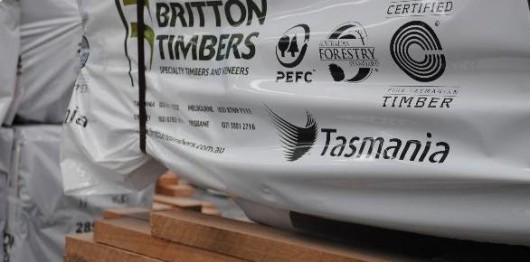
.
Further Reading:
.
[1] >Tasmanian Forest Agreement 2012.pdf (300 kb)
.
[2] >Tasmanian Forests Agreement Bill 2012.pdf (300 kb)
.
[3] >TFA Fact Sheet Summary of Outcomes.pdf (500 kb)
.
[4] >TFA Fact Sheet TFA Bill Overview Final.pdf (330 kb)
.
[5] >TFA Fact Sheet TFA Reserve Process Short Version.pdf (540 kb)
[6] >Threats to Wild Tasmania – articles (on this website)
.
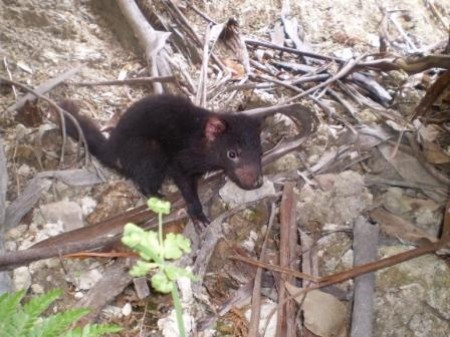 Tasmanian devil in The Weld Forest
(the forest is being logged) Tasmanian devil in The Weld Forest
(the forest is being logged)
.
Tags: Butlers Gorge, Camp Flozza, greenwash industry brigade, Signatories to the Tasmanian Forest Statement, Still Wild Still Threatened, Tasmania, Tasmanian Forests Agreement, Tasmanian Forests Agreement Bill 2012, Tasmanian Police, The Huon Valley Environment Centre
Posted in Tasmania (AU), Threats from Deforestation, Threats from Weak Environmental Laws, Threats to Wild Tasmania | No Comments »
Add this post to Del.icio.us - Digg
Tuesday, April 16th, 2013
 . .
<Federal environment minister Tony Burke has rejected National Heritage listing for Tasmania’s precious Tarkine Wilderness.
.
Burke’s Ten New Mines!
.
On 8th February 2013, Burke announced 10 new mines proposed over the next five years for the Tarkine Wilderness. Nine of these 10 mines will be open cut leaving scars of devastation in an area of north-western Tasmania.
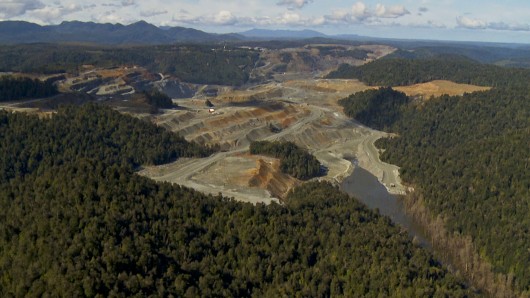 Savage River Mine already scarring The Tarkine Wilderness Savage River Mine already scarring The Tarkine Wilderness
.
“The Tarkine is one of the world’s great wild places.
It is an expansive 447,000 hectare wilderness area of recognised World Heritage significance in the North-West corner of Tasmania, Australia’s island state. The Tarkine contains remarkable natural and cultural values, including one of the world’s most significant remaining tracts of temperate rainforest,” said the Tarkine National Coalition.
The Tarkine is a place of unique natural and cultural significance and was nominated for World Heritage listing by the Australian Senate in 2007.
The Tarkine has been recognised by prominent bodies including the International Union for the Conservation of Nature, the Tasmanian Department of Parks, Wildlife and Heritage and environment groups such as The Wilderness Society and the Australian Conservation Foundation.
The Australian government has recognised the Tarkine’s outstanding national significance through listing the Tarkine on the register of the National estate.
As the Tarkine National Coalition says:
.
Burke only “listed a paltry 4% of the 433,000 hectares recommended to him by the inquiry”
.
Since February 8, Burke has granted the first two of 10 mining permits to Venture Minerals for three iron mines at Mount Lindsay and granted Shree Minerals an iron ore mine proposed for Nelson Bay River.
Successive environment ministers have failed to put forward an assessment by the Australian Heritage council for Heritage listing with UNESCO leaving these areas of “outstanding natural and cultural value” vulnerable to the policies of Burke.
A national day of action on 14th February 2013 and a campaign in local media helped to expose the plight of the now endangered Tarkine and reverse this environmentally catastrophic decision.
Venture Minerals and Shree Minerals are driven by the profits to be made from these proposed mining ventures in the Tarkine. But the Tarkine has far more long-term value as a wilderness area and should continue to benefit all.>>
.
[Source: ‘Mining approved in the Tarkine’, 20130219, by Rachel Christensen, ^http://www.greenleft.org.au/node/53374]
.
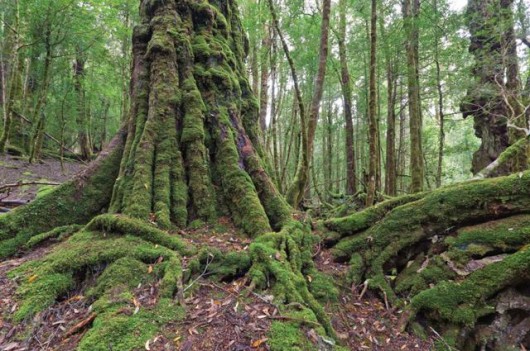 Tarkine Wilderness
(Peter Walton, Tasmania Expeditions) Tarkine Wilderness
(Peter Walton, Tasmania Expeditions)
.
So in the absence of government responsibility, Dr Bob Brown has just been announced as new patron of rebranded Save the Tarkine campaign.
The Tarkine National Coalition is pleased to make two exciting announcements that we believe will help increase the national profile of this important campaign.
“Today we are unveiling the new Save the Tarkine branding that we will campaign under”, announced Campaign Coordinator, Scott Jordan. “We believe that brand, Save the Tarkine will help the public more easily identify this important campaign, and let them know in clear terms what our mission is.”
To support this rebranding, a new Tasmanian devil inspired logo has been adopted (see above).
Tarkine National Coalition Incorporated remains as the registered legal entity, with campaigns to be conducted under the registered trading name Save the Tarkine.
Save the Tarkine are also thrilled to announce that Dr Bob Brown has accepted our invitation to become patron of the campaign.
“Bob is no stranger to the Tarkine, having fought for it’s protection both in and out of the parliament. We are thrilled that Bob has agreed to accept the role of patron, and we look forward to sharing Bob’s passion for the Tarkine with all of Australia”.
“I’m honoured to be first patron of Save the Tarkine”, said Dr Brown in Launceston. “I first walked the Tarkine forty years ago looking for Tasmanian Tigers, and if protected the Tarkine will create hundreds, if not thousands of jobs in the future. If mined it will end up another post-industrial waste dump”.
.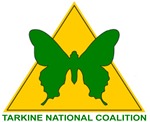 . .
 . .
<<The Tarkine is a vast, continuous and largely untouched wilderness of exceptional and rare diversity. Covering an area of around 450,000 hectares in Tasmania’s north-west, it is a place worthy of World Heritage protection yet, unbelievably, remains inadequately protected and vulnerable to being carved up by the mining and forestry industries.
This book is the authors’ tribute to this last of the last frontier experiences on earth.>>
.
‘Tarkine – Wild and Sacred’
by S & E Bartley
40 Degrees South Publishing
RRP:$29.95 Paperback 144 pp
ISBN 9780987243195
.
[Source/Purchase: ^http://www.fortysouth.com.au/writers-market/book/161]
.
Tags: Bob Brown, Mount Lindsay, Nelson Bay River, save the Tarkine, Shree Minerals, Tarkine wilderness, Tasmania, Tasmanian Tarkine, Tin Mining, Tony Burke, Venture Minerals
Posted in Tasmania (AU), Threats from Mining | 2 Comments »
Add this post to Del.icio.us - Digg
Sunday, February 3rd, 2013
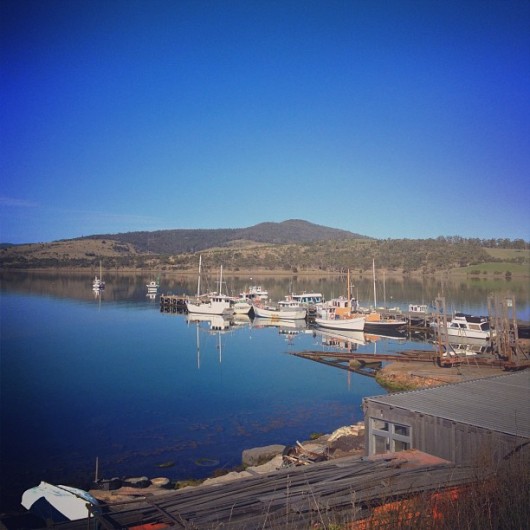 Dunalley Wharf, Tasmania ~ idyllic serenity
Now with far greater meaning Dunalley Wharf, Tasmania ~ idyllic serenity
Now with far greater meaning
.
On that blistering hot Friday 4th January 2013…this same wharf became a life saving critical refuge. Desperately trapped residents fled their homes from a raging inferno bearing down upon them and clung below the wharf for dear life, immersed in the cool salt water.
Dunalley’s Wharf became a final refuge for people of Dunalley to survive what would otherwise have been certain death by bushfire. It’s unassuming but vital human value is now etched in local memory, which must now already be legend.
Such horrific memories are destined to endure local lifetimes.
What let the firestorm descend upon Dunalley was negligently and morally wrong. It was stoppable on the 3rd and the escalated firestorm should never have come to this.
No-one deserves this, ever!
.
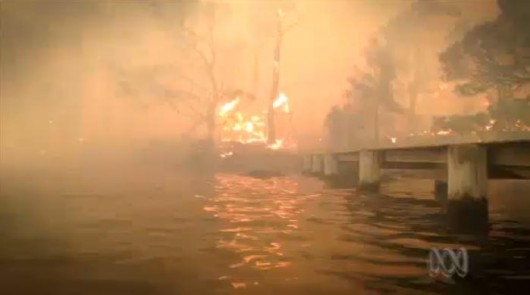 Dunalley Wharf, a special place. Dunalley Wharf, a special place.
.
Dunalley: a bushfire-vulnerable community
.
The small rural fishing village of Dunalley is situated along on a sheltered coastline in south eastern Tasmania adjacent to established grazing country and immediately surrounded by hilly bushland.
Tourists drive through Dunalley from Hobart enroute down to the popular Tasman Peninsula where historic Port Arthur is situated. A smaller coastal village of Boomer Bay lies 1km to the north of Dunalley.
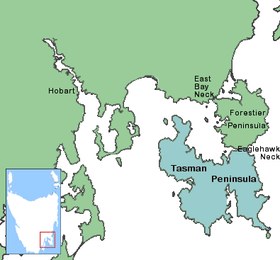
Zooming in, Dunalley is positioned on a narrow 700 metre wide isthmus of land between Dunalley Bay and Blackman Bay that connects the main island of Tasmania to the Tasman Peninsula – ‘East Bay Neck‘.
The Denison Canal cuts this isthmus and the town in two providing a boating shortcut transit between the two bays (like a micro version of the Panama Canal) . The Arthur Highway crosses over the canal at the Denison Canal Bridge.
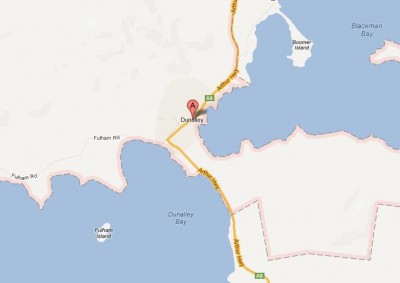 “..Water, water everywhere, nor any drop to drink.”
~ The Rime of the Ancient Mariner by Samuel Taylor Coleridge.
Dunalley is surrounded by water on both sides
(Denison Canal not shown) “..Water, water everywhere, nor any drop to drink.”
~ The Rime of the Ancient Mariner by Samuel Taylor Coleridge.
Dunalley is surrounded by water on both sides
(Denison Canal not shown)
.
Dunalley has for over a century been a sawmilling and fishing town, but over recent decades has seen growth as retirees and holiday makers buy up and extend the population to just under 400 with new housing development communities like adjacent Primrose Sands sprouting up.
.
QUESTION 1:
.
What contribution and culpability have (1) housing planning approvals by local Sorell Council and (2) Sorell Council enforcement and compliance monitoring of Australian building standards in bushfire prone areas, played in susceptibilty of properties in Dunalley and Boomer Bay to bushfire damage? What role and approval if any has the Tasmanian Fire Service had in these housing planning approvals?
.
Like so many rural communities across Tasmania and indeed south eastern Australia, the rural lifestyle appeal of coastal villages like Dunalley is the traditional timbered cottage amenity and the rustic bushland setting. Dunally also has the sheltered bays to complement its appeal.
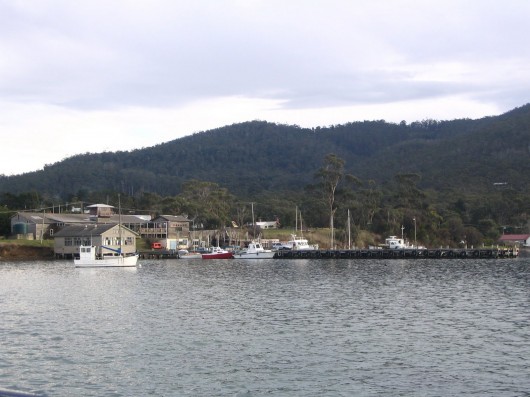 Dunalley Wharf and Fish Market looking north from Dunalley Bay,
with steep Township Hill in the background (long before the 2013 bushfire). Dunalley Wharf and Fish Market looking north from Dunalley Bay,
with steep Township Hill in the background (long before the 2013 bushfire).
.
However, the geographic restrictions of Dunalley being:
- Surrounded by coastal waterways
- Close proximity to bushland (a substantial ‘urban bushland interface‘)
- Dunalley’s juxtaposition downwind of the prevailing north-west wind from extensive bushland vegetation
..all combined make Dunalley an inherently bushfire vulnerable community. In the event of a bushfire, normal expected evacuation by road would be restricted.
Indeed, evacuation from the dependengt Forestier Peninsula and sub-dependent Tasman Peninsula had to be both effected by sea, since the logistically vital Denison Canal bridge became impassable due to the bushfire emergency.
.
QUESTION 2:
.
What bushfire risk assessment, community education, community bushfire preparation and bushfire evacuation procedures had the Tasmanian Fire Service provided to the communities of Dunalley and Boomer Bay in the years, months, days ahead of the January 2013 bushfire?
.
QUESTION 3:
.
Did most residents of Dunalley and Boomer Bay consider their individual properties and their communities in general particularly vulnerable to bushfire? If so, what bushfire mitigation measures had been previously discussed and actually implemented. If not, why not?
.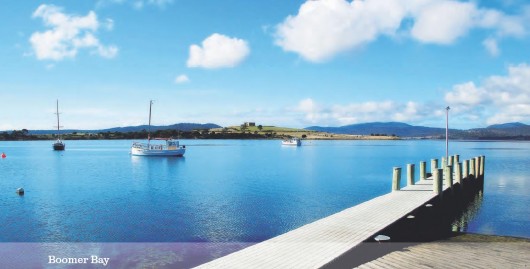
.
Following Victoria’s tragic Black Saturday bushfires of 7th February 2009, in addition to the subsequent Royal Commission, a study by a team of scientists from Australia and America examined 500 of the homes that were affected by the bushfires.
The study sought to learn from effects of land management on house loss to identify how houses could be better protected in future bushfires. The study compared the impacts of bushfire preparation measures like prescribed burning, grazing, logging of native forests, and the clearing if immediate bush on the survivability of houses in a bushfire.
The key result was that getting rid of vegetation ( trees and shrubs) within 40m of a house was by the most effective property preparation measure. Whereas measures such as logging native forests and prescribed burning had minimal impact on reducing house loss. The results of the study were published a year ago on 19th January 2012 in the online scientific journal ‘PLoS ONE‘.
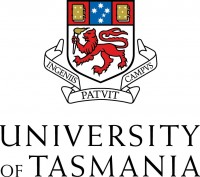
Professor David Bowman, an expert in forest ecology and bushfire management at the University of Tasmania in Hobart, says this research is useful because it confirms scientifically what we already know.
“It’s really important that we get more effective at mitigating the effects of bushfires,” says Philip. “It does open up some pretty intense political issues,” he says. “You’ve got to ask the question: why are people living in these areas if these disasters are only going to keep happening? Why do peri-urban communities exist?”
Population growth in bushland areas and more frequent bushfire weather predicted with climate change are expected to create major challenges for protecting homes in the future.
.
[Source: ‘Black Saturday study looks at bushfire risk’, by Natalie Muller, January-19-2012, ^http://www.australiangeographic.com.au/journal/black-saturday-bushfire-study-reveals-how-stay-safe-victoria-kinglake.htm]
.
QUESTION 4:
.
What if any vegetation clearing buffer was conducted by the TFS immediately between Dunalley and the bushland recently and when was this done?
.
QUESTION 5:
.
What if any vegetation clearing buffer was conducted by property occupiers of Dunalley immediately around their properties recently and when was this done?
.
QUESTION 6 :
.
What if any bushfire preparation was conducted by property occupiers of Dunalley immediately around their properties recently and when was this done?
.
Another Odd Hot Summer
.
Historically, Tasmania’s southern latitude, and the fact that it is surrounded by sea, has generally meant that summer temperatures across Tasmania have been fairly mild in comparision to the increasingly scorching heatwaves that have beset mainland states over recent decades.
But Tasmania, on occasions does get summer heatwaves into the high 30s Celsius and hotter, notably on record during the summers of:
- 1895-96
- 1907-08
- 1939-40
- 1945-46
- 1967-77
- 1976-77
- 2008-09
- 2012-13 (just gone)
And so it was that at the start of summer on November 30, 2012, the Australian Government’s Bureau of Meterology forecast another unseasonally very hot summer for Tasmania and a media report ran thus:
.
<<Today marks the beginning of the bushfire danger season in Tasmania — with temperatures forecast to soar. The mercury is tipped to go over 30C in the South today, prompting the Tasmania Fire Service to declare the season’s first total fire ban.
Hobart is forecast to reach 32C, while Campania and Richmond can expect 33C. Yesterday was also a hot one, with Hobart recording a maximum of 30C – 11 degrees above the November average.
The state’s top temperatures yesterday were recorded in Ouse, 32.6C, and Strahan, 32.5C.
TFS chief officer Mike Brown urged everyone living in and around bushland to review their bushfire plans. He said today’s fire ban was in response to the high temperatures and dry conditions.
“The vegetation across the state has dried out measurably despite recent scattered light rain.. today’s high temperatures meant fires could “develop in size very quickly and be difficult to control”. “There are a number of fires across the state that have been difficult to control and extinguish,” Mr Brown said.
Last night fire crews were at six vegetation fires across the state, the largest burning out of control around Poatina Rd, Central Plateau.
Southern Water has also introduced water restrictions today in response to the dangerous conditions. People should avoid all non-essential water use to leave enough for fire fighting.
Weather bureau senior forecaster Malcolm Downing said it was the first “very high danger” rating for the fire season. Mr Downing said there had been little rain over the past two weeks, which had significantly dried out vegetation. He said tomorrow should be cooler, with temperatures forecast to be in the low 20s.
Today’s total fire ban means that no fires can be started out of doors in the southern region, which includes the municipalities of Brighton, Central Highlands, Clarence, Derwent Valley, Glamorgan/Spring Bay, Glenorchy, Hobart, Huon Valley, Kingborough, Sorell, Southern Midlands and Tasman.
The ban started at midnight last night and remains in place until midnight tonight. Mr Brown said today’s fire ban also meant people could not use cutting, welding or other similar equipment in the open.
“Although the use of agricultural machinery, for the purpose of harvesting crops or slashing grass, is not included in this ban operators are requested to take particular care when using this type of machinery,” he said. Fires should be reported by dialling 000.
.
Total Fire Ban Rules
.
- No fires may be lit or be allowed to remain alight in the open air until midnight tonight.
- Tools and equipment that use a naked flame or generate sparks must not be used in the open air.
- Barbecues that use wood, charcoal or solid fuel banned.
- Gas and electric barbecues are permitted if the barbecue is a fixed permanent structure.>>
.
[Source: ‘Gearing up for a sizzler’, 20121130, by Anne Mather, The Mercury (Hobart newspaper), ^http://www.themercury.com.au/article/2012/11/30/367334_tasmania-news.html]
.
The following day, December 1, media reports alerted Tasmanians to several active bushfires across the state, and significantly one in Forcett.
.
<<The Tasmanian Fire Service says the threat from fires across the state has reduced, but has urged residents to continue monitoring conditions.
Containment lines have been set around the fires at Glen Huon, Bruny Island, Forcett and Geeveston. The largest blaze was located at Poatina on the Central Plateau.
The 6,000 hectare Poatina Fire is burning in bushland located near high transmission powerlines, that connect the state’s north and south.
Tasmania Fire Service spokesman Andrew McGuiness told ABC News the fire will probably destroy caravans at Jonah Bay tonight, saying “it’s a big fire and it’s likely to get significantly bigger before they can put containment lines into control it.”
Another fire at Glenlusk, north of Hobart, also continues to challenge firefighters as they try to bring it under control.
Milder temperatures have helped firefighters gain the upper hand today, however windy conditions prevailed. People who aren’t residents are urged to stay away from the fire zones, while communities near the fires are urged to be alert for any changes in the fire conditions. They should also continue looking at the Tasmanian Fire Service website for the latest updates.>>
.
[Source: ‘Wind and heat hampers bushfire fight’, 20121201, by Tim Gerritsen, ABC News, ^http://www.abc.net.au/local/stories/2012/11/30/3644822.htm]
.
The ‘Precedent Excuse‘ that this latest bushfire could be ‘the worst ever‘, or ‘the worst in 100 years‘, or in 200 years – simply doesn’t wash.
It’s like telling the low lying folk of Queensland’s Lockyer Valley in 2011 that they had experienced the worst in a hundred year flood event; only two years later in January 2013 to experience the worst in a hundred year flood, again.
The risk of ‘Force Majeur‘ is not a factor of time, but of fickle Nature – basically a factor of luck.
Such is a convenient myth perpetuated by the accountable Tasmanian Government to try to shun its planning responsibility that Dunalley’s bushfire disaster was somehow unforseeable, and to try to excuse its emergency response failure that the disaster and its impact were somehow unavoidable.
Pull the other one, its got bells on it. These days, both floods and bushfires in Australia are a consequence of both Nature, and the actions and inactions of Man.
Government bureaucrats and politicians may think the people are silly, like believing the old saying that ‘lightning never strikes the same place twice‘. The factors that cause lightning to strike once don’t disappear between storms or even within the same storm.
.
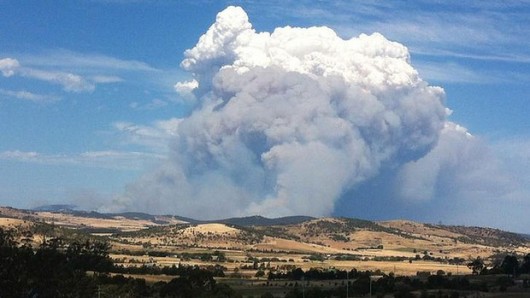
.
QUESTION 7:
.
Since Tasmania’s infamous 1967 fires when the Tasmanian Government forewent any plausible excuse it may have had of ‘bushfire innocence’, what subsequent measures and investment have been taken by the Tasmanian Govermment in (1) bushfire emergency planning and (2) bushfire emergency response – to mitigate the spread and impact of wildfire? Given that the Dunalley Bushfire Disaster occurred have these measure and investment been adequate in meeting community expectations of government responsibility in 2013?
.
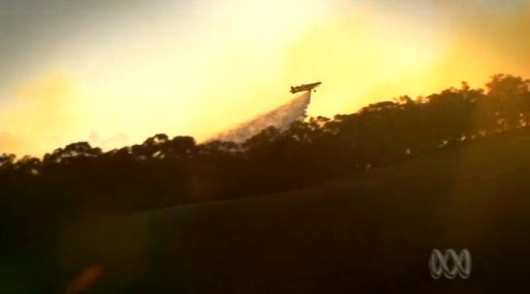
.
QUESTION 8:
.
What specific extra-ordinary bushfire fighting resourcing and strategies did the Tasmanian Fire Service seek and have implemented once it became aware of the forecast extreme bushfire weather conditions, and given that multiple uncontrolled bushfires, including the 6,000ha Poatina Fire, were demonstrating the extreme nature of the fire behaviour and already commanding TFS fire-fighting resources?
.
Dec 2012 Two Air Tractor 802 Fire Bombers secured
.
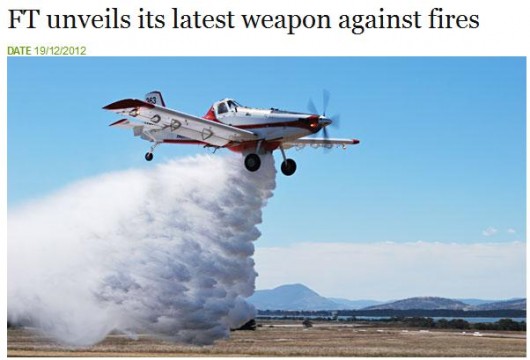 Air Tractor 802 fixed wing dedicated water bomber Air Tractor 802 fixed wing dedicated water bomber
.
Just two weeks ahead of the Forcett Fire, the Tasmanian Government’s corporatised forestry department, Forestry Tasmania, announced that it has secured two dedicated waterbombing aircraft from Victoria to be based at Hobart Airport (Cambridge).
Significantly, Forestry Tasmania holds the State’s monopoly delegated management responsibility for Tasmania’s native forest reserves, in which it exploits for commercial timber logging.
Two large native forest reserves were ultimately impacted by the Forcett Fire – one south of the Arthur Highway in the Sorell local government area that includes ‘Big Blue Hill‘ which appears to have no identifiable name, and the other on the Forestier Peninsula – ‘Yellow Bluff Creek Forest Reserve‘.
.
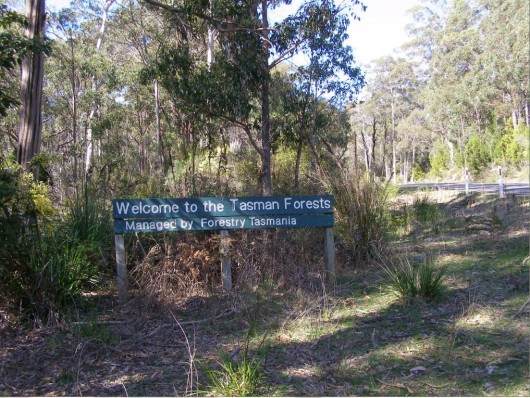 What does ‘managed’ mean?
[Photo by Editor, 20110926, free in public domain] What does ‘managed’ mean?
[Photo by Editor, 20110926, free in public domain]
.
<<Forestry Tasmania unveiled its latest weapon in the fight against forest fires at Cambridge Airport earlier this month. The two Air Tractor 802 fixed wing fire bombers were brought to Hobart from Ballarat (regional Victoria) for a week and were immediately put into action, fighting a bushfire at Musselroe Bay in the far North-East (Tasmania).
A private airstrip nearby enabled them to fill up with a mixture of water and foam from temporary inflatable tanks and be over the fire in minutes.
With a capacity of more than 3000 litres and taking just four minutes to fill up, the two Air Tractors, valued at $1.5 million each, dumped 40,000 litres in an hour and more than 150,000 litres on the Musselroe Bay bushfire.
Forestry Tasmania hired the planes and pilots from Field Air with the help of the National Aerial Firefighting Centre. Forestry Tasmania fire management head Tony Blanks said it was the first time the Fire Tractors had operated “in earnest” in Tasmania, where helicopters were more commonly used.”
.
[Source: ft-unveils-its-latest-weapon-against-fires’, 20121219, Forestry Tasmania website, ^http://www.forestrytas.com.au/news/2012/12/ft-unveils-its-latest-weapon-against-fires]
.
Problem was that although one Air Tractor was vitally needed to fight the Forcett Fire, the second aircraft was previously returned back to Victoria at a time when dozens of fires were burning across Tasmania and with forecast extreme bushfire weather.
Madness. Why?
.
QUESTION 9:
.
In the wake of the Dunalley Bushfire Disaster what subsequent measures and investment is the Tasmanian Govermment to implement in (1) bushfire emergency planning and (2) bushfire emergency response to mitigate the spread and impact of future wildfire across the State?
.
Preparation for an Extreme Forest Fire Danger Index?
.
So by early December 2012 unusually extreme bushfire weather conditions were forecast for Tasmania. But this was what Tasmania had experienced previously, albeit occassionally, but not as unique as some sensationalists in the media would have us believe.
Significantly, from a bushfire management operational perspective, numerous bushfires were already active and occupying the Tasmanian Fire Service and its related agencies, the Parks and Wildlife Service and Forestry Tasmania, reducing resource capacity to respond to new and escalating bushfire emergencies.
Was the Tasmanian Fire Service by 3rd January already overwhelmed?
.
QUESTION 10:
.
Why did the Tasmanian Fire Service, well aware of the looming extreme forecast bushfire weather, not request special additional resources, such as from Victoria, including prudent preparatory delivery of the dedicated and proven effective waterbombing heli-tanker, then parked and idle in a hangar at Essendon Airport Melbourne?
.
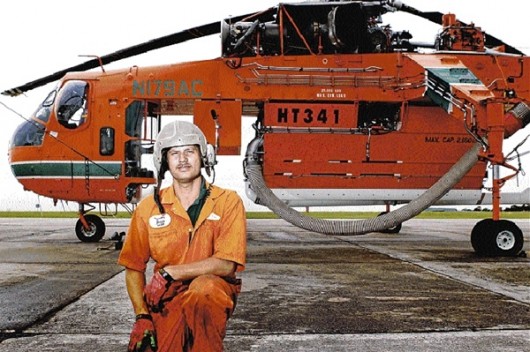 ‘Elvis’, the celebrated Erickson Heli-tanker, with specialist bushfire-fighting pilot ‘Elvis’, the celebrated Erickson Heli-tanker, with specialist bushfire-fighting pilot
A converted Sikorsky S-64E Skycrane, with a special “sea snorkel” and water tank
It is manufactured in Oregon, USA, dedicated to waterbombing bushfires and based at Essendon Airport Melbourne since December 2001.
Australia’s mainland states now have invested in at least four of them for standby bushfire application.
^http://www.ericksonaircrane.com/full_story/fullstory_firefighting.html
.
.
Yet Tasmanian fire authorities defended their choice of aircraft to fight the state’s catastrophic south-east bushfire, while a much bigger helicopter stood idle on the mainland.
As the fires still burnt through the Tasman Peninsula on Sunday night, authorities warned that they held fears for a handful of people unaccounted for after the main fire passed.
The Tasmanian Fire Service’s chief officer, Mike Brown, said it had been an option to use the heavy-lift Erickson Air-crane against the blaze that devastated Dunalley and nearby coastal hamlets on Friday.
Under national aerial fire-fighting arrangements, five of the Air-cranes are positioned on the mainland, each of them able to suck up nine tonnes of water in 40 seconds, and fly at 200 km/h.
The aircraft, such as Victoria’s ”Elvis” and ”Gypsy”, have become part of bushfire folklore.
The Victorian CFA confirmed that in Melbourne on Friday, a day when the south-east fires were already burning in Tasmania in what were officially described as catastrophic conditions, one Air-crane went unused in its Essendon hangar.
Mr Brown said the Air-Cranes, which were heavily funded by the Commonwealth, still required a contribution from Tasmania.
”So we’ve got to have here what’s available in terms of being able to support as well,” he said.
”The support we can provide to the medium helicopters gives us, we think, the best outcome.”
A spokeswoman for the federal Attorney-General’s Department said moving the Air-crane also depended on moving refuelling capability.
Due to the nature of the aircraft, this was slower than moving smaller helicopters such as the Bell 212, she said.
More than 100 structures, many of them homes, have been lost in small communities, mainly around the Tasman Peninsula, but also near Bicheno on the east coast.
Acting Police Commissioner Scott Tilyard said searchers had scoured the burnt-out homes in the worst-hit towns of Dunalley, Boomer Bay and Bream Creek without finding any bodies, but the community still needed to brace for possible deaths.>>
.
[Source: ‘Elvis is left idle despite raging inferno’, 20130107, by Andrew Darby, Hobart correspondent for Fairfax Media, ^http://www.smh.com.au/environment/weather/elvis-is-left-idle-despite-raging-inferno-20130106-2cb6c.html]
.
Post-Dunalley – TFS Requests interstate assistance
.
Sunday, 6th January:
<<As a result of the ongoing fire situation across the state, Tasmania Fire Service has welcomed and accepted offers of firefighting assistance from interstate authorities.
This will be in the form of personnel and will give some Firefighters and Incident Management Teams (IMT) the chance to have a break, as well as boosting firefighting numbers where needed.
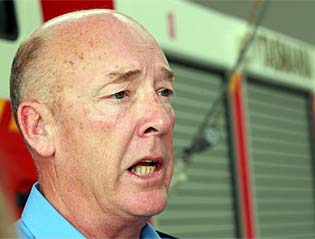 TFS Chief Officer, Mike Brown TFS Chief Officer, Mike Brown
.
TFS Chief Officer Mike Brown said:
“Tasmanian Firefighters have had a long record of providing assistance interstate and internationally over the years and our peoples skills and capabilities are highly regarded. I have been contacted by many of my counterparts from Western Australia through to New Zealand and many jurisdictions in between with messages of encouragement and offers for assistance.
Yesterday I spoke with the NSW Rural Fire Service Commissioner and the Victorian Fire Commissioner and arranged for Firefighters and Fire Specialists to provide some much needed relief for our people. I’m very grateful that they have been able to respond so quickly”.
.
The following are confirmed interstate deployment numbers coming to Tasmania:
- 7 x Rapid impact assessment officers from NSW Rural Fire Service (6 arrived yesterday, 1 today)
- 4 x liaison officers arrive today
- 17 x IMT personnel from Country Fire Authority Victoria, Department of Sustainability and Environment Victoria, & MFB arrive Sunday for Hobart
- 4 xIMT personnel arrive Sunday for Launceston
- 7 x Air operations arrive Sunday for Hobart
- 33 x Strike team firefighters arrive Sunday for Hobart (using TFS vehicles)
All personnel are due to return home on Friday.
“The potential for further requests for assistance will be considered later this week” TFS Chief Officer Mike Brown added.
.
[Source: Tasmanian Fire Service, Sunday 20130106, ^http://www.fire.tas.gov.au/Show?pageId=colMediaReleases]
.
[Ed: Better late than never, but tell that to the folk of Dunalley, Boomer Bay, Connelly’s Marsh and Copping!]
.
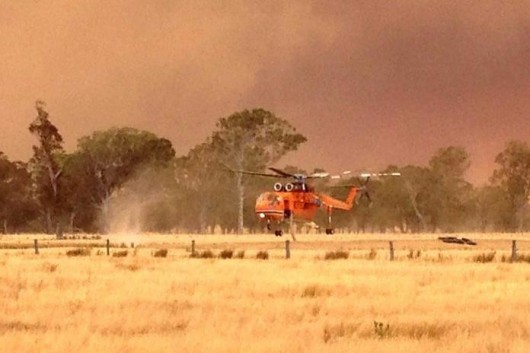 Erikson Aircrane deployed to the Forcett Fire on 3rd January? If only!
Sorry, this machine was deployed in Dawson in Gippsand, Victoria this month.
Same landscape, different State. Erikson Aircrane deployed to the Forcett Fire on 3rd January? If only!
Sorry, this machine was deployed in Dawson in Gippsand, Victoria this month.
Same landscape, different State.
.
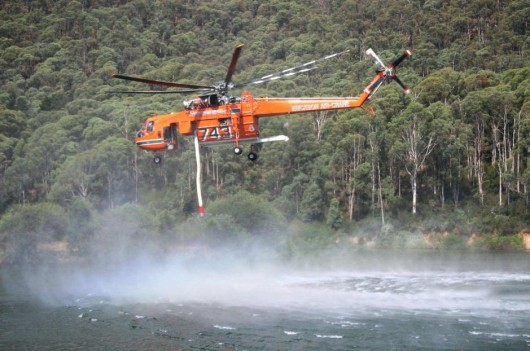 Erikson Aircrane deployed to the Forcett Fire on 3rd January? If only!
Sorry, this machine was deployed in Alpine Fire near Harrietville in Victoria this month. Erikson Aircrane deployed to the Forcett Fire on 3rd January? If only!
Sorry, this machine was deployed in Alpine Fire near Harrietville in Victoria this month.
..
When bushfire weather conditions become extreme – tinder dry bush and long grass, low humidity, temperature in the high 30 degree Celsius or hotter and strong winds – then the bushfire risk is exponentially heightened.
Bushfire risk is measured by the McArthur Forest Fire Danger Index (FFDI), which was developed in the 1960s by CSIRO scientist A.G. McArthur to measure the degree of danger of fire in Australian forests.
This Forest Fire Danger Index combines a record of:
- Vegetation Dryness (based upon rainfall and evaporation)
- Windspeed
- Temperature
- Humidity
.
A fire danger rating of between 12 and 25 on the index is considered a “high” degree of danger, while a day having a danger rating of over 50 is considered an “Severe” fire danger rating. Above this level in 2010 a distinction was made between Forest and Grassland fuels.
For Forest fuels, an FDI over 75 is categorised as “Extreme” and over 100 as “Catastrophic”. In Victoria, the alternate rating name adopted for Catastrophic is “Code Red”.
For Grassland fuels the threshold FDI values for the Extreme and Catastrophic Ratings was increased to 100 and 150 respectively. However,in Western Australia, which currently only uses the Grassland FDI, the values of 75 and 100 were being used as thresholds during 2012.
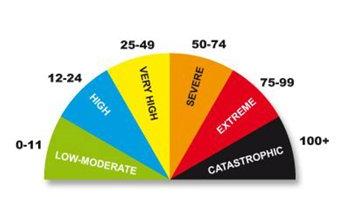 Fire Danger Ratings (from 0 to 100+) Fire Danger Ratings (from 0 to 100+)
‘Catastropic’ is a new category introduced across Australia
since the Victorian ‘Black Saturday’ tragedy of February 2009
.
McArthur used the conditions of the Black Friday fires of 1939 as his example of a 100 rating. The FFDI on Black Saturday, 7 February 2009, reached more than 200.
However, grassfires present a higher risk than forests under the same bushfire weather conditions, simply because grass is more flammable than timber.
.
National Framework for (bushfire) Scaled Advice and Warnings
.
In Victoria, in the months following the devastating Black Saturday bushfire disaster of February 2009, in which 173 people perished under catastrophic bushfire conditions ( a FFDI of over 200), new fire danger ratings were formulated based upon this fire danger index.
The ‘Low’ rating was merged with ‘Moderate’ and a new ‘Catastrophic’ rating was introdiuced over and above what had long been the top rating of ‘Extreme’.
The new Catastrophic (Code Red) rating involves a fire danger index above 100. Under these types of weather conditions fires will be unpredictable, uncontrollable and fast moving. The fires in Victoria on 7th February 2009 provide an example of the types of fires that may be experienced under a ‘Catastrophic’ rating.
Standard advice to communities under these conditions will be that leaving is the safest option for survival.
.
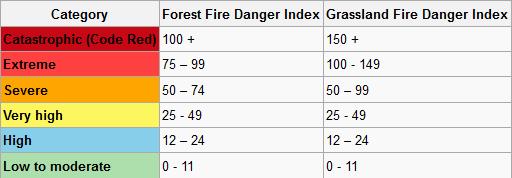 Australia’s National Fire Danger Ratings
since Sep 2009 Australia’s National Fire Danger Ratings
since Sep 2009
.
Australia’s new ‘National Framework for Scaled Advice and Warnings‘ were agreed and adopted by all Australian States and Territories at the Australian Emergency Management Committee meeting on 3rd and 4th September 2009. One would presume that this included Tasmania.
.
The national framework includes:
- The new Fire Danger Ratings (see above coloured table)
- The vague bushfire management slogan ‘Stay or Go’ replaced by similarly vague slogan: ‘Prepare, Act, Survive‘. *
- An agreed format for scaled warnings.
.
Other agreed bushfire management emergency protocols also include:
- Forecast fire danger advice will be issued throughout the media and will be aligned to the new fire danger ratings (which is based on the fire danger index)
- Key messages have been designed to clearly communicate what is likely to occur if and when a fire starts for each of the fire danger ratings. Messages will include specific actions for the community to take during this outlook period.
- The CFA Chief Officer will have responsibility for issuing warnings to the community during fires; delegated to local Incident Controllers with a backup in the State Duty Officer in the iECC.
- Information units will have operational guidelines and the technological capability in place to enable them to quickly issue accurate warnings. Approval will occur at local incident level by the IC or deputy IC.
- Where an ICC has not yet been established, warnings can be issued on behalf of the IC by information units in the RECC or iECC.
- Warnings will be disseminated throughout a variety of media, for example websites, local radio and VBIL simultaneously via a single entry tool known as One Source One Message (OSOM). This will ensure that warnings are provided to all sources at the same time, will appear in the same format and contain the same language.
- The iECC (or SECC) Information Unit will play a monitoring and auditing role in relation to community warnings, as well as a pro-active role when a warning hasn’t been issued or released.
- All areas will have access to OSOM* (warning system). It can be issued at a very local level (for example at a regional office before an ICC has been set up) or in the iECC which will be manned throughout high fire danger rating or fire danger indicator days
- In accordance with Royal Commission recommendations, there will be two warning categories, and three levels of information:
.
-
- ‘ADVICE‘: This will advise you that a fire has started but there is no immediate danger, and includes general information to keep you up to date with developments.
- ‘WATCH AND ACT‘: This is a heightened level of threat. Conditions are changing and you need to start taking action now to protect you and your family.
- ‘EMERGENCY‘: This will indicate that people in specific locations are in danger and need to take action immediately to protect life, as they will be impacted by fire.
.
* NB. The One Source One Message (OSOM) tool is a system with a single, multi-agency web-based portal to publish real time messages using standard incident management templates.
.
[Source: ‘New warning system explained’, by Bushfire Preparedness Program 2009/10, Victorian Country Fire Authority, 20090910, ^http://www.cfaconnect.net.au/index.php?option=com_k2&view=item&id=873]
.
Ed:
A clearer, unambiguous bushfire response slogan to replace ‘Prepare, Act, Survive‘ could be:
.
‘No Bushfire Defence Certificate?
Self-evacuate now to your nearest registered Emergency Evacation Centre!‘
.
It is high time that under bushfire rated conditions that are ‘Severe’ or ‘Extreme’ and when a wildfire is within a given risk range, that governments legally compel all residents situated in high bushfire-prone areas to compulsorily self-evacuate to a registered Evacation Centre unless they hold a current Bushfire Defence Certificate.
Such a certificate would at a minimum require:
.
(1) Meeting minimum standards of building construction in compliance with the Australian Standard for construction of buildings in bushfire prone areas (AS 3959-2009)
(2) Preparation of property bushfire defence inspected and certificied by a bushfire delegated authority for the current season
.
Under bushfire rated conditions that are ‘Catastrophic’ and when a wildfire is within a larger given range, ALL bushfire-prone residents, ought to be legally compelled to compulsorily self-evacuate to a registered Evacation Centre, irrespective of whether they hold a current Bushfire Defence Certificate or not.
.
.
No Fire Danger Index used by TFS in the Forcett Fire
.
Although, this bushfire danger rating system was officially in place across Tasmania since late 2009, the Tasmanian Fire Service chose not to include fire danger indices on its website or via the Tasmanian media. Why not?
The following remains the format of the TFS public notice of active bushfires; in this case the ‘Forcett Fire’:
FORCETT FIRE:
.
<<Alert Level: [Going] Advice
Type: VEGETATION FIRE
Last Updated: 13-Jan-2013 8:18 AM
First Reported: 03-Jan-2013 2:13 PM
Location: Inala Road, FORCETT
Status: Going
Agency: Tasmania Fire Service
Incident Number: 201651
Size: 24,040 Ha
Details: Bushfire Advice Message FORCETT FIRE 201651 Current from:13/01/2013 08:12 AM until: 13/01/2013 11:00 AM or further notice There is a large bushfire at between Forcett and the Tasman Peninsula . The fire danger rating in this area is forecast to be high for today. Fire under these conditions can be difficult to control . There is no immediate threat to communities. This bus …
More Info | Current Incident List>>
.
[Source: TFS website, 20130113, ^http://www.fire.tas.gov.au/]
.
QUESTION 11:
.
How effectively then, does the above bushfire information by the TFS assist potentially impacted people to be appropriately informed about the fire risk category of danger, the spatial fire threat (where it currenty is, which direction the fire front(s) is/are currenty headed, how fast it is moving, forecast changes), the timing of the threat to various ‘at-risk’ people? How effectively does the above bushfire information assist these people to appropriately prepare to either defend their properties or else to self-evacuate? Where are the registered evacuation centres for people?
.
QUESTION 12:
.
In Tasmania, does the Tasmanian Fire Service measure, use and publish a specific forecast and actual Fire Danger Index based upon weather information received from the Bureau of Meteorology? Does the TFS use the Forest and/or Grassland index? Why were such indicators not provided on the TFS website or via the Tasmanian media in relation to the current 2012-13 summer season ahead of and during the recent bushfire emergencies across the State? Is the publicised TFS bushfire emergency information adequate?
.
3 Jan 2013: Forcett Fire Reported
.
It is not officially publicly reported how the Forcett Fire was first detected by the responsible bushfire fighting authority, the Tasmanian Fire Service on the 3rd January 2013, except that the Tasmanian Fire Service website states consistently in successive daily updates that the “First Reported time was “03-Jan-2013 2:13 PM” at Location “Inala Road, FORCETT“.
After the disaster impacting Dunalley, Boomer Bay, Copping and other communities, on Tuesday 8th January, as the result of detailed investigations jointly conducted between Tasmania Police and the Tasmania Fire Service, the cause of the fire commonly referred to as the Forcett Fire had been officially determined.
<<The cause has been determined as of an accidental nature with the fire emanating from an old fire in a burnt out tree stump at Forcett. This fire has smouldered through the root system and ignited in the weather conditions of Thursday 3 January.
Detectives and Fire Scene Examiners from the Tasmania Fire Service have interviewed all available witnesses and people with information thereby assisting in their determination on the fire.>>
[Source: ‘Forcett fire – cause determined’, 20130108 2:34pm, Tasmanian Police, ^http://www.police.tas.gov.au/news/posts/view/3789/forcett-fire-cause-determined/]
.
But this ‘determined cause’ was the consequence of a prior fire that has not been publicly reported. The reason for the relatively prompt cause being determined and officially declared by the Tasmanian Police was to legally trigger insurance claim processing to the insured victims, which is understandable.
However, the original cause of the “old fire in a burnt out tree stump at Forcett” remains publicly undetermined.
The Tasmanian Fire Service website states that the fire ignited near Inala Road, Forcett on 3rd January 2013. Inala Road is situated about 2km east of the rural village of Forcett along the Arthur Highway. It is a one kilometre long gravel No Through Road that connects half a dozen farm properties to the Arthur Highway. See map below.
.
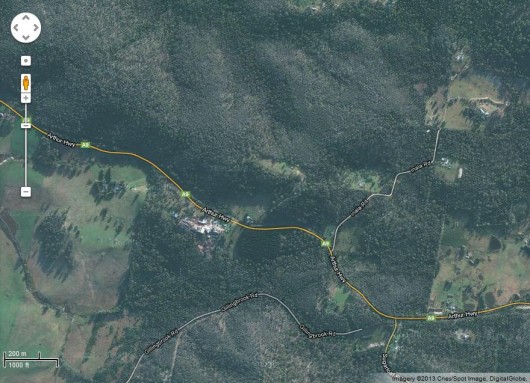 Inala Road Forcett Satellite Map, 2011
Click image to enlarge (Inala Road is top right)
[Source: Google Maps] Inala Road Forcett Satellite Map, 2011
Click image to enlarge (Inala Road is top right)
[Source: Google Maps]
.
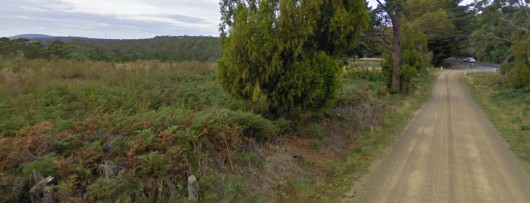 Inala Road near the intersection of the Arthur Highway in 2010
Photo looks south, with the hills toward Dunalley on the left.
Inala Road is characterised by farmland interspersed with partially deforested native bushland, and patchy regrowth.
Click image to enlarge.
[Source: Google Maps, March 2010] Inala Road near the intersection of the Arthur Highway in 2010
Photo looks south, with the hills toward Dunalley on the left.
Inala Road is characterised by farmland interspersed with partially deforested native bushland, and patchy regrowth.
Click image to enlarge.
[Source: Google Maps, March 2010]
.
Inala Road is easily accessible by fire trucks, so with a small fire and with low wind conditions, the prospect of suppressing the fire early on the afternoon of Thursday 3rd January would have been greater than at any subsequent time before it impacted Dunalley 24 hours later.
The exact location of the ignition along Inala Road has not been reported by the Tasmanian Fire Service on its website. Like most fore agencies, the Tasmanian Fire Service chooses to delete (censor) operational fire records after a few days.
However, a Forcett Fire Map provided on the ABC News website dated 4th January 2013 was obviously obtained by the ABC from the Tasmanian Fire Service, shown below:
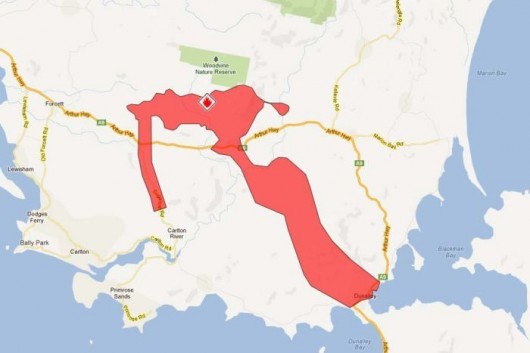 Forcett Fire Map (Friday, 4th January 2013)
[Source: ABC News website, ^http://www.abc.net.au/news/2013-01-04/forcett-fire-places-homes-at-risk/4453038] Forcett Fire Map (Friday, 4th January 2013)
[Source: ABC News website, ^http://www.abc.net.au/news/2013-01-04/forcett-fire-places-homes-at-risk/4453038]
.
Observations from the above TFS Forcett Fire Map:
.
1. The ignition source of the fire was north of the Arthur Highway along Inala Road (top left of above map). This places the TFS confirmed ‘burning stump’ midway along Inala Road, per juxtaposed mapping below.
.
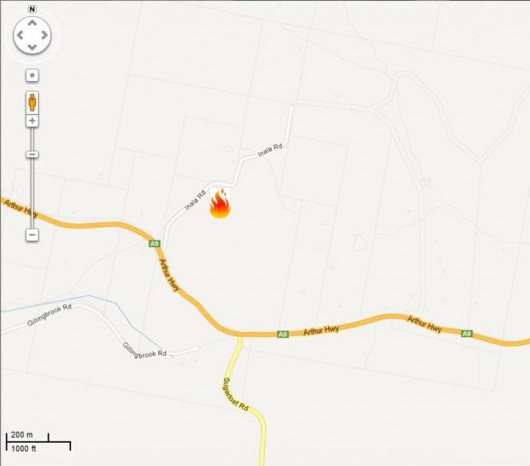 Deduced Ignition Location of the Forcett Fire
In the absence of TFS publicly confirming the exact location of the ‘burnt stump’ ignition source,
by deduction from the Forcett Fire Map above, the Inala Road ignition source appears midway along Inala Road, Forcett. Deduced Ignition Location of the Forcett Fire
In the absence of TFS publicly confirming the exact location of the ‘burnt stump’ ignition source,
by deduction from the Forcett Fire Map above, the Inala Road ignition source appears midway along Inala Road, Forcett.
.
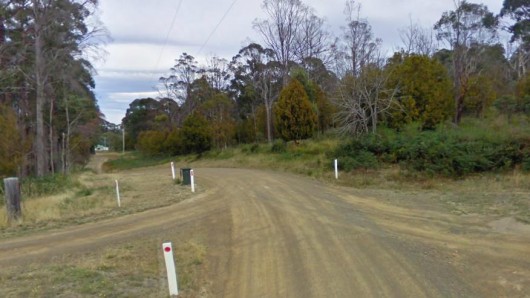 Inala Road
Where along Inala Road was the burning stump that re-ignited the Forcett Fire?
Ask the TFS.
It is incumbent upon the Tasmanian Fire Service to be transparent about the exact source loation of this fire so that the truth be known. Inala Road
Where along Inala Road was the burning stump that re-ignited the Forcett Fire?
Ask the TFS.
It is incumbent upon the Tasmanian Fire Service to be transparent about the exact source loation of this fire so that the truth be known.
.
2. Consistent with the prevailing north-westerly windwind, the direction of this fire was that it initially headed easterly after re-igniting from the declared ‘burning stump‘ in the afternoon of Thursday 3rd January. Sometime in the evening of the 3rd January the wind reverted to the prevailing direction from the north-west and thereafter continued consistently from this direction through the couyrse of the following two weeks into the Forestier Peninsula.
.
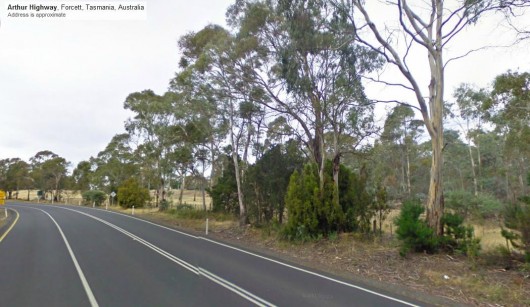 Open farmland along Arthur Highway, near the Inala Road intersection
looking south east toward Dunalley Open farmland along Arthur Highway, near the Inala Road intersection
looking south east toward Dunalley
Click image to enlarge
[Source: Google Maps, March 2010]
.
3. The separate strip of fire burnt south along the Sugarloaf Road would appear to be specifically contained and so likely to be a deliberately lit control line/fire break defensively intended to prevent the main wildfire crossing the road in the event of a wind change to the east. This is conjecture in the absence of TFS public explanation on its website.
.
QUESTION 13:
.
What was the cause of the “old fire in a burnt out tree stump”. Lightning doesn’t usually light tree stumps; trees on ridges yes. But Inala Road is not on a ridge, so the lightning excuse is a convenient furphy. Was the fire a consequence of a farmer’s ‘pile burn’ or ‘burn off’? Who lit the fire?
Was the burn off authorised by the Tasmanian Fire Service? If so why, when it is summer and at a time of high bushfire risk? What investigations are being conducted by the TFS and/or Tasmanian Police into the original cause of the fire?
.
Jan 2013: Bushfire Conditions around Dunalley
.
Prevailing Wind
.
As the crow flies, Hobart Airport is about 12km from the ignition source that purportedly started the Forcett Fire near Inala Road, and Hobart Airport is about 25km from Dunalley.
The following wind rose chart of the Bureau of Meteorology shows that over the past half century, the prevailing wind for Hobart Airport is predominantly from the north-west. This may be generally extrapolated for the surrounding Sorrell local government area, including Forcett and Dunalley.
.
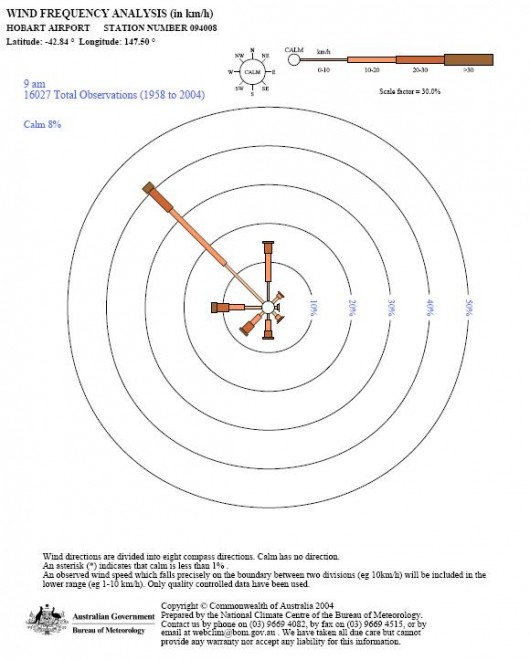 Average Wind at Hobart Airport (1958-2004)
This Wind Rose chart shows the prevailing wind predominantly being from the north-west at typically 10-20kph.
This was the wind at Forcett and Dunalley on 3 and 4 January 2013 – significantly nothing surprising! Average Wind at Hobart Airport (1958-2004)
This Wind Rose chart shows the prevailing wind predominantly being from the north-west at typically 10-20kph.
This was the wind at Forcett and Dunalley on 3 and 4 January 2013 – significantly nothing surprising!
[Source: Australian Bureau of Meteorology,
^http://www.bom.gov.au/climate/averages/climatology/windroses/wr09/wrpdf/094008-9amAnnual.pdf,
>Read Chart]
.
Significantly, the prevailing wind is a most relevant environmental factor in the Forcett Fire, because of the juxtaposition of Forcett to Dunalley.
The ignition source at Inala Road Forcett was north west of Dunalley, the same as the prevailing wind.
Wind typically increases in the early afternoon as the temperature differential between the hotter land mass and the nearby cooler sea strong maximises. This is referred to as a diurnal wind pattern. On Friday 4th January as temperatures soared, this wind was predictably due to increase and at around 2pm it did. The 15 km/h breeze increased to a recorded peak of 52km/h at 1.57pm.
So the Forcett Fire on 3rd January was predictably and reliably going to burn toward Dunalley. The diurnal wind pattern at the time was nothing extra-ordinary, and therefore would have been predictable.
.
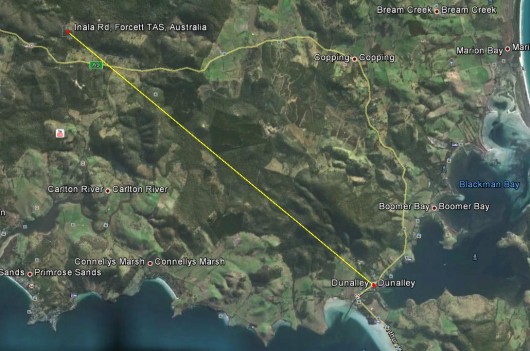 Ignition source at Inala Road, Forcett was 17km North West of Dunalley
Click image to enlarge
[Source: Google Earth] Ignition source at Inala Road, Forcett was 17km North West of Dunalley
Click image to enlarge
[Source: Google Earth]
.
QUESTION 14:
.
Given that a light north west prevailing breeze was predictably fanning the Forcett Bushfire toward Dunalley in the afternoon and evening of 3rd January, what firefighting response including backburning was undertaken to prevent the Forcett Bushfire’s spread south east toward Dunalley?
.
All Thursday afternoon, through Thursday night and all Friday morning the observed wind was relatively light. The following account is poignant:
“A couple of kilometres just off the Arthur Highway at Fazackerlys Rd, a small group of farm workers, some locals and a police officer watched from a safe distance the fire which had burned slowly all morning in the wooded hillsides to the north. The smoke rose straight up from several large and small outbreaks burning around farmland.”
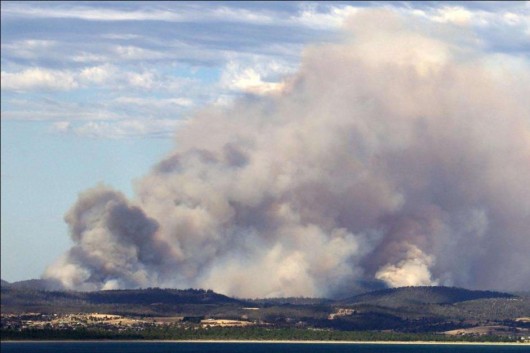 The Forcett Fire on the afternoon of Thursday 3rd January 2013
Burning out of control south of the Arthur Highway heading right (south east)
Low winds meant it was not a fast moving firestorm at this stage.
View across Frederick Henry Bay looking north-east, perhaps Bally Park/Carlton settlement in the foreground.
(Photo by Ian Stewart, 20130103, click image to enlarge) The Forcett Fire on the afternoon of Thursday 3rd January 2013
Burning out of control south of the Arthur Highway heading right (south east)
Low winds meant it was not a fast moving firestorm at this stage.
View across Frederick Henry Bay looking north-east, perhaps Bally Park/Carlton settlement in the foreground.
(Photo by Ian Stewart, 20130103, click image to enlarge)
.
So, the Forcett Fire on the morning of Friday 4th January was still slowing burning through relatively accessible farmland under light wind conditions. Why wasn’t it extinguished?
.
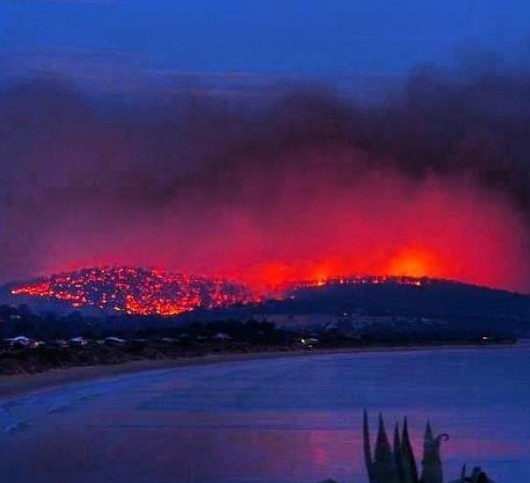 Forcett Bushfire
(Photo by Moemahfoudh, 20130104) Forcett Bushfire
(Photo by Moemahfoudh, 20130104)
.
QUESTION 15:
.
Given that the Forcett Fire was still declared uncontained by the Tasmanian Fire Service in the morning of Friday 4th Jaunary, what addition emergency bushfire response measures were implemented by the TFS to prevent the fire impacting Dunalley?
Did the Bureau of Meteorology publicise forecast increased wind speed and the extreme temperature for 4th January on the 3rd January? What Fire Danger Index was forecast by the TFS for 4th January for the ongoing Forcett Fire and was it not clear to the TFS that the risk to Dunalley and Boomer Bay from the Forcett Fire was catastrophic?
.
The 2pm Diurnal Wind
.
…and then the wind came up…at Fazackerlys Rd just after 2pm, all hell broke loose. The fire had taken a run.
As the Forcett Bushfire impacted Dunalley at around 2pm on 4th January, recorded wind gust reached 80km/h, driving the fire south into Dunalley at unstoppable speed.
Bushfires are known to fan their own wind. According to the CSIRO, bushfires can generate their own wind. “Strong convection set up by the heat of the fire creates an in-draw wind that can interact with the prevailing wind. Depending on the direction of the prevailing wind and the location of the fire, this in-draw wind may increase or decrease the strength of the prevailing wind.”
[Source: Fire Generating Wind, ^http://www.csiro.au/en/Outcomes/Safeguarding-Australia/FireGeneratedWind.aspx]
.
High Temperatures
.
On 4th January 2013, maximum temperature records were broken at eight weather stations across Tasmania. Hobart reached 41.8°C, breaking the previous temperature record by 1°C.
However, as explained above, these extreme temperatures although technically breaking records, were only doing so by marginal degrees on the 3rd January. Tasmania had recorded similar extreme hot summer temperatures on at least seven previously documented occasions. So, despite media sensationalism and the vested interest of the Australian Government’s climate change commission to claim justification for its government-dependent revenue, by no means were the temperatures of January 2013 unprecedented, or ‘off the scale‘.
Yes, it was forecast to be an unusually very hot dry summer for Tasmania, no more no less.
Read Climate Commission report: >’Off the charts: Extreme Australian summer heat‘
[Source: Climate Commission, Australian Government, ^http://climatecommission.gov.au/wp-content/uploads/CC_Jan_2013_Heatwave4.pdf]
.
The Bureau of Metorology has published the maximum daily temperatures for Australia, including Tasmania, through January shown by colour as follows.
Click on the image and see the changing temperatures specific to Tasmania:
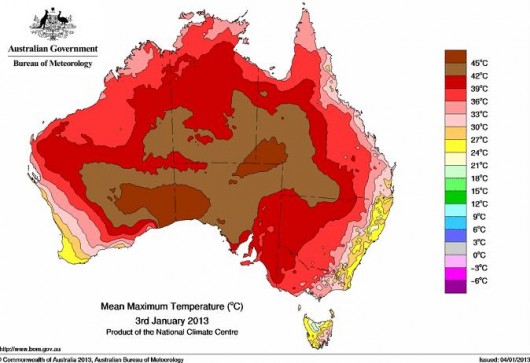 Australia’s maximum temperature mapping through January 2013
Click image to show dynamic progress
Note Tasmania on 3rd January was still in the 30s.
[Source: Australian Bureau of Meteorology,
^http://www.bom.gov.au/web03/ncc/www/awap/temperature/maxave/daily/colour/latest.loop.gif]
Australia’s maximum temperature mapping through January 2013
Click image to show dynamic progress
Note Tasmania on 3rd January was still in the 30s.
[Source: Australian Bureau of Meteorology,
^http://www.bom.gov.au/web03/ncc/www/awap/temperature/maxave/daily/colour/latest.loop.gif]
.
Specific to Dunalley, according to its local BOM weather station, the temperatures for January 2013 read as follows.
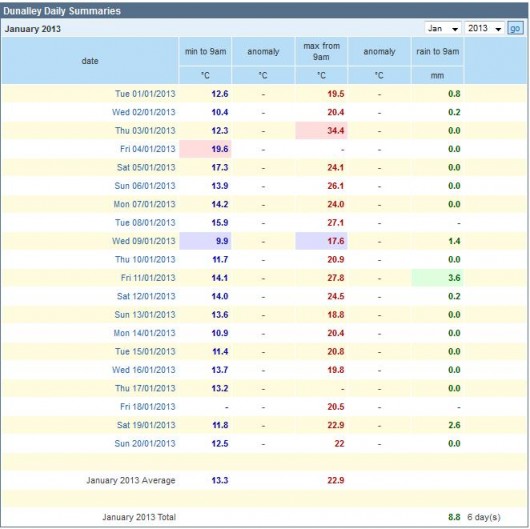 [Source: ^http://weather.ninemsn.com.au/station.jsp?lt=site&lc=94254&list=ds] [Source: ^http://weather.ninemsn.com.au/station.jsp?lt=site&lc=94254&list=ds]
.
Significantly, Thursday 3rd January 2013 peaked at a very high 34.4 Celsius. The maximum on the following critical day Friday 4th January is not recorded. This is likely due to the Dunalley gauge reader being otherwise pre-occupied escaping from the impacting bushfire.
Anecdotally the mid afternoon temperature spiked at 40.2 Celsius at around 2pm that day, and about a kilometre south-west the Stroud Point weather station registered 54.9 Celsius at a time not disclosed – perhaps between 2:30pm and 3pm that day.
[Source: ‘From spark to raging inferno’, 20130113, by David Killick in The Sunday Tasmanian. See extract below]
.
QUESTION 16:
.
Given the pre-existing bushfires across the State causing concern, the forecast bushfire conditions, the known prevailing NW wind across the Sorrell Council area (Forcett – Dunalley) what special bushfire emergency response measures did the Tasmanian Fire Service take critically on 3rd January 2013, on being alerted to the Inala Road ignition to prevent the fire spreading? Why was the fire not contained on the 3rd January, while it was in accessible farmland, before it advanced slowly into hilly less accessible timbered State reserves toward Dunalley?
.
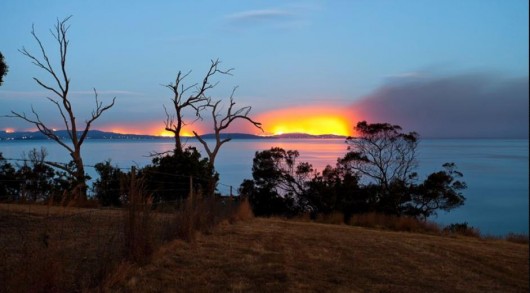 Forcett Fire approaching Dunalley and Boomer Bay
[© Photo by Michael Gay Photography, 20130103] Forcett Fire approaching Dunalley and Boomer Bay
[© Photo by Michael Gay Photography, 20130103]
.
So the following article extract provides the best light on what happened on the Friday, 4th January 2013 at Forcett:
.
‘From spark to raging inferno’
by David Killick
.
<<IT only takes a spark to start a fire.
At Inala Rd near the south- eastern Tasmanian town of Forcett, that spark is believed to have been struck some time before Christmas.
A landowner was clearing a tree stump the old fashioned way by burning it out. They thought the fire was out, but it smouldered unchecked in the root system for two weeks, before flaring and dooming a town.
The morning of Friday January 4, 2013, was unremarkable in Dunalley.
It was warm and still.
If anything it was perhaps a little quieter than normal.
The heat and the fire risk warning encouraged some people to leave and traffic through the town was light despite the school holidays.
Inside the weather station by the water at Stroud Point, the temperature ticked over the 30C mark just before midday.
At the Dunalley Fish Market in Fulham Rd, tourists and families stopped to eat their lunches.
Along Marion Bay Rd at nearby Copping, many residents seemed to have taken the advice of fire authorities and left.
Local shopkeeper Kate North was concerned, but not overly so.
“If the wind doesn’t come up we should be OK,’’ she said. “The problem will be if it gets into the bush and heads towards Dunalley.’’
A couple of kilometres just off the Arthur Highway at Fazackerlys Rd, a small group of farm workers, some locals and a police officer watched from a safe distance the fire which had burned slowly all morning in the wooded hillsides to the north.
The smoke rose straight up from several large and small outbreaks burning around farmland.
.
And then the wind came up
.
And then the wind came up. At 1.43pm, give or take a minute either side, a wall of flame suddenly emerged above the treetops, leaping into the air, 20 or 30 metres high.
Burning embers began to rain down. The south-easterly wind had swung west. The gust that fanned the fire hit Dunalley 8km away at 1.57pm at 52km/h. The temperature spiked 5C in six minutes to 40.2C.
There is an unholy trinity that keeps bushfire fighters awake at night. High temperatures, strong winds and low humidity.
Add heavy fuel loads and a source of ignition, and there is no force of man that can stop a bushfire.
The 2009 Victorian fires which killed 173 people have seared the word “catastrophic’’ into the popular lexicon the fire danger beyond “extreme’‘.
These were the conditions that existed in the hills north of Dunalley.
As one man put it, conditions on January 4 were unlike anything Tasmania has seen since 1967.
“I’ve been a firefighter for 35 years. I have never seen a fire so destructive as that was on Friday,” he said.
“On a day like that you cannot fight a fire. It doesn’t matter how much water or how many helicopters you have.’”
AT Fazackerlys Rd just after 2pm, all hell broke loose. The fire had taken a run. All of a sudden four houses and their outbuildings were surrounded by the flames.
The Tasmania Fire Service crews raced from outbreak to outbreak, saving what they could.
Local Todd Hildyard had been on a bulldozer several hundred metres away.
He raced the flames to his back steps and with a hose and the help of his teenage son somehow stopped the home going up.
“We were bloody lucky – she was awful close to getting in here,” Mr Hildyard said.
Another group fought a desperate battle just up the road.
Although a house near the highway was saved, one by one the flames claimed sheds and outbuildings.
The beautiful old hay shed by the highway went up.
Less than a kilometre away at the top of a hill above Copping, John Yaxley was fighting an astonishing battle to save his place surrounded by bush, most of it ablaze.
Somehow he saved his home and a shed with $60,000 worth of wine inside, but his parents’ grand pentagon-shaped hilltop house was lost, as was the caretaker’s home.
Locals watched helpless from the shade outside Kate North’s shop at Copping.
Amid the light grey smoke of burning bush could be seen the terrible dark smoke of people’s homes going up in flames.
One older man watched his home burn.
“I saw it catch fire, I knew where to look and I thought `any moment now’ and it went up. There’s a lot of nice things gone but that is the way of the world. It’s a devil of a thing.”
The fire rolled down the ridgetops to Marshton Lane.
In a hurried roadside conference as the flames raged around, the firefighters knew the task was already too great.
Getting in front of this fire would be an act of suicide.
“Guys, it’s all turned to shit,” said one.
Those there say that just after 3pm the hellfire rolled over the hill behind the golf course like a storm.
A terrifying black, red and purple wall of flames.
Smoke darkened the sky.
Helicopter pilot Ben Brolewicz watched from above.
“It was probably as bad as it gets. With all of the heat that it generated it created a sort of a vortex that picked stuff up and flung it through the air,’’ he said in an interview with the ABC.
Bryan Webster called it a “tsunami of fire”.
With his partner Fiona Hills and her 11-year-old son Darcy Scott, Mr Webster fled to the water’s edge as the fire roared into town.
The family sheltered in the water for two hours with a mob of terrified wallabies for company.
At another jetty, another miraculous escape.
The Holmes family, grandma, grandpa and five grandchildren in their care fled the flames and sought shelter.
A haunting snapshot taken of them sheltering in the water has become the iconic image of these fires worldwide.
The family were calm, but huddled and prayed. Not one was harmed.
Josh Clements’ home was saved. His parents weren’t so lucky. He and his family pushed a boat out into the canal as the front hit and floated in the bay for several hours.
Hundreds of metres from the burning town, the Stroud Point weather station registered 54.9C.
The wind by now was gusting to 80km/h, driving the fire to the south.
The school went up, as did the police station, the bakery and many homes.
But somehow not a single life was lost.
Those who were not in the water were shepherded by police to the local pub to shelter – a move that saved scores of lives.
AS Dunalley burned, the fire spread left and right, from its formerly narrow front.
The eastern edge moved into Boomer Bay – a pretty community of waterfront shacks.
Just after 4pm, Steve Fisher and several dozen other locals watched as the fire approached steadily through knee-high grass.
“We’ll stick with it as long as we can,” he said calmly.
At that moment, just a few hundred metres away to the south, dozens of people were fighting for their homes and their lives.
Simon and Tully Brooks tried to fight the grassfire as it approached.
The father and son attacked with buckets and hoses, but their house went up.
They knew it was hopeless. They grabbed what valuables they could and fled.
Lex Johnson saw his neighbours run for their lives. “I was up at the corner when it circled around the back and through the trees behind our property,” he said.
“And then we saw the people from down the road running to get away from the fire . . . and it was catching up to them.”
Those cut off by the fires fled to the jetty where many were saved by the bravery of a helicopter crew.
The crew of paramedics returned over and over in thick smoke and plucked people from the water including a pregnant woman and five dogs.
On a point just east of Dunalley, not far from the weather station, it was helicopters too that saved the Jenkins family.
Ten members of the family had moved their caravans and cars to the water’s edge as the fire burst over the nearby hills.
As the flames drew close, a helicopter appeared and doused the family again and again until the threat had passed by.
Further north, at Connellys Marsh the battle would rage through the night.
Cut off from all outside help, neighbours banded together to keep each other safe.
A flotilla of small boats ferried away those who wanted to leave and then those who stayed faced the flames.
Martin Thorpe returned to watch the shack his family had cherished for 30 years, razed by the fire.
GRAEME Grundy dragged a neighbour to safety then fought with Mr Thorpe to save his own place – in part thanks to a water pipe that burst at just the right moment, showering the place with the remaining water from his 1000-gallon tank.
When the sun rose, the seaside hamlet was dotted with small clearings filled with smouldering ruins.
Somehow, more homes were saved than lost.
As the survivors contemplated their extraordinary night, the fires delivered one last cruel blow. The last home to be lost at Connellys Marsh went up around 8am.
The Inala Rd fire caused more havoc and destroyed more homes and continues to burn in spots south of Eaglehawk Neck, but most of the damage took place in about three hectic hours.
An inquiry will determine how – against all odds – not a single human life was lost or a serious injury sustained that Friday. Fire chiefs say there has been much planning and many lessons learnt from Black Saturday in Victoria in 2009. After such horrific losses as Victoria’s, people are far more aware of the risk of fire.
And communications have improved since then too. The hundreds of broadcast alerts, website updates and urgent text messages played their part.
And there was some luck. The area was surrounded by water which gave so many a place to run to when it all became too much.
But summer is not over yet. After a long dry spell, huge tracts of the Tasmanian bush are loaded with fuel.
The peak of our fire season is still weeks away. As hard as it is to believe, the worst may not yet have passed.>>
.
[Source: ‘From spark to raging inferno’, 20130113, by David Killick, in The Sunday Tasmanian (not published on the Internet), but reproduced in the Tasmanian Times; additional reporting by Zara Dawtrey, Matt Smith, Bruce Mounster, Blair Richards, Linda Smith, and Tim Martain, posted by PB 20130115, ^http://tasmaniantimes.com/index.php?/weblog/article/the-new-normal/show_comments]
.
Hindsight Local Reflections
.
Most of the bushland that the bushfire burnt through before impacting Dunalley was privately owned.
Locals in the Tasmanian fishing village of Dunalley say the fire which ravaged their community would not have been so ferocious if hazard reduction burns had been carried out before the summer.
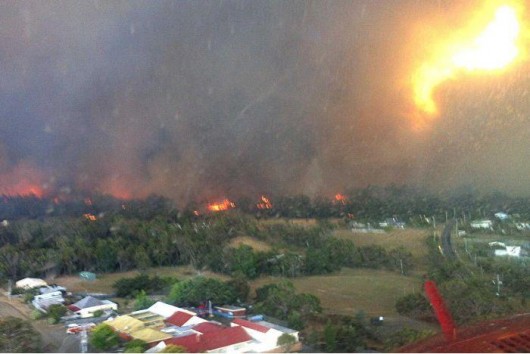 A massive fireball bears down on Dunalley on Friday.
The Dunalley Primary School in the foreground would be soon destroyed.
[Source: Photo by Michael Goldsmith, Tasmania Fire Service,
^http://www.abc.net.au/news/2013-01-10/fireball-2jpg/4459102] A massive fireball bears down on Dunalley on Friday.
The Dunalley Primary School in the foreground would be soon destroyed.
[Source: Photo by Michael Goldsmith, Tasmania Fire Service,
^http://www.abc.net.au/news/2013-01-10/fireball-2jpg/4459102]
.
A total of 126 properties were destroyed or damaged in the Dunalley fire, and a photo (above) given to the ABC yesterday and taken from a fire-fighting helicopter shows a giant fireball bearing down on the town at the height of the inferno.
.
The following audio is hindsight feedback from local residents of Dunalley and the immediate surrounding area, about their citizen lay views about what could have been done to prevent Dunalley burning.
.
Audio: Listen to Felicity Ogilvie’s report (ABC Radio News, AM Programme, 20130110):

.
One resident who still has a home is oyster farmer Justin Gock.
“I believe that if you’ve got people living in areas where there’s substantial forests, there should be significant management plans in place to control situations like this,” he said.
“Because if these areas were back-burned like they used to and the infrastructure was in place, fair chance it might not have happened.”
Tony Disipio, who lost his house in the blaze, is critical about the lack of preventative burns around Dunalley.
“Well 25 years ago they used to burn off regularly around the hills, it was like a winter thing, a winter exercise,” he said.
“And I noticed over the years that there was just less and less of it.”
Homes damaged by bushfire seen from above between Dunalley and Boomer Bay, Tasmania Photo: A total of 126 properties were destroyed or damaged in the Dunalley fire. (AAP
Farmer Sandy Gray has also noticed that preventative burns have been declining in recent times.
“In the old days, they used to go around and just quietly do a few, especially on the northern, north-western sides of the townships like Dunalley. It’s a pity they don’t still do it,” he said.
The State Government and Fire Service are promising to review their policies on controlled burns, but with fire warnings still current for parts of the state, they say they will wait until the current crisis is over.
The Tasmanian Fire Service’s Deputy Chief Officer, Gavin Freeman, says there has been no reduction in preventative burn-offs near Dunalley.
“I don’t believe there has been less done. You can always look back with a bit of hindsight and say yes, we could do more perhaps,” he said.
“But until we get these fires under control and are able to look back and do a proper analysis of where the fires have burnt to and what they burnt through – and bear in mind, under catastrophic conditions – we don’t really know whether that field reduction burning would be a benefit or not.”
The fire service may do some burn-offs, but the responsibility for preparing for a bushfire lies with the land owner.
At Dunalley it appears most of the bushland the fire tore through is privately owned.
The Tasmanian Minister for Emergency Management, David O’Byrne, says public land accounts for 20 per cent of the area affected by the fire.
“Fuel reduction and that sort of management is a joint responsibility between government, in terms of our land and in the parks land, but also in the private land that is around Tasmania,” he said.
“It’s important we have a community conversation around this. Now is not the time for that conversation, we need to get these fires under control.
“Once we can assess the impact of the fuel loads around… we can have a discussion on the basis of fact and reality as opposed to people’s pretty raw emotions at the moment.”
.
[Source: ‘Dunalley locals question control-burning regime’, by Felicity Ogilvie, AM Programme, Thu Jan 10, 2013, ^http://www.abc.net.au/news/2013-01-10/dunalley-locals-question-fire-prevention-strategies/4459040]
.
.
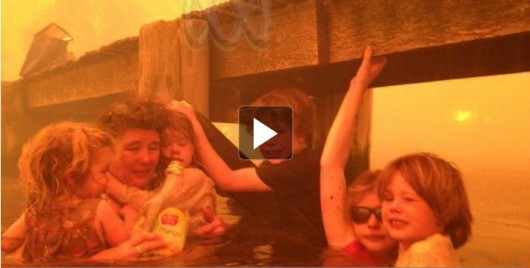 Video: Dunalley family’s amazing story of survival (ABC 7.30 Report)
(Click image to replay ABC News report) Video: Dunalley family’s amazing story of survival (ABC 7.30 Report)
(Click image to replay ABC News report)
.
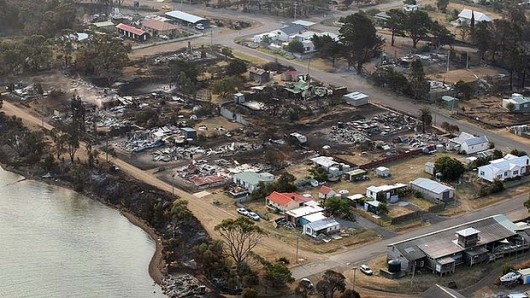 65 homes lost in Dunalley, and others lost in nearby Boomer Bay and Copping 65 homes lost in Dunalley, and others lost in nearby Boomer Bay and Copping
.
Tags: Boomer Bay, burn off, bushfire, Bushfire Defence Certificate, Copping, Denison Canal, Diurnal Wind, Dunalley Wharf, Emergency Evacation Centre, Erikson Aircrane, FFDI, Forcett Fire, High Temperatures, Hobart Airport, Inala Road, McArthur Forest Fire Danger Index, old fire in a burnt out tree stump, pile burn, prevailing wind, Tasmania, Tasmanian Fire Service, TFS, Wind Rose
Posted in Tasmania (AU), Threats from Bushfire | Comments Off on Tasmania’s Forcett Fire 2013 – 16 questions
Add this post to Del.icio.us - Digg
|
|
 For the cause and their honour
Camp Flozza remembered
For the cause and their honour
Camp Flozza remembered
 Tasmanian police escort a log truck out of the Upper Florentine Valley after a week of protests, January 2009.
[Source: ‘Protests have failed to stop the log trucks’, 20090121, ABC News,
^http://www.abc.net.au/news/2009-01-21/tasmanian-police-escort-a-log-truck-out-of-the/273180]
Tasmanian police escort a log truck out of the Upper Florentine Valley after a week of protests, January 2009.
[Source: ‘Protests have failed to stop the log trucks’, 20090121, ABC News,
^http://www.abc.net.au/news/2009-01-21/tasmanian-police-escort-a-log-truck-out-of-the/273180]
 Does young Will mean blood?
Does young Will mean blood? Sacred Upper Florentine Valley being logged only a few years ago
Sacred Upper Florentine Valley being logged only a few years ago





















































































































